1. The Rise of Peer-to-Peer Lending Platforms
In addition to automated lending by traditional financial institutions, another significant trend in the lending industry is the rise of peer-to-peer (P2P) lending platforms. P2P lending platforms connect borrowers directly with individual lenders or investors, bypassing traditional financial intermediaries. Here's a closer look at P2P lending:
1. Direct Borrower-Lender Connection: P2P lending platforms enable borrowers to access funds directly from individual lenders or investors, cutting out the middleman. This can result in lower borrowing costs, as lenders may offer more competitive interest rates compared to traditional lenders.
2. Access to Funding for Underrepresented Borrowers: P2P lending platforms have opened up lending opportunities for individuals and businesses that may have difficulty accessing credit through traditional means. For example, borrowers with limited credit history or non-traditional income sources may find it easier to secure funding through P2P lending.
3. Diversification of Investment Opportunities: P2P lending platforms provide individual investors with an alternative investment avenue. Investors can diversify their portfolios by lending to multiple borrowers and earn interest income on their investments. P2P lending platforms often offer tools and analytics to help investors assess the creditworthiness of borrowers and manage their investment portfolios.
4. Challenges and Regulatory Considerations: P2P lending is subject to regulatory considerations, as it involves lending activities outside the traditional banking system. Regulatory bodies around the world are developing frameworks to ensure consumer protection, fair lending practices, and risk management in the P2P lending industry.
P2P lending, combined with automation and AI, presents an exciting opportunity for individuals and businesses to access funding and investors to earn attractive returns. However, borrowers and investors should carefully evaluate the risks and opportunities associated with P2P lending and ensure they understand the platform's terms and conditions before participating.

The Rise of Peer to Peer Lending Platforms - A look into the future of automated lending
2. The Rise of Peer-to-Peer Transactions
1. The rise of Peer-to-peer Transactions
In recent years, the world of finance has witnessed a remarkable shift towards peer-to-peer (P2P) transactions. This new form of digital exchange has gained significant popularity due to its convenience, security, and cost-effectiveness. Peer-to-peer transactions allow individuals to directly transfer funds or assets to one another without the need for intermediaries such as banks or payment processors. Let's delve into the reasons behind the rise of P2P transactions and explore some examples and tips for seamless peer-to-peer exchanges.
2. Advantages of Peer-to-Peer Transactions
One of the primary reasons for the surge in P2P transactions is the elimination of intermediaries. traditional banking systems often involve multiple parties, resulting in delays, high fees, and potential privacy concerns. P2P transactions cut out these intermediaries, enabling faster and more cost-effective transfers. Moreover, the decentralized nature of P2P transactions ensures greater security, as there is no single point of failure vulnerable to cyberattacks or data breaches.
3. Examples of P2P Transaction Platforms
Several platforms have emerged to facilitate seamless peer-to-peer transactions. One notable example is PayPal, which allows users to send and receive money directly from their bank accounts or credit cards. Another popular platform is Venmo, which focuses on social payments and allows users to split bills or pay friends effortlessly. Cryptocurrency platforms like Bitcoin and Ethereum also operate on a P2P basis, enabling users to transfer digital currencies without intermediaries.
4. Tips for Successful P2P Transactions
When engaging in P2P transactions, it is essential to prioritize security and protect your personal information. Ensure that you are using a trusted platform with robust encryption and authentication measures. Additionally, it is advisable to thoroughly research the reputation of the person or entity you are transacting with to minimize the risk of fraud. Utilizing escrow services or third-party dispute resolution mechanisms can also provide an extra layer of protection in case of any disputes.
5. Case Studies of P2P Transactions
One noteworthy case study of P2P transactions is the rise of decentralized finance (DeFi). DeFi platforms leverage blockchain technology to offer various financial services without intermediaries, such as lending, borrowing, and earning interest on digital assets. These platforms, including Compound and Aave, have gained significant traction, highlighting the growing demand for P2P financial solutions.
Another case study involves the sharing economy, where P2P transactions play a pivotal role. Companies like Airbnb and Uber enable individuals to rent their homes or provide transportation services directly to others, bypassing traditional hospitality or taxi industries. This shift has revolutionized these sectors, providing individuals with new income opportunities and consumers with more choice and flexibility.
6. Conclusion
The rise of peer-to-peer transactions has transformed the way we exchange value and conduct financial transactions. The advantages offered by P2P transactions, such as reduced costs, increased security, and faster processing times, have made them a preferred choice for many individuals and businesses. As technology continues to advance, we can expect further innovation in the P2P space, leading to even more seamless and efficient transactions.
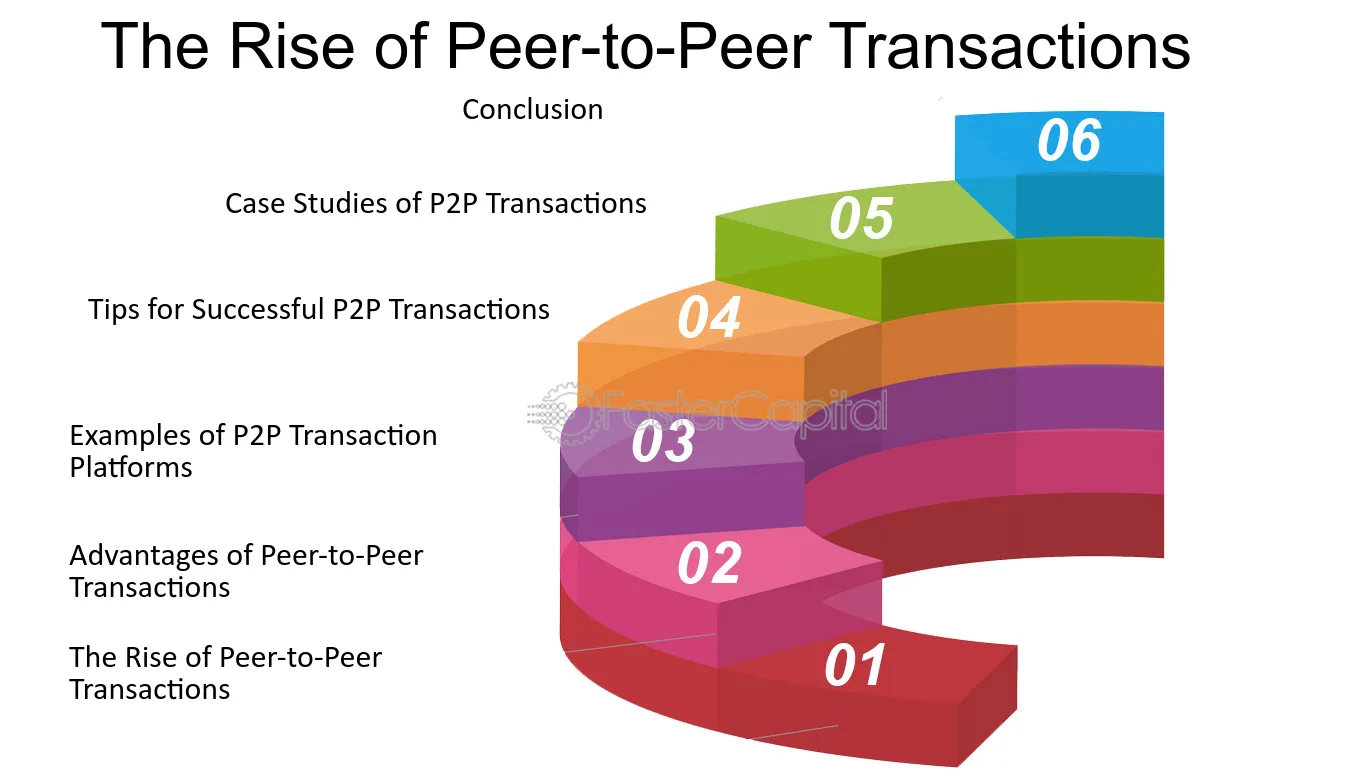
The Rise of Peer to Peer Transactions - Dark Wallet and Peer to Peer Transactions: A Seamless Connection
3. The Rise of Peer-to-Peer Mobile Lending Platforms
In addition to traditional mobile lending models offered by banks and financial institutions, the rise of peer-to-peer (P2P) lending platforms has further disrupted the lending landscape. P2P mobile lending platforms connect borrowers directly with individual lenders, eliminating the need for intermediaries such as banks.
P2P lending offers several advantages, including lower interest rates, faster approval processes, and more personalized borrowing experiences. These platforms leverage technology to facilitate loan transactions, establish trust between borrowers and lenders, and ensure timely repayments.
For instance, Sarah, a small business owner, needed funding to expand her operations. She decided to explore P2P lending platforms and found a lender who believed in her business vision. Through this direct connection, she was able to secure a loan at competitive rates, enabling her to scale her business successfully.
4. Angel Investors and the Rise of Peer-to-Peer Lending Platforms
In addition to traditional angel investments, angel investors are also playing a significant role in the rise of peer-to-peer lending platforms. Peer-to-peer (P2P) lending platforms connect borrowers directly with individual lenders, bypassing traditional financial intermediaries. Angel investors, with their experience and capital, are increasingly participating in P2P lending as lenders themselves. Here's how angel investors are shaping the P2P lending landscape:
Diversifying Investment Portfolios
Angel investors are attracted to P2P lending platforms as they offer an opportunity to diversify their investment portfolios. By lending directly to borrowers, angel investors can spread their risk across multiple borrowers and industries. This diversification strategy can help mitigate the risks associated with investing in startups and early-stage businesses, where the failure rate can be relatively high.
Access to High-Yield Investments
P2P lending platforms often offer higher interest rates compared to traditional savings accounts or fixed-income investments. Angel investors, seeking higher returns on their investments, are drawn to these platforms as they provide an opportunity to earn attractive yields on their capital. This can be particularly appealing in a low-interest-rate environment, where traditional investment options may offer limited returns.
Empowering Borrowers
P2P lending platforms empower borrowers by providing them with an alternative source of financing outside of the traditional banking system. By connecting borrowers directly with lenders, these platforms offer more flexible terms, faster approval processes, and a higher likelihood of approval for borrowers who may not meet the strict criteria of traditional lenders. This democratization of lending is made possible by the participation of angel investors and other individual lenders.
Facilitating Direct Investor-Borrower Relationships
Angel investors participating in P2P lending platforms have the opportunity to establish direct relationships with borrowers. This direct interaction allows investors to gain a deeper understanding of the borrower's business, industry, and growth potential. It also offers the potential for ongoing communication, feedback, and collaboration between the investor and borrower, which can lead to more fruitful partnerships.
Generate leads with content marketing
Our experts work on improving your content marketing to increase your traffic and conversion rates
5. The Rise of Peer-to-Peer Automated Lending Platforms
In addition to traditional lending institutions, peer-to-peer (P2P) lending platforms have gained prominence in the automated lending space. P2P lending connects borrowers directly with individual lenders or groups of investors, bypassing traditional financial intermediaries. Here's why P2P lending has experienced significant growth:
1. Access to capital: P2P lending platforms provide borrowers with an alternative source of funding, particularly for those who may not qualify for loans from traditional lenders. This expands access to capital for individuals and small businesses.
2. Competitive interest rates: P2P lending platforms often offer competitive interest rates compared to traditional lenders. This is because P2P lending eliminates some of the operational costs associated with traditional financial intermediaries.
3. Diverse loan options: P2P lending platforms offer a wide range of loan options, catering to various borrower needs, including personal loans, business loans, student loans, and more.
4. Investment opportunities: P2P lending also provides individuals with an opportunity to invest in loans and earn attractive returns. Investors can diversify their portfolios by lending to multiple borrowers and managing risk accordingly.
5. Transparency and trust: P2P lending platforms prioritize transparency, providing borrowers and investors with detailed loan information, borrower profiles, and loan performance data. This fosters trust and confidence in the lending process.
The rise of P2P automated lending platforms has democratized lending, offering borrowers and investors more choices, flexibility, and transparency in the loan marketplace.
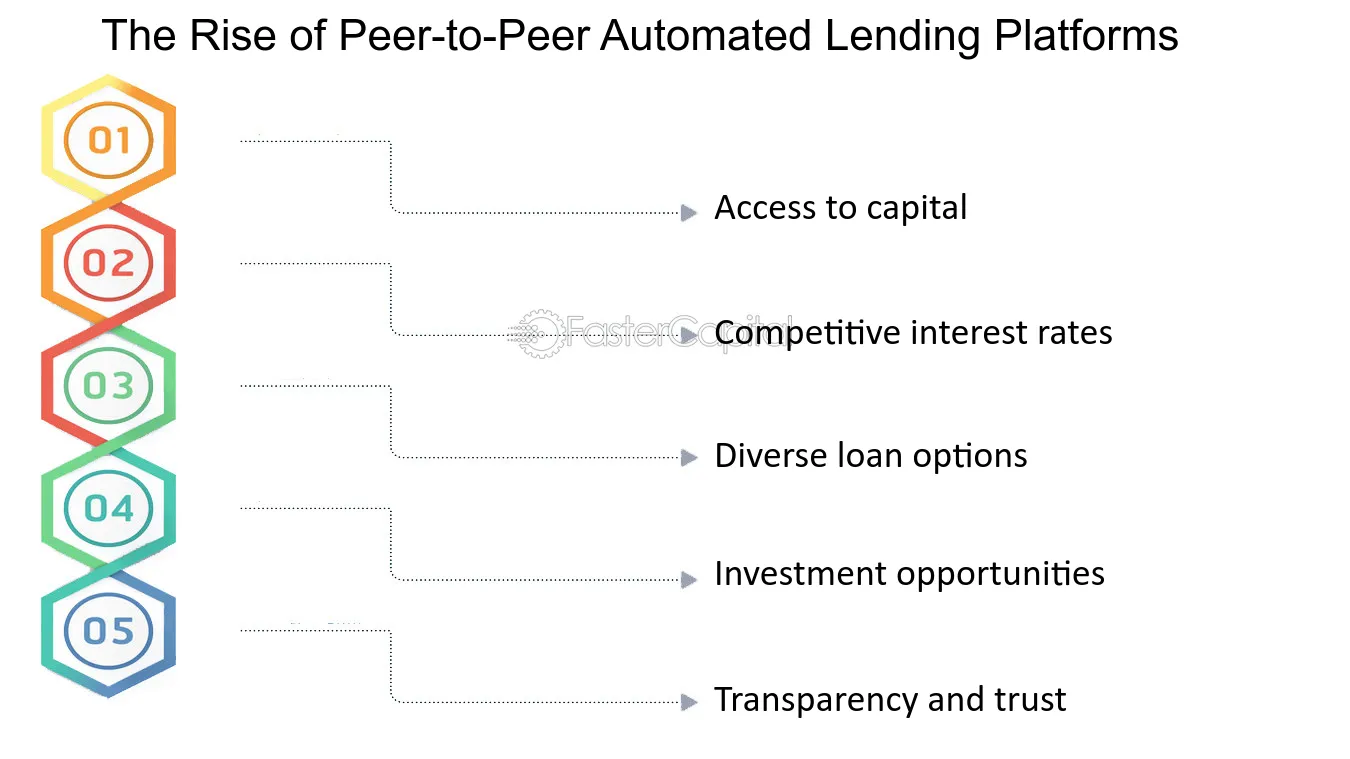
The Rise of Peer to Peer Automated Lending Platforms - How automated lending is revolutionizing the loan approval process
6. Explore the Opportunities Offered by Peer-to-Peer Lending Startups:Introduction: The Rise of Peer-to-Peer Lending Startups
1. The Origins of Peer-to-Peer Lending
Peer-to-peer lending, also known as P2P lending, is a form of lending that directly connects borrowers with lenders through online platforms, cutting out the traditional intermediaries like banks. This innovative model has gained significant popularity in recent years, offering an alternative investment opportunity for both individuals and institutional investors.
2. The Disruptive Power of P2P Lending Startups
P2P lending startups have emerged as disruptors in the financial industry, challenging the traditional lending landscape. These platforms leverage technology to bring together borrowers and lenders, creating a more efficient and inclusive lending ecosystem.
3. Benefits for Borrowers
One of the primary advantages of P2P lending for borrowers is the potential for lower interest rates compared to traditional lenders. By eliminating the need for a middleman, P2P lending platforms can offer more competitive rates, making it an attractive option for individuals seeking funding for various purposes such as personal loans, debt consolidation, or small business financing.
For instance, imagine a small business owner who needs capital to expand operations. Instead of approaching a traditional bank, which may have stringent lending criteria and lengthy approval processes, the business owner can turn to a P2P lending platform. These platforms often have a streamlined application process and can provide faster funding decisions, allowing the business owner to seize opportunities without delay.
4. Opportunities for Lenders
P2P lending startups also present an exciting opportunity for individuals looking to diversify their investment portfolios. Lenders on these platforms can allocate their funds across a range of loans, spreading their risk and potentially earning higher returns compared to traditional investment options.
For example, let's say an investor has spare capital that they would like to invest to generate passive income. Instead of opting for traditional investments like stocks or bonds, they can consider becoming a lender on a P2P lending platform. By spreading their investment across multiple loans, they can potentially earn regular interest payments and even achieve higher returns compared to other investment avenues.
5. The Role of Technology in P2P Lending
The success of peer-to-peer lending startups can be attributed to the innovative use of technology. These platforms employ sophisticated algorithms and data analytics to assess borrowers' creditworthiness and determine appropriate interest rates.
By leveraging technology, P2P lending platforms can make more accurate lending decisions, reducing the risk of default for lenders. Additionally, the use of online platforms enables quick and seamless communication between borrowers and lenders, enhancing transparency and accessibility.
6. The Future of P2P Lending Startups
As P2P lending continues to gain traction, we can expect further innovation and expansion in this sector. With advancements in artificial intelligence and blockchain technology, P2P lending platforms may become even more efficient, secure, and accessible in the future.
In conclusion, peer-to-peer lending startups have revolutionized the lending industry, providing borrowers with alternative financing options and offering lenders an opportunity to diversify their investment portfolios. With the power of technology and the potential for higher returns, P2P lending is poised to reshape the way individuals and businesses access funding and invest their money.
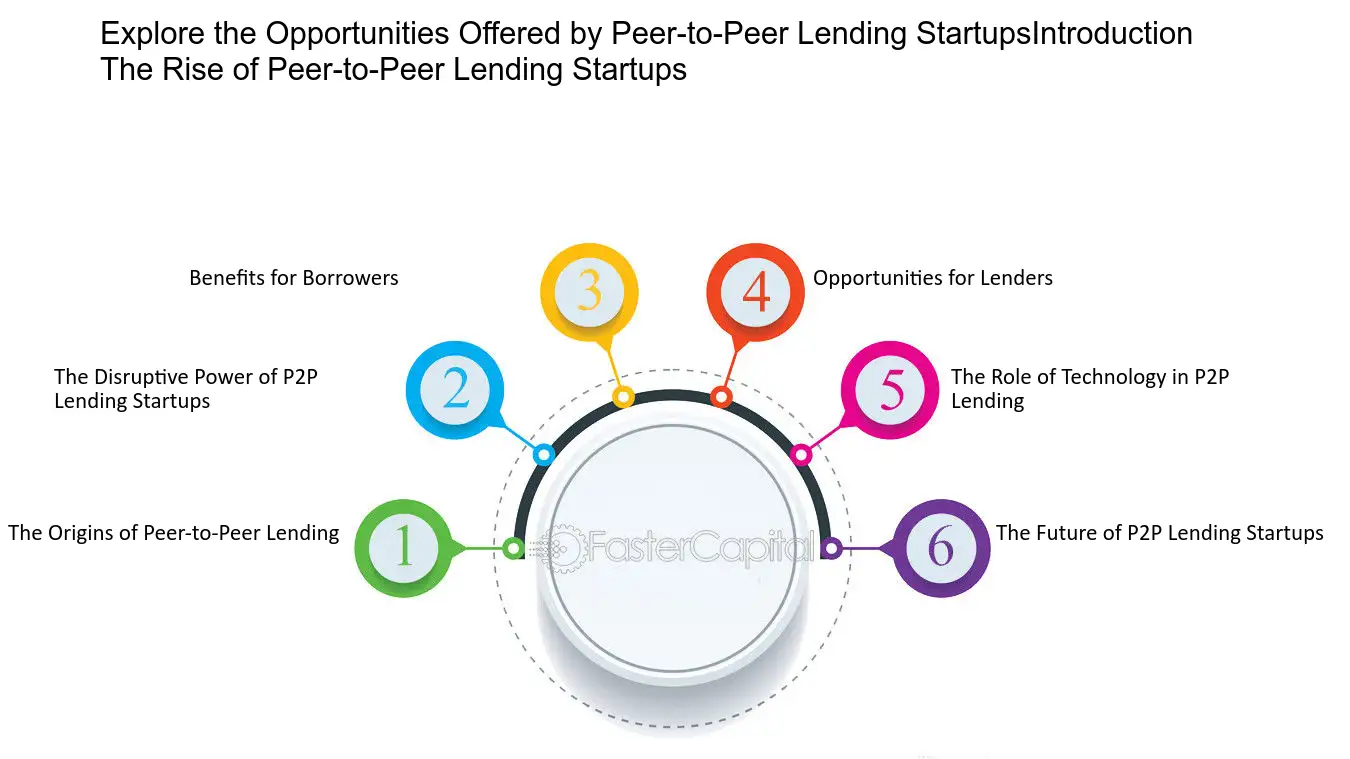
Explore the Opportunities Offered by Peer to Peer Lending Startups:Introduction: The Rise of Peer to Peer Lending Startups - Next Level Investing: Explore the Opportunities Offered by Peer to Peer Lending Startups
7. Exploring the Rise of Peer-to-Peer Lending
Peer-to-peer lending has emerged as a game-changer in the world of finance, revolutionizing the way individuals and businesses borrow and lend money. This innovative approach allows borrowers to connect directly with lenders, cutting out traditional financial institutions and their associated fees and restrictions. As a result, peer-to-peer lending has gained popularity among the active bond crowd, offering a new avenue for investment and diversification.
1. Understanding Peer-to-Peer Lending: Peer-to-peer lending, also known as P2P lending, is a method of borrowing and lending money through an online platform. Unlike traditional lending, which involves financial intermediaries such as banks, peer-to-peer lending connects borrowers and lenders directly. This direct connection enables borrowers to secure loans at competitive interest rates, while lenders can earn attractive returns on their investments. P2P lending platforms act as facilitators, providing the necessary infrastructure for borrowers and lenders to interact and transact.
2. Benefits for Borrowers: Peer-to-peer lending offers several advantages for borrowers. Firstly, it provides an alternative source of funding for individuals or businesses who may have difficulty obtaining loans from traditional financial institutions due to strict requirements or lack of credit history. Additionally, P2P lending often offers more flexible terms, allowing borrowers to negotiate interest rates and repayment schedules that suit their needs. Moreover, the streamlined application and approval process of P2P lending platforms make it faster and more convenient for borrowers to access the funds they require.
3. Benefits for Lenders: From the perspective of lenders, peer-to-peer lending presents an opportunity to earn attractive returns on their investments. By cutting out intermediaries, lenders can bypass the low-interest rates typically offered by banks and other financial institutions. Instead, they can lend directly to borrowers and earn higher interest rates, potentially enhancing their investment portfolios. Furthermore, P2P lending allows lenders to diversify their investments across multiple loans, reducing the risk associated with any single borrower defaulting.
4. Risks and Challenges: While peer-to-peer lending offers numerous benefits, it is important to consider the risks involved. One significant risk is the potential for borrower default, which can lead to a loss of principal for lenders. To mitigate this risk, it is crucial for lenders to assess the creditworthiness of borrowers before making any investments. P2P lending platforms typically provide credit scores and other relevant information about borrowers to assist lenders in making informed decisions. Additionally, lenders should diversify their investments across multiple loans to minimize the impact of any single default.
5. Comparison with Traditional Investments: When comparing peer-to-peer lending with traditional investment options, such as bonds or stocks, it is essential to evaluate the potential returns and risks. While bonds offer fixed interest rates, P2P lending can provide higher returns, especially when lending to borrowers with good credit histories. However, P2P lending is not without risks, as borrower default can lead to loss of principal. On the other hand, stocks offer the potential for higher returns but also come with higher volatility. Ultimately, the best option depends on an individual's risk tolerance and investment goals.
Peer-to-peer lending has emerged as a game-changer in the financial world, offering borrowers an alternative source of funding and lenders an opportunity for attractive returns. By connecting borrowers and lenders directly, P2P lending platforms revolutionize the traditional lending process, providing greater accessibility, flexibility, and diversification. However, it is crucial for both borrowers and lenders to evaluate the risks involved and make informed decisions to maximize the benefits of this innovative approach to finance.
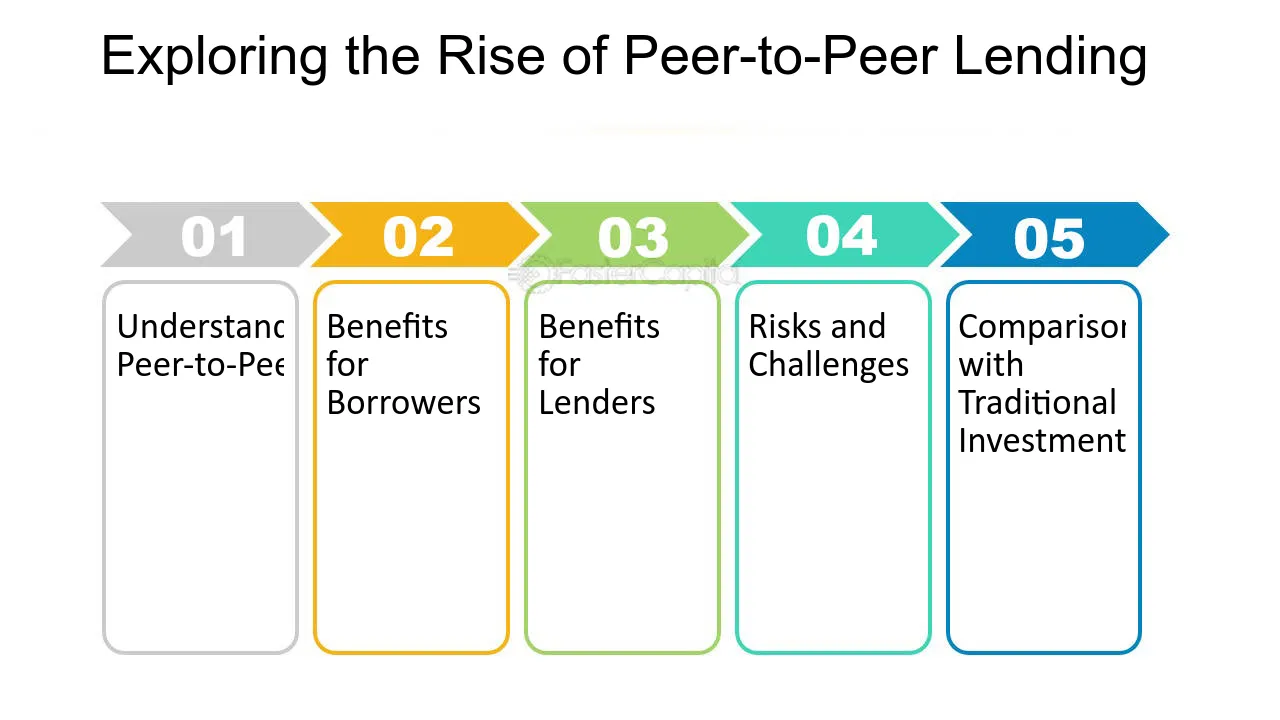
Exploring the Rise of Peer to Peer Lending - Peer to Peer Lending: A Game Changer for the Active Bond Crowd
8. The Rise of Peer-to-Peer Lending
Peer-to-peer lending, also known as P2P lending, has emerged as a game-changer in the world of microinvesting. This innovative form of lending allows individuals to lend money directly to borrowers without the need for traditional financial intermediaries such as banks. With the rise of technology and the increasing popularity of online platforms, peer-to-peer lending has gained significant traction in recent years. This section will delve into the introduction of peer-to-peer lending, exploring its origins, benefits, and potential drawbacks.
1. Origins of Peer-to-Peer Lending: Peer-to-peer lending first gained prominence in the early 2000s, with platforms like Zopa and Prosper leading the way. These platforms aimed to disrupt the traditional lending landscape by connecting borrowers and lenders directly, eliminating the need for banks and other financial institutions. Initially, peer-to-peer lending was primarily focused on personal loans, providing individuals with an alternative to traditional bank loans. However, the concept has since expanded to include various types of lending, including business loans, student loans, and even real estate financing.
2. benefits of Peer-to-Peer lending: One of the key advantages of peer-to-peer lending is its potential for higher returns compared to traditional savings accounts or bonds. Lenders can earn attractive interest rates by lending their money directly to borrowers, bypassing the low-interest rates offered by banks. Additionally, P2P lending provides borrowers with an alternative financing option, especially for those who may not qualify for loans from traditional financial institutions due to credit history or other factors. This democratization of lending allows individuals to access funds for various purposes, from debt consolidation to business expansion.
3. Risks and Drawbacks: While peer-to-peer lending comes with its benefits, it is essential to consider the associated risks. One of the main risks is the potential for default by borrowers. Unlike traditional banks, P2P lending platforms do not provide a guarantee on the repayment of loans. Lenders bear the risk of losing their investment if borrowers default on their payments. It is crucial for lenders to diversify their investments across multiple loans to mitigate this risk. Furthermore, the lack of regulation in some jurisdictions can pose challenges, as there may be limited recourse for lenders in case of disputes or fraudulent activities.
4. Comparison with Traditional Lending: When comparing peer-to-peer lending with traditional lending, several factors come into play. Traditional banks offer a sense of security and stability, with established lending practices and customer trust. However, they often have stringent eligibility criteria and lengthy approval processes. On the other hand, P2P lending platforms offer more flexibility, faster approval times, and potentially higher returns. It is important for individuals to assess their risk appetite, investment goals, and the specific terms and conditions offered by different lenders or platforms before making a decision.
5. Best Option for Microinvesting: For microinvesting, where individuals typically invest smaller amounts, peer-to-peer lending can be an attractive option. The ability to diversify investments across multiple loans allows for risk mitigation. Additionally, the potential for higher returns compared to traditional savings accounts or bonds can make P2P lending an appealing choice for those looking to grow their wealth over time. However, it is crucial to conduct thorough due diligence on the platform or lender, assess the creditworthiness of borrowers, and monitor the investments regularly to ensure a balanced and successful microinvestment strategy.
The rise of peer-to-peer lending has revolutionized the lending landscape, providing individuals with an alternative means of borrowing and investing. With its origins in the early 2000s, P2P lending has expanded to encompass various loan types and has gained popularity due to its potential for higher returns and flexibility. However, it is important to consider the associated risks and compare P2P lending with traditional lending options before making investment decisions. Peer-to-peer lending can be a game-changer for microinvesting, offering individuals the opportunity to grow their wealth and support borrowers directly.
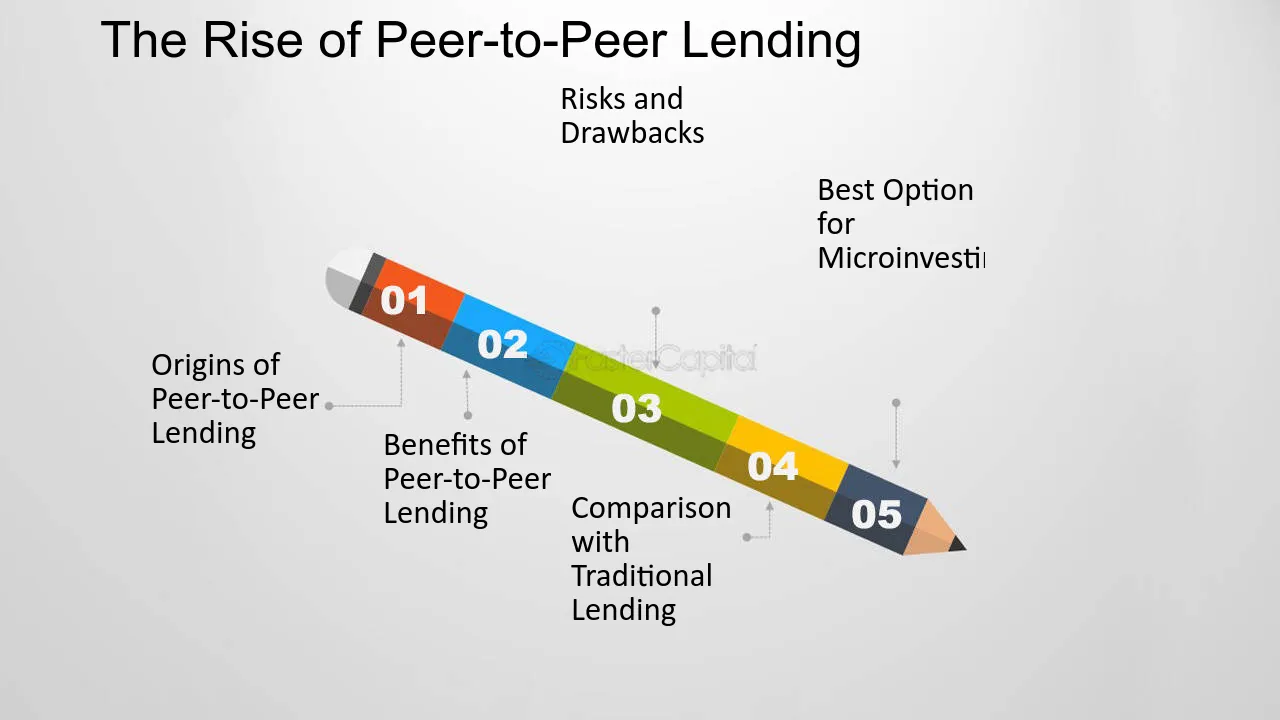
The Rise of Peer to Peer Lending - Peer to Peer Lending: A Microinvesting Game Changer
9. The Rise of Peer-to-Peer Lending
The rise of peer-to-peer lending has been a game-changer in the world of finance, disrupting traditional financial institutions and revolutionizing the way individuals and businesses borrow and lend money. This section will delve into the various aspects of this phenomenon, exploring its origins, benefits, challenges, and future prospects.
1. Origins: peer-to-peer lending, also known as P2P lending or marketplace lending, emerged in the early 2000s as an alternative to traditional banking systems. It gained traction during the global financial crisis of 2008 when banks tightened their lending criteria, leaving many borrowers without access to credit. P2P lending platforms filled this gap by connecting borrowers directly with individual lenders through online marketplaces.
2. Benefits for Borrowers: One of the key advantages of peer-to-peer lending is its accessibility. Traditional banks often have stringent requirements that exclude certain individuals or businesses from obtaining loans. P2P lending platforms offer a more inclusive approach, allowing borrowers with varying credit profiles to access funds at competitive interest rates. Additionally, the streamlined online application process and faster approval times make it an attractive option for those in need of quick financing.
For example, Jane, a small business owner with a limited credit history, struggled to secure a loan from traditional banks due to their risk aversion. However, she found success on a P2P lending platform where investors were willing to fund her business based on its potential rather than solely relying on her credit score.
3. Benefits for Lenders: Peer-to-peer lending also presents unique opportunities for individuals looking to invest their money. By cutting out intermediaries like banks, lenders can earn higher returns on their investments compared to traditional savings accounts or bonds. P2P platforms allow lenders to diversify their portfolios by spreading their investments across multiple borrowers with varying risk profiles.
For instance, John had some extra savings sitting idle in his bank account earning minimal interest. He decided to allocate a portion of his funds to P2P lending, where he could earn higher returns by lending directly to borrowers. By diversifying his investments across multiple loans, John minimized the risk associated with any single borrower defaulting.
4. Challenges and Risks: While peer-to-peer lending offers numerous benefits, it is not without its challenges. One of the primary concerns for lenders is the risk of borrower default. Unlike banks, P2P platforms do not have the same level of resources to conduct extensive credit checks or collateral assessments. Therefore, lenders must carefully evaluate borrowers' profiles and assess
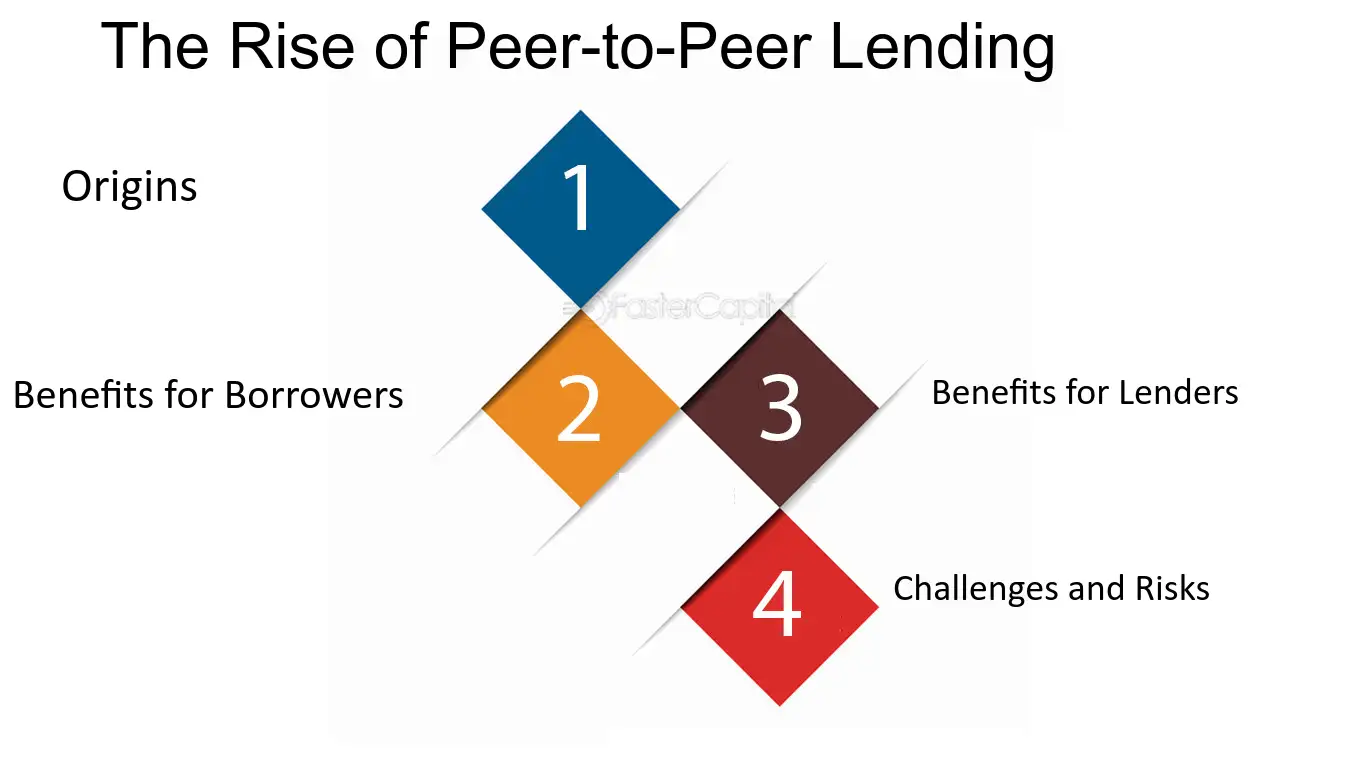
The Rise of Peer to Peer Lending - Peer to Peer Lending: Disrupting Traditional Financial Innovation
10. The Rise of Peer-to-Peer Lending Platforms
Peer-to-peer lending platforms have become a popular way for people to invest their money and earn a return. These platforms allow individuals to lend money directly to other individuals or businesses, cutting out traditional financial institutions. This has created a new avenue for yield-earning assets, as investors can earn a higher return than they would with traditional savings accounts or bonds. In this section, we will explore the rise of peer-to-peer lending platforms and how they have changed the way people invest their money.
1. The growth of Peer-to-peer Lending Platforms
Peer-to-peer lending platforms have experienced significant growth in recent years. According to Statista, the global peer-to-peer lending market was valued at $67.9 billion in 2020 and is projected to reach $558.9 billion by 2027. This growth can be attributed to several factors, including the increasing use of technology, the desire for higher returns, and the dissatisfaction with traditional financial institutions.
2. The benefits of Peer-to-peer Lending
One of the main benefits of peer-to-peer lending is the potential for higher returns. Investors can earn anywhere from 5% to 15% on their investments, depending on the platform and the risk level of the loans. Another benefit is the ability to diversify one's portfolio. By investing in multiple loans, investors can spread their risk and potentially earn a higher return. Additionally, peer-to-peer lending platforms offer a more streamlined and transparent investment process, with lower fees than traditional financial institutions.
3. The Risks of Peer-to-Peer Lending
While there are benefits to peer-to-peer lending, there are also risks involved. One of the main risks is the potential for default. If a borrower is unable to repay the loan, the investor may lose their money. Another risk is the lack of regulation in some countries, which can lead to fraudulent activity. Additionally, peer-to-peer lending is not covered by deposit insurance, so investors may not be protected in the event of a platform failure.
4. Choosing the Right Platform
When choosing a peer-to-peer lending platform, it is important to consider several factors. These include the platform's track record, the types of loans offered, the risk level of the loans, and the fees charged. It is also important to consider the platform's level of regulation and the protections offered to investors. Some popular peer-to-peer lending platforms include LendingClub, Prosper, and Zopa.
5. Comparing peer-to-Peer Lending to Other investment Options
Peer-to-peer lending is just one option for investors looking to earn a return. Other options include stocks, bonds, and real estate. Each option has its own risks and potential rewards, so it is important to carefully consider each one before making an investment decision. For example, while stocks offer the potential for high returns, they also come with a higher level of risk. Bonds, on the other hand, offer a lower potential return but are generally considered a safer investment.
Peer-to-peer lending platforms have emerged as a popular way for investors to earn a higher return on their investments. While there are risks involved, there are also potential benefits, including higher returns and a more streamlined investment process. When choosing a platform, it is important to carefully consider the risks and rewards, as well as the platform's track record and regulatory protections. Ultimately, the best investment option will depend on an individual's risk tolerance, investment goals, and personal circumstances.
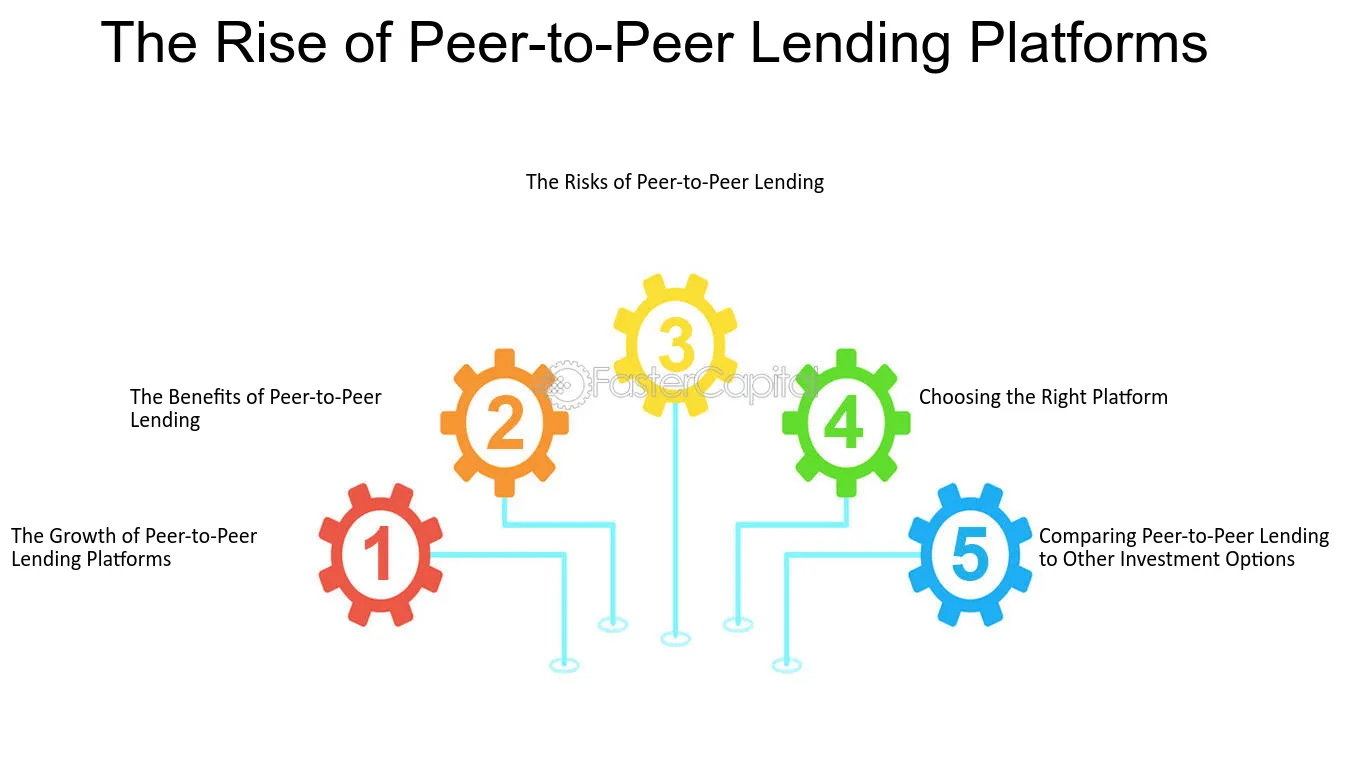
The Rise of Peer to Peer Lending Platforms - Peer to Peer Lending: Exploring New Avenues for Yield Earning Assets
11. The Rise of Peer-to-Peer Lending
In recent years, peer-to-peer (P2P) lending has emerged as a popular alternative to traditional banking. The basic idea behind P2P lending is that individual investors can lend money to individuals or small businesses through an online platform, bypassing the need for a traditional bank. This type of lending has been growing in popularity since the global financial crisis, as many people lost faith in the traditional banking system and sought out new ways of investing their money.
From the borrower's point of view, P2P lending can be an attractive option because it offers relatively low interest rates and flexible repayment terms. For investors, P2P lending can be an opportunity to earn a higher return on their money than they might get from more traditional investments like stocks or bonds.
Here are some key points to understand about the rise of P2P lending:
1. Disruption of traditional banking: P2P lending is seen as a major disruption to the traditional banking industry because it eliminates the need for a middleman. Without a bank acting as an intermediary, borrowers can often get lower interest rates, while lenders can earn higher returns.
2. Risk management: P2P lending platforms typically use sophisticated algorithms to assess the creditworthiness of borrowers and assign them a risk rating. This helps to mitigate the risk of default for investors.
3. Access to credit: P2P lending has the potential to provide access to credit for individuals and small businesses that might not be able to get loans from traditional banks. This is particularly true for borrowers with less-than-perfect credit scores.
4. Transparency: P2P lending platforms are typically very transparent about the fees and interest rates involved in each loan. This can be a welcome change for borrowers who are used to dealing with banks that often have hidden fees and charges.
5. Regulation: As P2P lending has grown in popularity, governments around the world have started to regulate the industry more closely. This is meant to protect both borrowers and investors and ensure that the industry operates in a fair and transparent manner.
Overall, the rise of P2P lending represents a major shift in the way that people think about borrowing and investing. While it is still a relatively new industry, it has already had a significant impact on the financial services sector and is likely to continue to grow in popularity in the years to come.
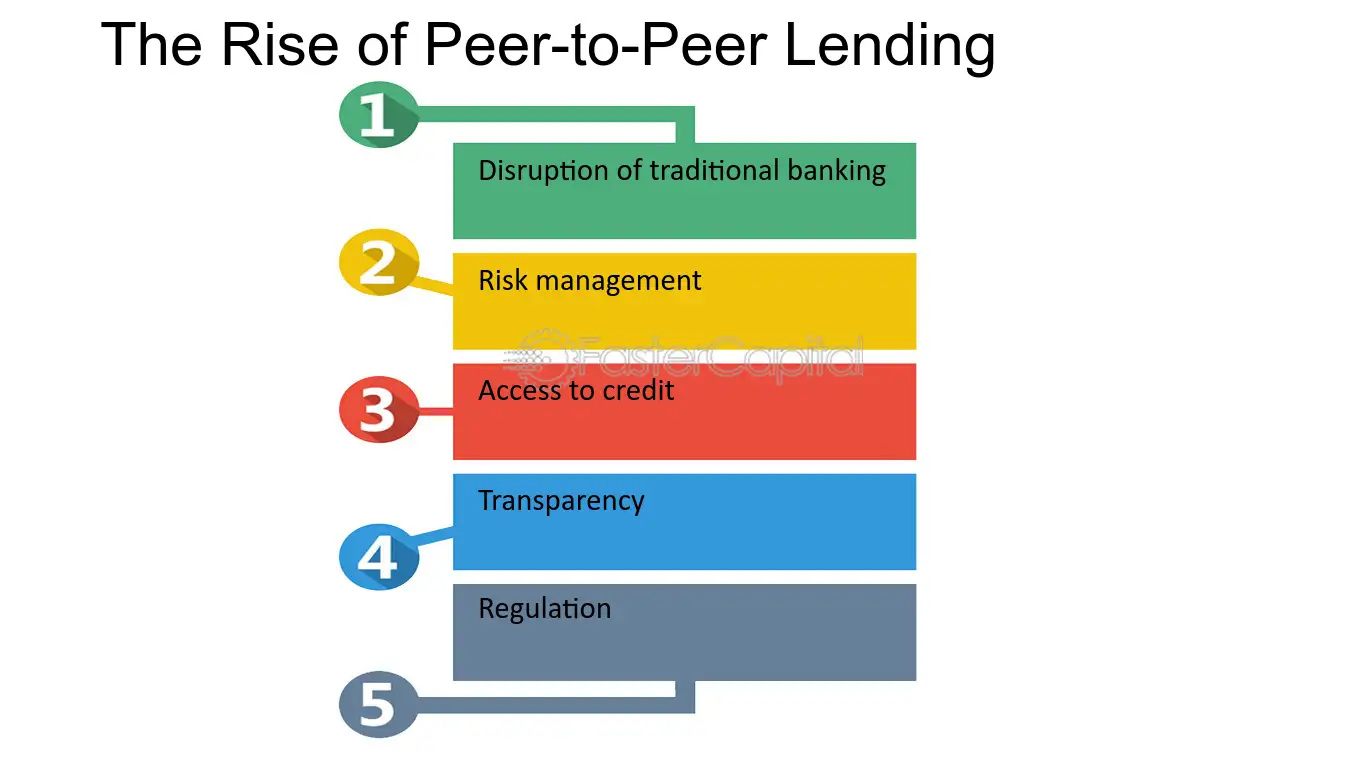
The Rise of Peer to Peer Lending - Peer to Peer Lending: Fintech s Disruption of Traditional Banking
12. The Rise of Peer-to-Peer Lending Platforms
The financial industry has witnessed a significant shift in recent years with the rise of peer-to-peer lending platforms. These platforms have revolutionized the way people borrow and invest money, offering an alternative to traditional banks and financial institutions. Peer-to-peer lending, also known as P2P lending, connects borrowers directly with individual investors, cutting out the intermediaries and reducing costs for both parties involved. This innovative approach has gained popularity due to its accessibility, transparency, and potential for higher returns.
1. Disintermediation: One of the key advantages of peer-to-peer lending platforms is the elimination of intermediaries such as banks. In traditional lending, banks act as middlemen, taking deposits from savers and lending them out to borrowers at a higher interest rate. However, peer-to-peer lending platforms directly match borrowers with investors, bypassing the need for a traditional financial institution. This disintermediation not only reduces costs but also allows borrowers to access loans at potentially lower interest rates, while investors can earn higher returns compared to traditional savings accounts.
For example, let's consider a small business owner who needs a loan to expand their operations. Instead of approaching a bank and going through a lengthy approval process, they can simply create a profile on a peer-to-peer lending platform and submit their loan request. Investors on the platform can then review the borrower's profile, financial information, and loan details before deciding whether to fund the loan. This direct connection between borrowers and investors streamlines the lending process, making it faster and more efficient.
2. diversification of Investment portfolio: Peer-to-peer lending platforms offer individual investors an opportunity to diversify their investment portfolio beyond traditional asset classes such as stocks and bonds. By investing in loans originated through these platforms, investors can earn interest income that is often higher than other fixed-income investments. This diversification can help investors reduce risk by spreading their investments across multiple borrowers and loan types.
For instance, an investor with a moderate risk tolerance may choose to allocate a portion of their portfolio to peer-to-peer lending. They can invest in a diverse range of loans, including personal loans, small business loans, or even loans for specific purposes like education or medical expenses. This diversification strategy helps mitigate the impact of any defaults or late payments by borrowers, as the investor's overall portfolio is not solely dependent on the performance of a single loan.
3. Access to Credit for Underserved Borrowers: Peer-to-peer lending platforms have also opened up new avenues for borrowers who may be underserved by traditional banks. In many cases, individuals or small businesses with less-than-perfect credit histories struggle to secure loans from traditional lenders due to stringent credit requirements. However, peer-to-peer lending platforms often consider additional factors beyond credit scores when assessing loan applications, such as the borrower's income, employment history, and purpose of the loan.
Consider a recent college graduate who wants to start a business but lacks the credit history to secure a loan from a bank. By turning to a peer-to-peer lending platform, they have a better chance of obtaining the necessary funds. The platform's algorithm takes into account various data points, including the borrower's education, skills, and business plan, to assess their creditworthiness. This inclusive approach provides opportunities for borrowers who may have been overlooked by traditional lenders, promoting financial inclusion and economic growth.
4. Technological Advancements: Peer-to-peer lending platforms have leveraged technological advancements to streamline the lending process and enhance user experience. These platforms utilize sophisticated algorithms and data analytics to match borrowers with investors based on their preferences and risk profiles. Additionally, they offer user-friendly interfaces, allowing borrowers to easily create loan requests and investors to browse and select loans to fund.
For example, a borrower can create a loan listing on a peer-to-peer lending platform, providing details about the loan amount, purpose, and interest rate they are willing to pay. The platform's algorithm then matches the loan listing with investors who meet the specified criteria. This technology-driven approach reduces the time and effort required for both borrowers and investors, making the lending process more efficient and accessible to a wider audience.
The rise of peer-to-peer lending platforms has undoubtedly disrupted the traditional lending landscape. With their disintermediation benefits, diversification opportunities, increased access to credit, and technological advancements, these platforms are here to stay. As more individuals and businesses recognize the advantages of peer-to-peer lending, the industry will likely continue to grow, offering a viable alternative for borrowers and investors alike.
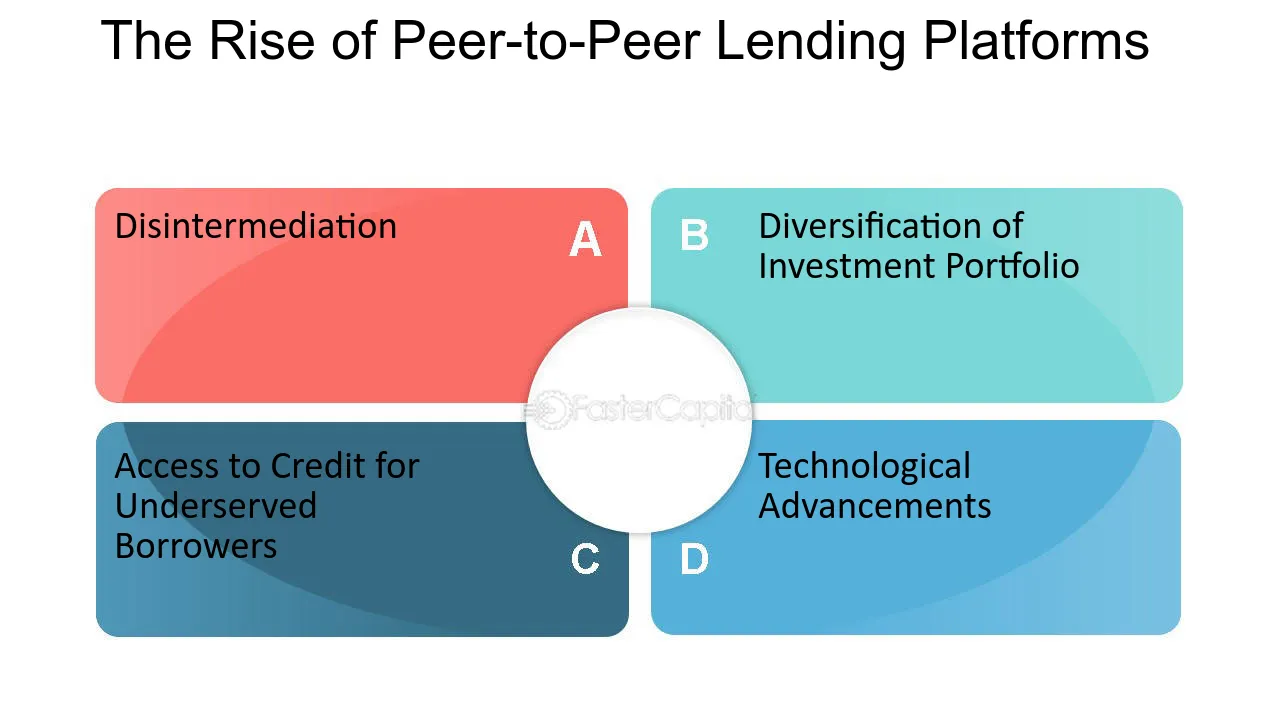
The Rise of Peer to Peer Lending Platforms - Peer to Peer Lending: The Future of Borrowing and Investing
13. The Rise of Peer-to-Peer Lending
The rise of peer-to-peer lending has been one of the most significant developments in the financial industry in recent years. This innovative approach to lending has disrupted the traditional banking sector and opened up new opportunities for both borrowers and investors. Peer-to-peer lending, also known as P2P lending, involves individuals lending money to other individuals or businesses through an online platform. Instead of going through a traditional bank, borrowers can access funds from a pool of investors, while investors can earn a return on their investment.
1. Benefits for Borrowers:
Peer-to-peer lending offers many benefits to borrowers. One advantage is that the interest rates are typically lower than those offered by traditional banks. This is because the P2P lending platform does not have the same overhead costs as a bank, so they can offer more competitive rates. Another benefit is that the application process is typically faster and more streamlined than traditional lending. Borrowers can apply online and receive a decision within a few days, compared to the weeks or months it can take to get approved for a bank loan. Additionally, P2P lending offers more flexibility in terms of loan amounts and repayment terms, making it easier for borrowers to find a loan that meets their needs.
2. Benefits for Investors:
Peer-to-peer lending also offers benefits to investors. One advantage is that investors can earn a higher return on their investment than they would with traditional savings accounts or bonds. P2P lending platforms typically offer returns of around 5-10%, which is higher than the average savings account interest rate. Another benefit is that investors can diversify their portfolio by investing in multiple loans. This spreads the risk and reduces the impact of any defaults. Finally, P2P lending platforms typically offer automated investing options, making it easy for investors to invest in loans that meet their criteria without having to manually select each loan.
3. Risks for Borrowers:
While P2P lending offers many benefits to borrowers, there are also risks to consider. One risk is that the interest rates can be higher than advertised if the borrower has a low credit score or a high risk of default. Additionally, some P2P lending platforms charge high fees, which can add to the overall cost of the loan. Finally, there is the risk of default, which can result in damage to the borrower's credit score and additional fees.
4. Risks for Investors:
There are also risks for investors to consider when investing in P2P loans. One risk is the potential for default, which can result in the loss of the investor's principal investment. Additionally, there is the risk of fraud or platform failure, which can result in the loss of all investments on the platform. Finally, there is the risk of liquidity, as P2P loans are typically not as liquid as other investments and may be difficult to sell quickly.
5. Comparing P2P Lending to Traditional Banking:
When considering P2P lending vs. Traditional banking, there are pros and cons to both options. Traditional banking offers the security and stability of a well-established institution, as well as access to a wider range of financial products and services. However, the application process can be lengthy and the interest rates may be higher. P2P lending offers more flexibility and faster approval times, as well as potentially lower interest rates. However, there is more risk involved and the loans may not be as secure as those offered by a traditional bank.
Overall, the rise of peer-to-peer lending has been a game-changer in the financial industry. While there are risks to consider, the benefits for both borrowers and investors are significant. As the industry continues to grow and evolve, it will be interesting to see how it continues to disrupt traditional banking and open up new opportunities for financial innovation.
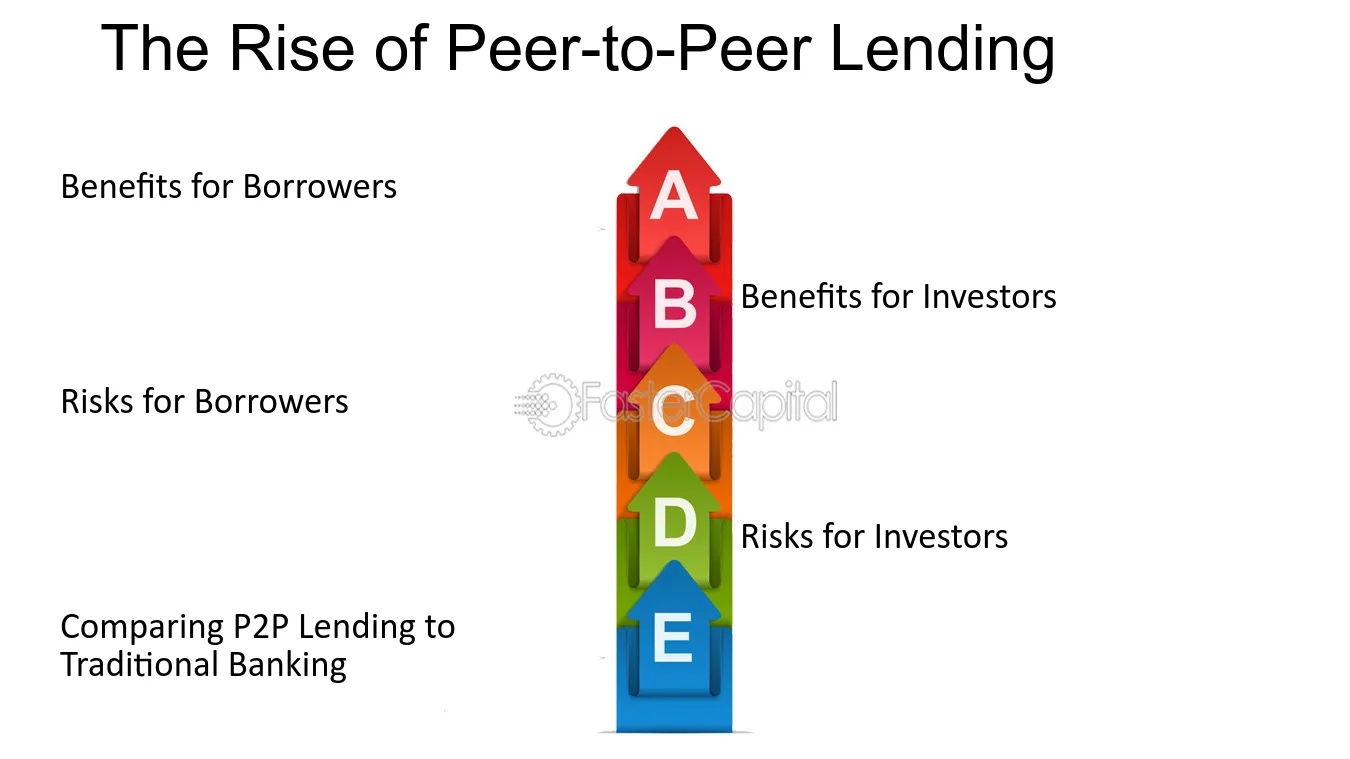
The Rise of Peer to Peer Lending - Peer to Peer Lending and Avalization: Modern Finance Fusion
14. The Rise of Peer-to-Peer Payment Apps
Peer-to-Peer payment apps are rapidly gaining popularity in today's digital age. With the rise of technology, more and more people are embracing the convenience of conducting financial transactions from the comfort of their homes. Peer-to-Peer payment apps are one of the most popular payment methods that have emerged in the last decade. These apps allow people to send and receive payments instantly and securely, without the need for cash or checks. In this section, we will explore the rise of Peer-to-peer payment apps and how they are changing the way we handle our finances.
1. The Emergence Of Peer-to-Peer Payment Apps
Peer-to-Peer payment apps have emerged as a result of the need for a fast, secure, and convenient way to send and receive payments. These apps have become increasingly popular due to their ease of use, low fees, and instant transaction processing. The emergence of Peer-to-Peer payment apps has disrupted the traditional banking system, making it easier for people to conduct transactions without having to visit a bank.
2. The benefits Of Peer-to-peer Payment Apps
Peer-to-Peer payment apps offer several benefits to users. First, they are fast and convenient, allowing users to send and receive payments instantly. Second, they are secure, with most apps using encryption and other security measures to protect users' financial information. Third, they are cost-effective, with most apps charging little to no fees for transactions. Finally, Peer-to-Peer payment apps are easy to use, with most apps offering a user-friendly interface that makes it easy for even novice users to conduct transactions.
3. The Different Types Of Peer-to-Peer Payment Apps
There are several different types of Peer-to-Peer payment apps, each with its own unique features and benefits. Some of the most popular Peer-to-Peer payment apps include PayPal, Venmo, Cash App, and Zelle. PayPal is one of the oldest and most well-known Peer-to-Peer payment apps, offering a wide range of features and services. Venmo is a popular app among millennials, offering a social media-like interface that allows users to share transactions with friends. Cash App is another popular app, offering a range of features including the ability to buy and sell Bitcoin. Zelle is a newer app that has gained popularity due to its integration with many of the major banks.
4. Comparing Peer-to-Peer Payment Apps
When comparing Peer-to-Peer payment apps, it is important to consider factors such as fees, security, ease of use, and available features. PayPal and Venmo are both popular choices, with Venmo offering a more social media-like experience. Cash App is a good choice for those looking to buy and sell Bitcoin, while Zelle is a good choice for those who want to use an app that is integrated with their bank. Ultimately, the best Peer-to-Peer payment app will depend on your individual needs and preferences.
Peer-to-Peer payment apps have revolutionized the way we handle our finances. With their ease of use, low fees, and instant transaction processing, these apps are quickly becoming a popular choice for people around the world. Whether you choose to use PayPal, Venmo, Cash App, or Zelle, the benefits of Peer-to-Peer payment apps are clear. As technology continues to evolve, we can expect to see even more innovative payment methods emerge in the years to come.
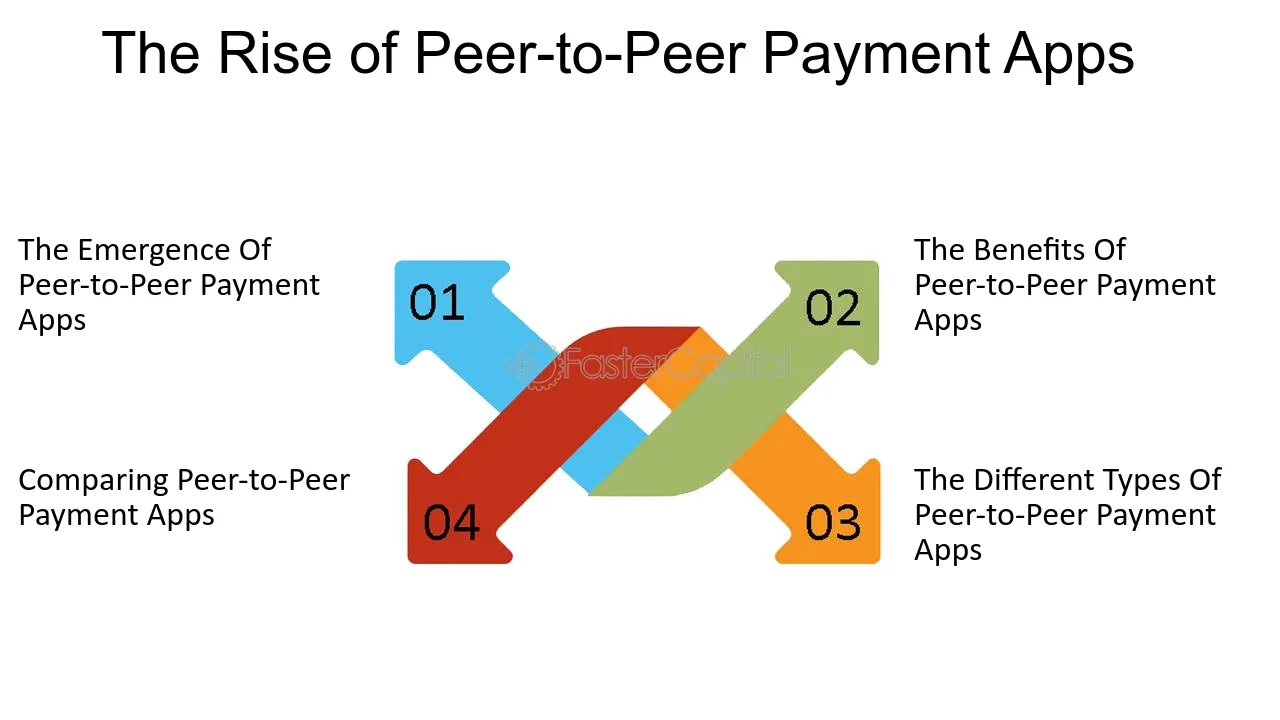
The Rise of Peer to Peer Payment Apps - Peer to Peer Payments: Embracing Finality with Convenience
15. The Rise of Peer-to-Peer Payments
1. The rise of Peer-to-peer Payments
Peer-to-peer (P2P) payments have revolutionized the way we transfer money, making it easier, faster, and more convenient than ever before. This payment method, also known as peer-to-peer money transfer or person-to-person payments, allows individuals to send and receive money directly from their bank accounts or mobile devices without the need for traditional intermediaries such as banks or payment processors. As technology continues to advance, P2P payments have gained significant popularity and have become an integral part of our daily lives. In this section, we will explore the factors contributing to the rise of peer-to-peer payments and delve into the benefits they offer.
2. Convenience and Accessibility
One of the key drivers behind the popularity of P2P payments is the convenience they offer. Gone are the days of writing checks, visiting banks, or dealing with the hassle of carrying cash. With P2P payment apps like Venmo, PayPal, and Cash App, sending and receiving money is as simple as a few taps on your smartphone. Whether you want to split a bill with friends, pay for goods and services, or even donate to a charitable cause, P2P payments provide a seamless and efficient way to transfer funds. Moreover, these services are accessible to anyone with a smartphone and a bank account, making them inclusive and widely available.
3. Speed and Efficiency
Traditional payment methods often involve waiting for checks to clear or for transactions to be processed by banks, which can take several business days. P2P payments, on the other hand, offer near-instantaneous transfers. With just a few clicks, funds can be transferred and reflected in the recipient's account within seconds. This speed and efficiency are particularly valuable in situations where immediate payment is required, such as splitting bills at a restaurant or paying for emergency services. P2P payments eliminate the need for physical currency or delayed processing times, providing a level of convenience that was previously unimaginable.
4. Enhanced Security and Fraud Prevention
Concerns about security and fraud have always been at the forefront of financial transactions. P2P payment platforms have implemented robust security measures to ensure the safety of user data and funds. Features such as two-factor authentication, encryption, and biometric verification provide an extra layer of protection against unauthorized access. Additionally, these platforms often offer buyer and seller protection policies, safeguarding users from fraudulent activities and ensuring that transactions are conducted securely. By leveraging advanced security technologies, P2P payments have instilled confidence in users and have become a trusted method for transferring money.
5. empowering Small businesses and Entrepreneurs
P2P payments have not only transformed personal transactions but have also had a profound impact on small businesses and entrepreneurs. Traditional payment methods often come with high transaction fees, making it challenging for small businesses to accept electronic payments. P2P payment apps have leveled the playing field by offering low or no fees for personal transactions as well as for small businesses. This has enabled small vendors, freelancers, and artisans to accept digital payments without the burden of excessive costs. As a result, P2P payments have empowered individuals to start and grow their businesses, fostering economic growth and innovation.
The rise of peer-to-peer payments can be attributed to their convenience, accessibility, speed, enhanced security, and the opportunities they provide for small businesses and entrepreneurs. As P2P payment platforms continue to innovate and evolve, we can expect this method of transferring money to become even more prevalent, transforming the way we handle financial transactions in the future.
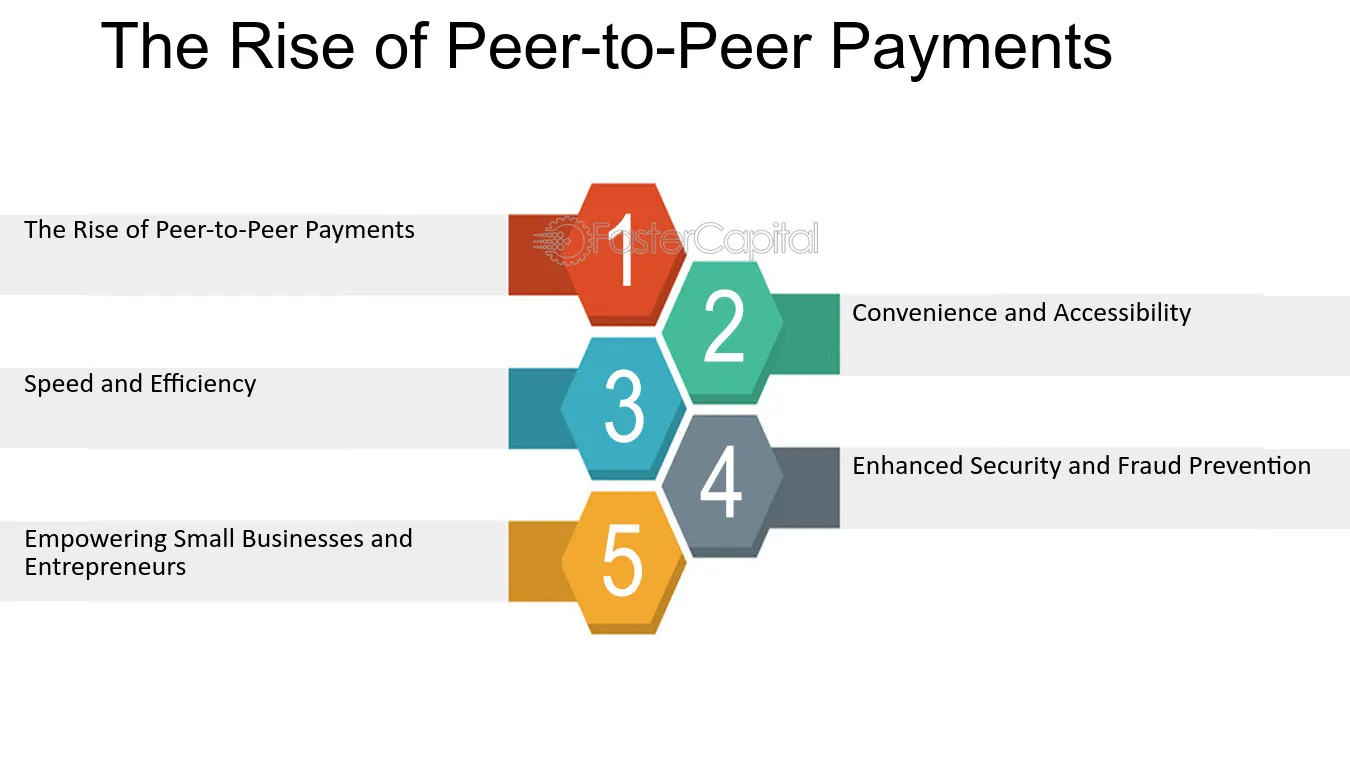
The Rise of Peer to Peer Payments - Peer to Peer Payments: Empowering Manufactured Payment Solutions
16. The Rise of Peer-to-Peer Real Estate Investing
With the ever-growing trend of alternative investments, peer-to-peer (P2P) real estate investing has emerged as a promising option for many investors. In the past, investing in real estate was only accessible to wealthy individuals or institutional investors. However, P2P platforms have made it possible for everyday investors to get involved in real estate investments with much smaller amounts of money. This new era of alternative investments has been made possible by the internet and new technologies that allow investors to connect with each other and with real estate developers in a more accessible and efficient way.
Here are some insights on the rise of peer-to-peer real estate investing:
1. The democratization of real estate investing: P2P platforms have made it possible for individual investors to invest in real estate projects that were previously only available to institutional investors. This has opened up a new market for real estate developers and made it possible for smaller investors to diversify their portfolios.
2. Reduced barriers to entry: One of the main advantages of P2P real estate investing is that it requires a much smaller initial investment than traditional real estate investing. This enables individual investors to participate in real estate deals that they might not have been able to otherwise.
3. Access to a wider range of investment opportunities: P2P platforms provide access to a wider range of real estate investment opportunities, including commercial and residential properties, as well as development projects. This allows investors to diversify their portfolios and potentially earn higher returns.
For example, platforms like Fundrise and RealtyMogul have made it possible for investors to invest in real estate with as little as $500. These platforms provide investors with access to a range of real estate projects, including commercial and residential properties, and offer varying degrees of risk and reward.
Overall, peer-to-peer real estate investing has emerged as a promising option for investors looking to diversify their portfolios and gain exposure to the real estate market. The reduced
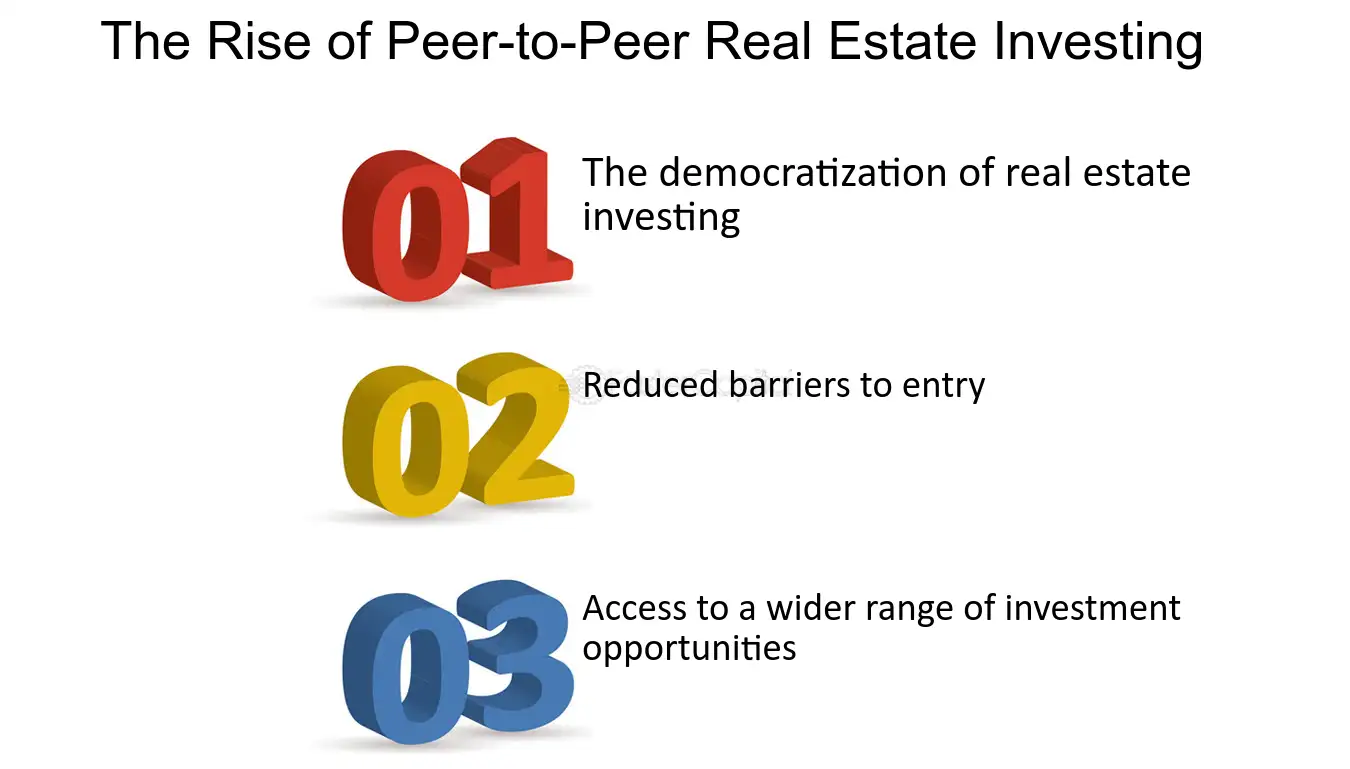
The Rise of Peer to Peer Real Estate Investing - Peer to peer real estate: A New Era of Alternative Investments
17. The Power of Peer-to-Peer Lending Startups:The Rise of Peer-to-Peer Lending Startups
1. Introduction of Peer-to-Peer Lending
Peer-to-peer lending, also known as P2P lending, has emerged as one of the most disruptive models in the financial industry. It allows individuals to lend and borrow money directly from one another, bypassing traditional banks and financial institutions. This innovative approach has gained significant popularity in recent years, as it offers numerous benefits to both borrowers and lenders.
2. The Disruption of Traditional Banking
Peer-to-peer lending startups have disrupted the traditional banking system by offering more favorable terms and conditions for borrowers. Unlike traditional banks, which often have strict lending criteria and high interest rates, P2P lending platforms provide borrowers with access to lower interest rates and more flexible loan terms. This has made borrowing more affordable and accessible for individuals who may have been overlooked by traditional banks.
3. Empowering Individuals
One of the key advantages of peer-to-peer lending startups is that they empower individuals by giving them control over their financial decisions. These platforms allow borrowers to apply for loans online, providing a convenient and streamlined process. By cutting out the middleman, borrowers can negotiate loan terms directly with lenders, resulting in a more personalized and transparent lending experience.
4. Diversification of Investment Opportunities
Peer-to-peer lending startups have also opened up new investment opportunities for individuals looking to grow their wealth. In the past, investing in loans was primarily limited to large financial institutions. However, with P2P lending platforms, anyone can become a lender and earn interest on their investments. This has democratized the investment landscape and provided individuals with an alternative to traditional investment options such as stocks and bonds.
5. Examples of Successful Peer-to-Peer Lending Startups
A. LendingClub: LendingClub is one of the most well-known peer-to-peer lending platforms in the United states. It connects borrowers with investors and has facilitated billions of dollars in loans since its inception. LendingClub offers competitive interest rates and transparent loan terms, making it an attractive option for both borrowers and lenders.
B. Prosper: Prosper is another popular P2P lending platform that has revolutionized the lending industry. It allows individuals to borrow money for various purposes, such as debt consolidation, home improvement, and small business funding. Prosper uses advanced algorithms to assess borrowers' creditworthiness and match them with suitable lenders.
C. Zopa: Zopa is the oldest peer-to-peer lending platform in the United Kingdom. It was founded in 2005 and has since facilitated over 4 billion pounds in loans. Zopa focuses on providing affordable loans to borrowers and offers competitive interest rates to lenders.
6. The future of Peer-to-peer Lending
As peer-to-peer lending continues to gain traction, the future looks promising for these startups. With advances in technology and the increasing demand for alternative financing options, P2P lending platforms are likely to become even more prevalent in the years to come. This could lead to further disruption in the traditional banking sector and empower individuals with greater control over their financial lives.
In conclusion, peer-to-peer lending startups have revolutionized the banking industry by offering affordable and accessible loans, empowering individuals, and diversifying investment opportunities. With the success of platforms like LendingClub, Prosper, and Zopa, it is clear that P2P lending is here to stay and will continue to reshape the financial landscape.
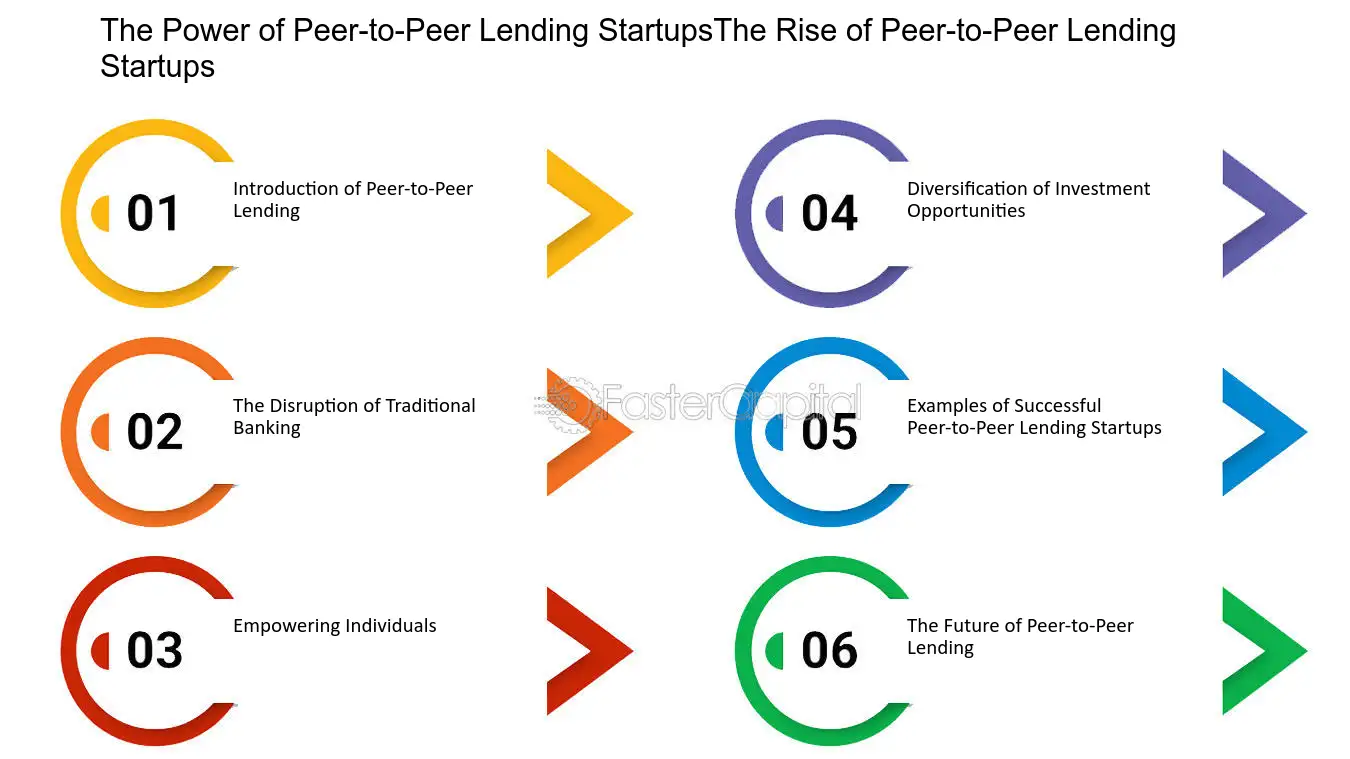
The Power of Peer to Peer Lending Startups:The Rise of Peer to Peer Lending Startups - Revolutionizing Banking: The Power of Peer to Peer Lending Startups
18. The Rise of Peer-to-Peer Evergreen Lending Platforms
As the financial landscape continues to evolve, traditional lending models are being challenged by innovative peer-to-peer (P2P) evergreen lending platforms. These platforms connect borrowers directly with individual lenders, bypassing the need for intermediaries such as banks. This emerging trend is revolutionizing the lending industry and providing individuals with greater access to credit. In this section, we will explore the rise of P2P evergreen lending platforms, their advantages and drawbacks, and the impact they are having on the financial industry.
1. Disintermediation of the lending process: P2P evergreen lending platforms eliminate the need for traditional financial institutions, allowing borrowers to connect directly with lenders. By cutting out intermediaries, these platforms offer borrowers the potential for lower interest rates and fees, as lenders can set their own terms. This disintermediation also reduces the bureaucracy and paperwork typically associated with traditional loan applications, making the borrowing process more efficient and streamlined.
2. Increased access to credit: P2P evergreen lending platforms have democratized access to credit by providing opportunities to individuals who may have been overlooked by traditional lenders. For instance, borrowers with less-than-perfect credit scores or limited credit history can still secure loans through these platforms by leveraging alternative data points and innovative underwriting algorithms. This inclusivity expands the pool of potential borrowers and promotes financial inclusion.
3. Diversification of investment opportunities: P2P evergreen lending platforms also offer a unique investment avenue for individuals looking to diversify their portfolios. Lenders on these platforms can allocate their funds across multiple loans, spreading the risk and potentially earning attractive returns. This diversification allows investors to participate in the lending market without the need for large capital outlays, as they can contribute smaller amounts to various loans.
4. technological advancements driving growth: The rise of P2P evergreen lending platforms can be attributed to advancements in technology. These platforms leverage sophisticated algorithms and machine learning to assess creditworthiness, determine interest rates, and match borrowers with lenders. Additionally, the use of blockchain technology provides enhanced security and transparency, ensuring the integrity of transactions. These technological advancements have not only facilitated the growth of P2P evergreen lending platforms but also improved the overall efficiency and trustworthiness of the lending process.
5. Regulatory challenges and risks: Despite the numerous benefits, P2P evergreen lending platforms also face regulatory challenges and risks. The lack of a centralized governing body raises concerns about consumer protection and fair lending practices. Additionally, the absence of collateral requirements and the reliance on alternative credit assessment methods may increase the risk of default for lenders. Regulators are working to strike a balance between fostering innovation and ensuring adequate safeguards are in place to protect both borrowers and lenders.
The rise of peer-to-peer evergreen lending platforms is reshaping the lending landscape by providing individuals with increased access to credit, diversifying investment opportunities, and leveraging technology to streamline the lending process. While these platforms offer numerous advantages, they also face regulatory challenges and risks that need to be addressed. As the financial industry continues to adapt to changing needs, P2P evergreen lending platforms are likely to play a significant role in shaping the future of lending.
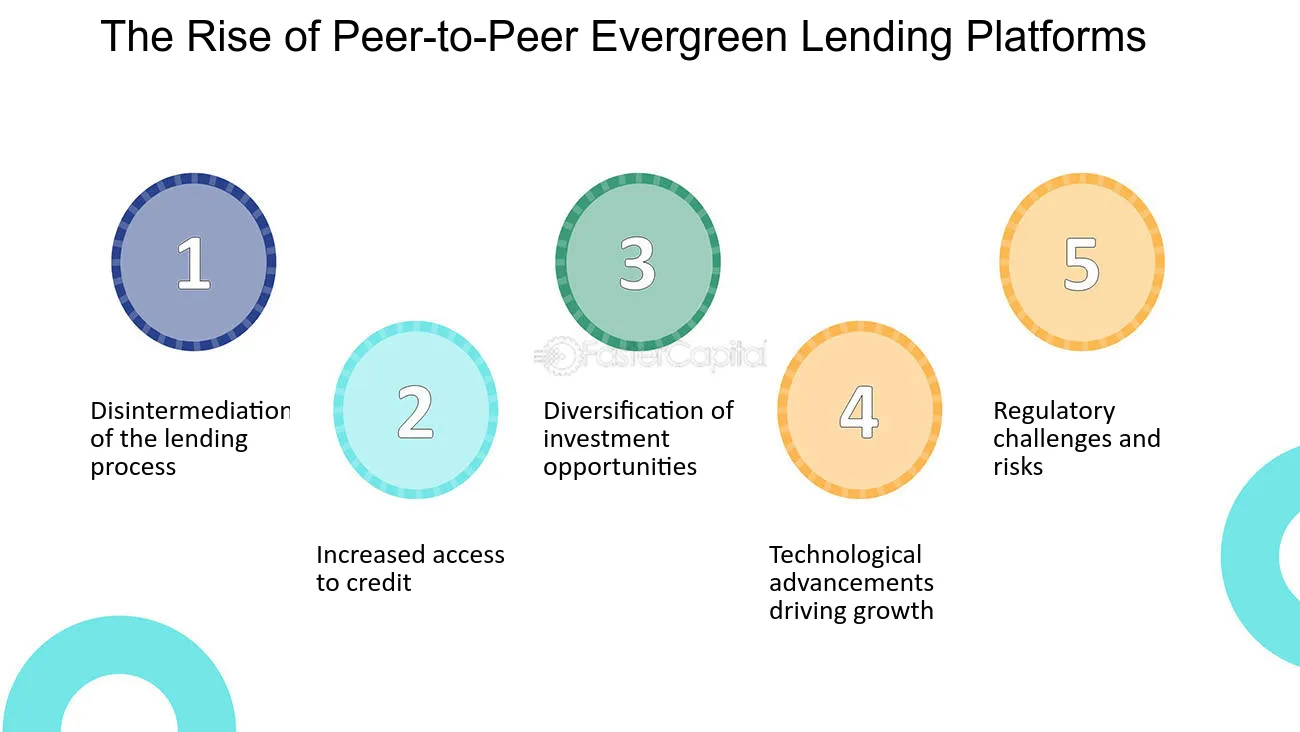
The Rise of Peer to Peer Evergreen Lending Platforms - The future of evergreen loans: Adapting to Changing Financial Needs
19. Discover the Benefits of Peer-to-Peer Lending Startups:Introduction: The Rise of Peer-to-Peer Lending Startups
1. The Birth of peer-to-Peer lending Startups
In recent years, a new trend in the world of borrowing and lending has emerged - peer-to-peer lending startups. These innovative platforms have disrupted the traditional banking sector by connecting individuals who are looking to borrow money with those who are willing to lend. Instead of relying on banks or other financial institutions, borrowers and lenders can now directly interact with each other through these online platforms, cutting out the middleman and potentially offering better terms for both parties involved.
2. How Peer-to-Peer Lending Startups Work
Peer-to-peer lending startups operate on the principle of connecting borrowers and lenders directly, often through an online marketplace. The borrowers create loan listings detailing the amount they need, the purpose of the loan, and the interest rate they are willing to pay. Potential lenders can then browse these listings and choose to invest in the loans that align with their investment goals.
To ensure the security and credibility of the transactions, these platforms typically perform rigorous credit checks on the borrowers and assign them a credit rating. This information is made available to the lenders, allowing them to make informed decisions about the level of risk they are willing to take on.
3. Advantages of Peer-to-Peer Lending for Borrowers
One of the key advantages of peer-to-peer lending for borrowers is the potential for lower interest rates compared to traditional lenders. Since these platforms operate with lower overhead costs compared to banks, they can pass on the savings to borrowers in the form of lower rates. Additionally, borrowers with less-than-perfect credit scores may find it easier to secure a loan through peer-to-peer lending platforms, as they often consider a wider range of factors beyond just credit scores.
For example, let's say Sarah wants to start her own small business but has been turned down by traditional banks due to her limited credit history. Through a peer-to-peer lending platform, she can create a loan listing explaining her business plan and her need for funds. Lenders who believe in her vision and are willing to take on the risk can invest in her loan, giving her the opportunity to turn her dream into a reality.
4. benefits of Peer-to-Peer lending for Lenders
On the other side of the equation, peer-to-peer lending startups offer numerous benefits for lenders as well. By cutting out the middleman, lenders can potentially earn higher returns on their investments compared to traditional savings accounts or other investment options. They have the flexibility to choose which loans to invest in, allowing them to diversify their portfolios and manage risk.
For instance, John, an investor looking to grow his wealth, can browse through various loan listings on a peer-to-peer lending platform. He can invest small amounts in multiple loans to spread his risk across different borrowers and industries. If all goes well, he can earn a steady stream of interest income, potentially outperforming traditional investment options.
5. Conclusion
The rise of peer-to-peer lending startups has revolutionized the borrowing and lending landscape, offering an alternative to traditional banks and financial institutions. These platforms provide borrowers with easier access to funds and potentially more favorable loan terms, while offering lenders the opportunity to earn higher returns on their investments. As the industry continues to grow, it will be interesting to see how peer-to-peer lending evolves and shapes the future of finance.
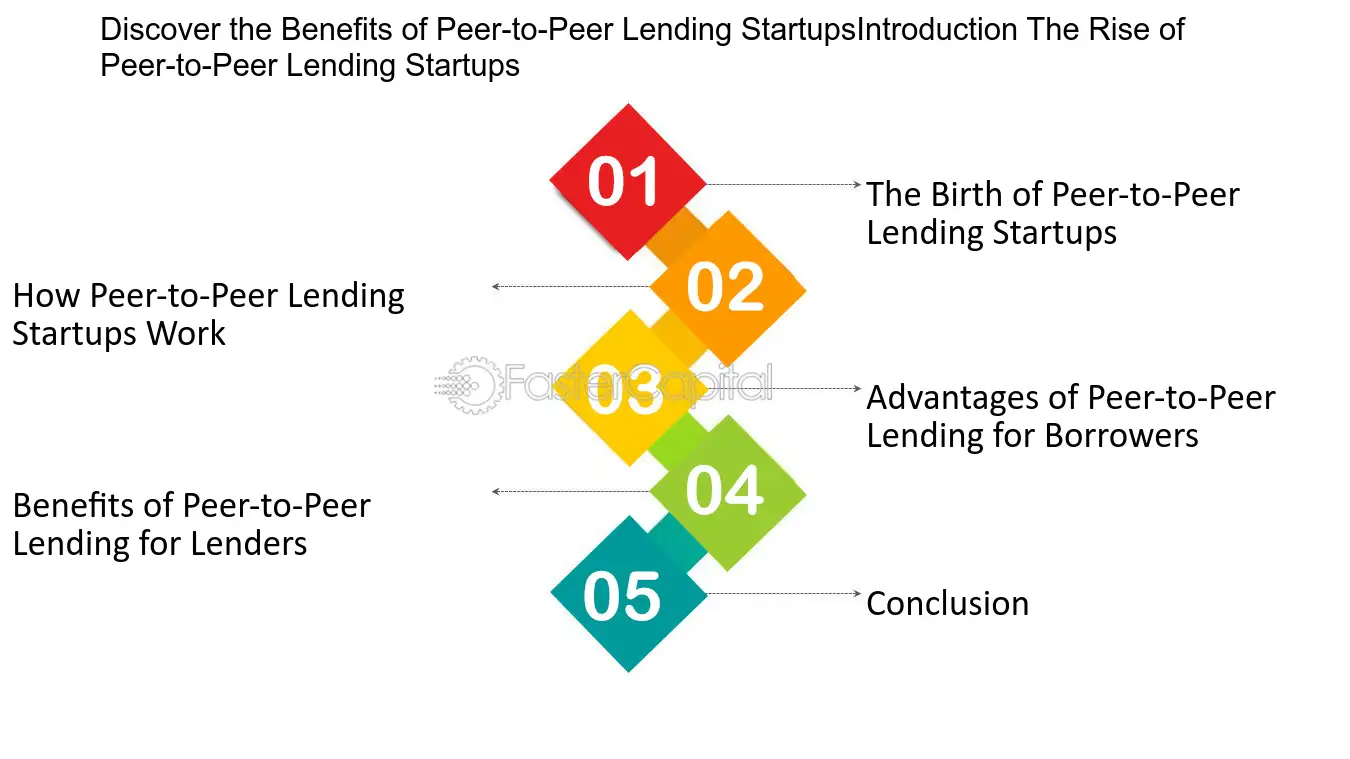
Discover the Benefits of Peer to Peer Lending Startups:Introduction: The Rise of Peer to Peer Lending Startups - The New Age of Borrowing: Discover the Benefits of Peer to Peer Lending Startups
20. The Rise of Peer-to-Peer Marketplaces
The rise of peer-to-peer marketplaces has been nothing short of revolutionary in the landscape of collaborative consumption. Enabled by the proliferation of digital platforms and the growing preference for shared economies, these marketplaces have fundamentally transformed the way we access goods and services. By harnessing the power of technology, peer-to-peer marketplaces have fostered a sense of community-driven commerce, empowering individuals to both access and offer a wide array of resources, thereby fostering a more sustainable and efficient way of consumption. This shift in consumer behavior has not only challenged traditional business models but has also redefined the concept of ownership and value exchange. While some applaud the democratization of goods and services, others raise concerns about regulatory challenges and the potential implications for various industries.
1. Disruption of Traditional Industries:
The advent of peer-to-peer marketplaces has disrupted various industries, ranging from transportation to hospitality. Take, for instance, the emergence of platforms like Airbnb and VRBO, which have transformed the hospitality sector by allowing individuals to rent out their properties to travelers. This disruption has challenged the dominance of traditional hotel chains and sparked conversations around the importance of regulatory frameworks that can ensure fair competition while safeguarding consumer interests.
2. Promotion of Sustainable Consumption:
Peer-to-peer marketplaces have also championed the cause of sustainable consumption by encouraging the reuse and sharing of resources. Platforms such as ThredUp and Poshmark have gained traction by facilitating the buying and selling of pre-owned clothing, reducing the environmental footprint of the fashion industry. This shift towards a more circular economy not only promotes eco-conscious behavior but also cultivates a sense of responsibility among consumers, thereby fostering a more mindful approach to consumption.
3. Community Building and Trust Networks:
An inherent feature of many peer-to-peer marketplaces is the emphasis on community building and trust networks. Platforms like TaskRabbit and Upwork have created virtual spaces where individuals can offer their skills and services to others within their communities. Through user reviews, ratings, and verification processes, these platforms have cultivated a sense of trust among strangers, thereby fostering a collaborative environment built on mutual respect and accountability.
4. Regulatory Challenges and Legal Frameworks:
The rapid growth of peer-to-peer marketplaces has raised significant regulatory challenges, especially in areas concerning taxation, labor rights, and consumer protection. The gig economy, propelled by platforms like Uber and Lyft, has prompted debates about the classification of workers and the need for comprehensive legal frameworks that can address the complexities of this evolving employment landscape. Balancing innovation with the protection of workers' rights remains a critical concern for policymakers worldwide.
5. Innovation and Future Growth:
The success of peer-to-peer marketplaces has fueled innovation and encouraged entrepreneurs to explore new avenues for collaborative consumption. From shared office spaces to peer-to-peer lending platforms, the potential for disruptive growth remains significant. As technology continues to advance, we can anticipate the emergence of more specialized and niche peer-to-peer marketplaces catering to specific needs and preferences, further reshaping the dynamics of traditional market structures.

The Rise of Peer to Peer Marketplaces - The Power of Peer to Peer Sharing in Collaborative Consumption
21. A Look into Peer-to-Peer Lending Startups:Introduction: The Rise of Peer-to-Peer Lending Startups
1. The Emergence of peer-to-Peer lending Startups
Peer-to-peer lending, also known as P2P lending, is a rapidly growing alternative lending model that has disrupted the traditional banking sector. These innovative startups connect borrowers directly with lenders, cutting out the middleman and revolutionizing the way people borrow and lend money.
2. How it Works
Unlike traditional banks, peer-to-peer lending platforms operate entirely online. Borrowers create profiles and submit loan requests, detailing the purpose of the loan, the amount required, and the interest rate they are willing to pay. Lenders, on the other hand, browse through loan listings and choose which ones to fund based on their risk appetite and return expectations.
3. Benefits for Borrowers
Peer-to-peer lending startups offer numerous advantages to borrowers. Firstly, the streamlined application process allows borrowers to access loans quickly and easily, often within a matter of days. This is in stark contrast to the lengthy and arduous approval procedures of traditional banks.
Additionally, peer-to-peer lending platforms often cater to individuals who may struggle to obtain credit from traditional sources. Those with less-than-perfect credit scores or limited credit history may find it easier to secure a loan through P2P lending, as these platforms typically use alternative data points to assess creditworthiness.
4. Benefits for Lenders
Lenders also stand to benefit from participating in peer-to-peer lending. By investing in loans directly, individuals can potentially earn higher returns compared to traditional investment vehicles such as savings accounts or bonds. This is particularly attractive in today's low-interest-rate environment.
Furthermore, peer-to-peer lending allows lenders to diversify their investment portfolios by spreading their funds across multiple loans. This diversification helps mitigate risk, as any potential losses from defaults are offset by the interest earned from successful loans.
5. Examples of Peer-to-Peer Lending Startups
The peer-to-peer lending industry is booming, with several prominent startups leading the way. One such example is LendingClub, the largest P2P lending platform in the United States. Since its launch in 2007, LendingClub has facilitated billions of dollars in loans, connecting borrowers and investors from all walks of life.
Another notable player in the industry is Funding Circle, a UK-based P2P lending platform that focuses on small business loans. By providing access to capital for entrepreneurs and small businesses, Funding Circle has helped stimulate economic growth and create job opportunities.
6. The future of Peer-to-peer Lending
As peer-to-peer lending continues to gain traction, it is expected to further disrupt the traditional banking sector. With advancements in technology and increased regulatory oversight, these startups have the potential to become a mainstream alternative to traditional banks.
In the next sections of this blog series, we will delve deeper into the mechanics of peer-to-peer lending, explore the risks and challenges associated with this lending model, and analyze the potential benefits for both borrowers and lenders. Stay tuned for more insightful discussions on this exciting financial innovation.
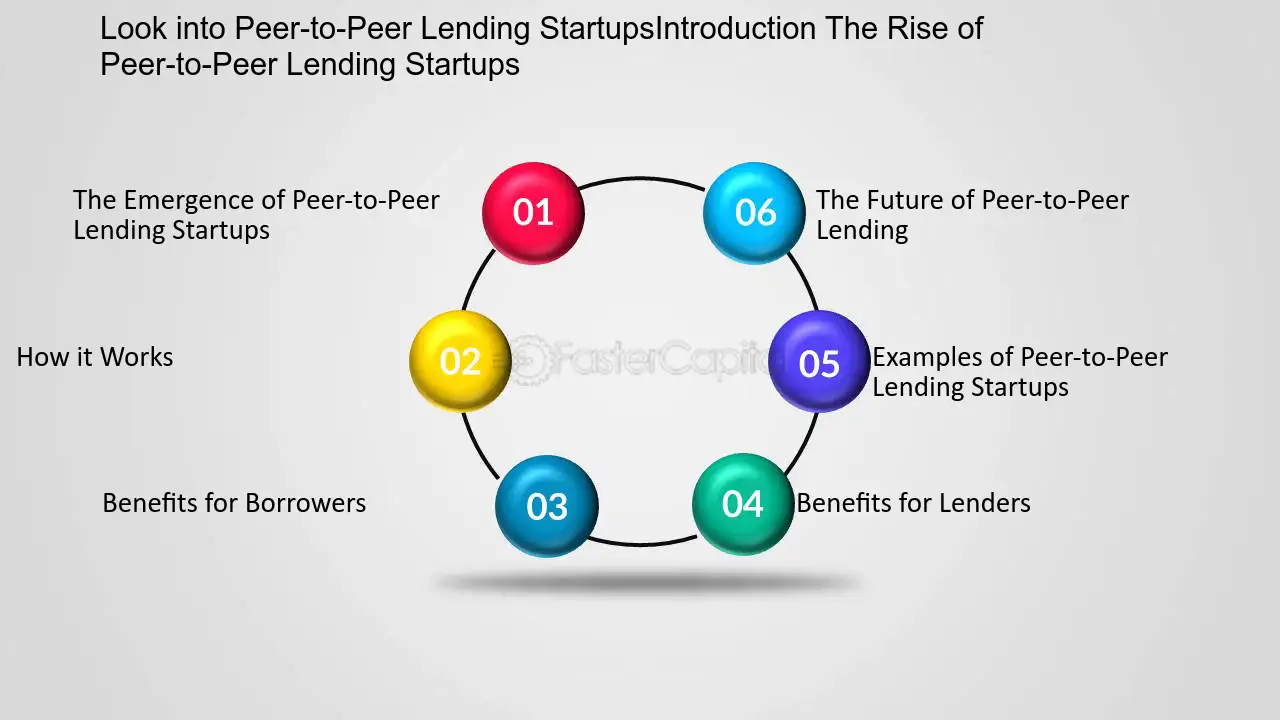
A Look into Peer to Peer Lending Startups:Introduction: The Rise of Peer to Peer Lending Startups - The Smarter Way to Borrow: A Look into Peer to Peer Lending Startups
22. Exploring the Rise of Peer-to-Peer Lending Startups:Introduction: The Changing Landscape of Finance
1. Traditional finance has long been dominated by large banks and financial institutions. These institutions have held the power to control and distribute capital, making it challenging for individuals and small businesses to access funds. However, the financial landscape is rapidly changing with the rise of technology and the emergence of peer-to-peer lending startups.
2. Peer-to-peer lending, also known as P2P lending, is a form of direct lending that connects borrowers directly with investors through online platforms. These platforms act as intermediaries, facilitating the lending process and enabling individuals and businesses to secure loans without the need for traditional financial institutions.
3. One of the main reasons for the rapid growth of P2P lending is the accessibility it offers. Unlike traditional banks, P2P lending platforms are open to a wide range of borrowers and investors. This means that individuals who may have been denied a loan from a bank due to a lack of credit history or collateral can now access much-needed funds through P2P lending platforms.
4. Another advantage of P2P lending is the speed and convenience it offers. Traditional loan application processes can be lengthy and cumbersome, involving extensive paperwork and multiple rounds of approval. In contrast, P2P lending platforms streamline the process, allowing borrowers to apply online and receive loan offers within a matter of days or even hours.
5. Additionally, P2P lending often provides borrowers with more favorable interest rates compared to traditional banks. This is because P2P lending platforms eliminate many of the overhead costs associated with brick-and-mortar banks, allowing them to offer lower rates to borrowers. As a result, borrowers can save money on interest payments and potentially repay their loans more quickly.
6. P2P lending also offers attractive investment opportunities for individuals looking to diversify their portfolios. Through P2P lending platforms, investors can lend money to a variety of borrowers and earn interest on their investments. This allows individuals to earn passive income and potentially achieve higher returns compared to traditional investment options.
7. The changing landscape of finance also brings about challenges and risks. As P2P lending is a relatively new industry, regulations and oversight are still evolving. It is important for borrowers and investors to thoroughly research and understand the risks associated with P2P lending before participating in these platforms.
8. In conclusion, the rise of peer-to-peer lending startups has revolutionized the financial industry by providing individuals and businesses with greater access to capital and investment opportunities. With its accessibility, speed, and potential cost savings, P2P lending is undoubtedly changing the way people borrow and invest money. However, it is essential for individuals to approach P2P lending with caution and conduct thorough due diligence to mitigate any potential risks.

Exploring the Rise of Peer to Peer Lending Startups:Introduction: The Changing Landscape of Finance - The Tech Disruption in Finance: Exploring the Rise of Peer to Peer Lending Startups
23. Exploring the Rise of Peer-to-Peer Lending Startups:Understanding Peer-to-Peer Lending
1. How does Peer-to-Peer Lending Work?
Peer-to-peer lending, often abbreviated as P2P lending, is a form of lending that connects borrowers directly with lenders without the need for traditional financial institutions like banks. This disruptive model has gained significant popularity in recent years, revolutionizing the way people borrow and lend money. Here's a breakdown of how it works:
A) Borrowers create loan listings: Individuals or businesses seeking funds create loan listings on a peer-to-peer lending platform. These listings include information such as the loan amount, purpose, interest rate, and repayment term.
For example, let's say John wants to borrow $10,000 to consolidate his high-interest credit card debt. He creates a loan listing on a P2P platform, outlining his financial situation and repayment plan.
B) Lenders review and fund loan listings: Lenders on the platform review the loan listings and decide whether to fund them based on various factors such as the borrower's creditworthiness, loan purpose, and interest rate offered.
Continuing with our example, Sarah, a lender on the platform, comes across John's loan listing. Impressed by his credit score and repayment plan, she decides to invest $5,000 in John's loan.
C) Loan disbursement: Once a loan listing is fully funded by one or multiple lenders, the loan is disbursed to the borrower. The borrower then starts making regular repayments, including principal and interest, as agreed upon in the loan terms.
In our example, John receives the $10,000 loan after lenders fully fund his loan listing. He now has a fixed monthly repayment plan to follow.
2. benefits of Peer-to-peer Lending
Peer-to-peer lending offers several benefits to both borrowers and lenders, making it an attractive alternative to traditional lending methods. Here are some key advantages:
A) lower interest rates: P2P lending often provides borrowers with lower interest rates compared to traditional lenders. This is because P2P platforms have lower overhead costs, allowing for more competitive rates.
For instance, Jane, who needs a personal loan for home improvements, finds that the interest rate offered by traditional banks is 12%. However, she discovers a P2P lending platform where she can secure the same loan at an interest rate of 9%.
B) Diversification for lenders: P2P lending allows lenders to diversify their investment portfolios by lending smaller amounts to multiple borrowers. This mitigates the risk associated with lending large sums to a single borrower.
For example, Mike, an investor, decides to allocate $10,000 to P2P lending. Instead of lending the entire amount to a single borrower, he spreads his investment across 10 different loan listings, each receiving $1,000. This diversification strategy helps reduce the potential impact of default by any single borrower.
C) Streamlined application and approval process: Unlike traditional lenders that involve lengthy paperwork and stringent eligibility criteria, P2P lending platforms offer a streamlined application and approval process. Borrowers can complete the entire process online, making it convenient and time-saving.
For instance, Lisa, a small business owner, needs quick funding to expand her operations. She applies for a loan through a P2P platform and receives approval within 48 hours, allowing her to proceed with her plans without delays.
In conclusion, peer-to-peer lending has disrupted the traditional lending landscape by connecting borrowers directly with lenders. Its streamlined process, lower interest rates, and diversification opportunities make it an attractive option for both borrowers and lenders. As this alternative financing model continues to gain traction, it is reshaping the way individuals and businesses access capital.
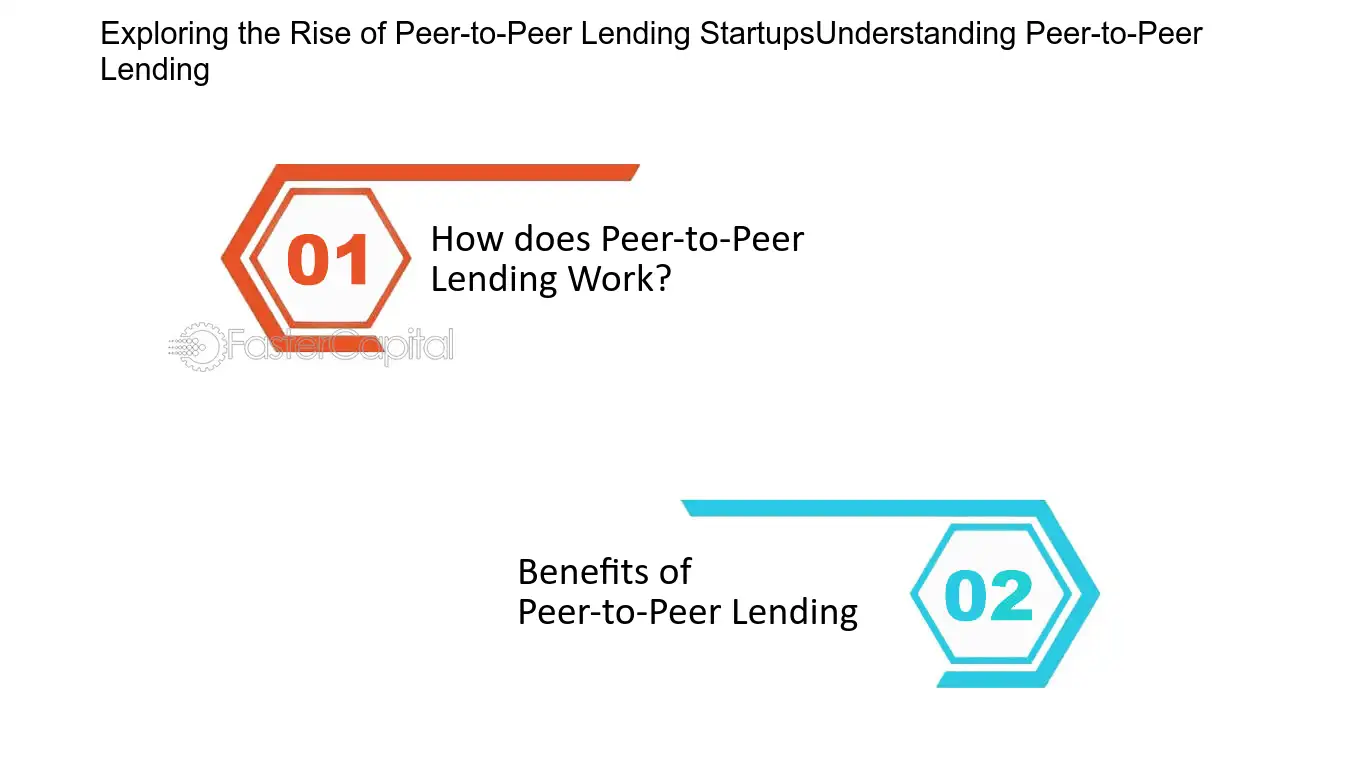
Exploring the Rise of Peer to Peer Lending Startups:Understanding Peer to Peer Lending - The Tech Disruption in Finance: Exploring the Rise of Peer to Peer Lending Startups
24. Exploring the Rise of Peer-to-Peer Lending Startups:The Advantages of Peer-to-Peer Lending
1. Diversification of Investment Portfolio
One of the biggest advantages of peer-to-peer lending is the ability to diversify your investment portfolio. Traditionally, investors have relied on stocks, bonds, and real estate to grow their wealth. However, by adding peer-to-peer lending to the mix, you can further spread your risk and potentially increase your returns.
For example, let's say you have $10,000 to invest. Instead of putting all your money into a single stock or bond, you can lend smaller amounts to multiple borrowers through a peer-to-peer lending platform. This way, if one borrower defaults on their loan, you won't lose your entire investment. By diversifying across multiple loans, you can mitigate the risk and potentially earn higher overall returns.
2. Higher Returns than Traditional Investments
In addition to diversification, peer-to-peer lending offers the potential for higher returns compared to traditional investments. When you lend money to individuals or businesses through a peer-to-peer platform, you can earn interest rates that are often higher than what you would earn from a savings account or a certificate of deposit.
For instance, let's say a borrower needs a $10,000 loan and is willing to pay an interest rate of 10% over a three-year period. As an investor, you can choose to fund a portion of that loan and earn a percentage of the interest. Over time, these higher interest rates can significantly boost your overall returns and help you achieve your financial goals faster.
3. Access to Creditworthy Borrowers
Peer-to-peer lending platforms provide access to creditworthy borrowers who may not qualify for traditional bank loans. This opens up opportunities for individuals and businesses that have been overlooked by traditional financial institutions due to strict lending criteria.
For example, small businesses often struggle to secure loans from banks, especially if they are new or lack established credit histories. However, peer-to-peer lending platforms evaluate borrowers based on a variety of factors, including credit scores, income, and business plans. This means that creditworthy borrowers who may have been turned away by banks can still access the capital they need through peer-to-peer lending.
4. Transparency and Control
Peer-to-peer lending offers an unprecedented level of transparency and control for investors. Unlike traditional financial institutions, where your money is pooled together with other investors' funds, peer-to-peer lending allows you to choose exactly which loans to fund.
For instance, on a peer-to-peer lending platform, you can review detailed information about each borrower, including their credit history, loan purpose, and repayment plan. This level of transparency empowers you to make informed investment decisions based on your risk tolerance and investment goals.
Furthermore, peer-to-peer lending platforms often provide robust tools and analytics to help you track the performance of your investments. This gives you the ability to monitor your portfolio and make adjustments as needed, ensuring that you are in control of your financial future.
In conclusion, peer-to-peer lending offers several advantages for investors, including diversification, higher returns, access to creditworthy borrowers, and transparency. As the rise of peer-to-peer lending startups continues to disrupt the finance industry, more and more investors are recognizing the potential of this innovative investment avenue. By embracing peer-to-peer lending, you can take advantage of these benefits and achieve your financial goals faster.
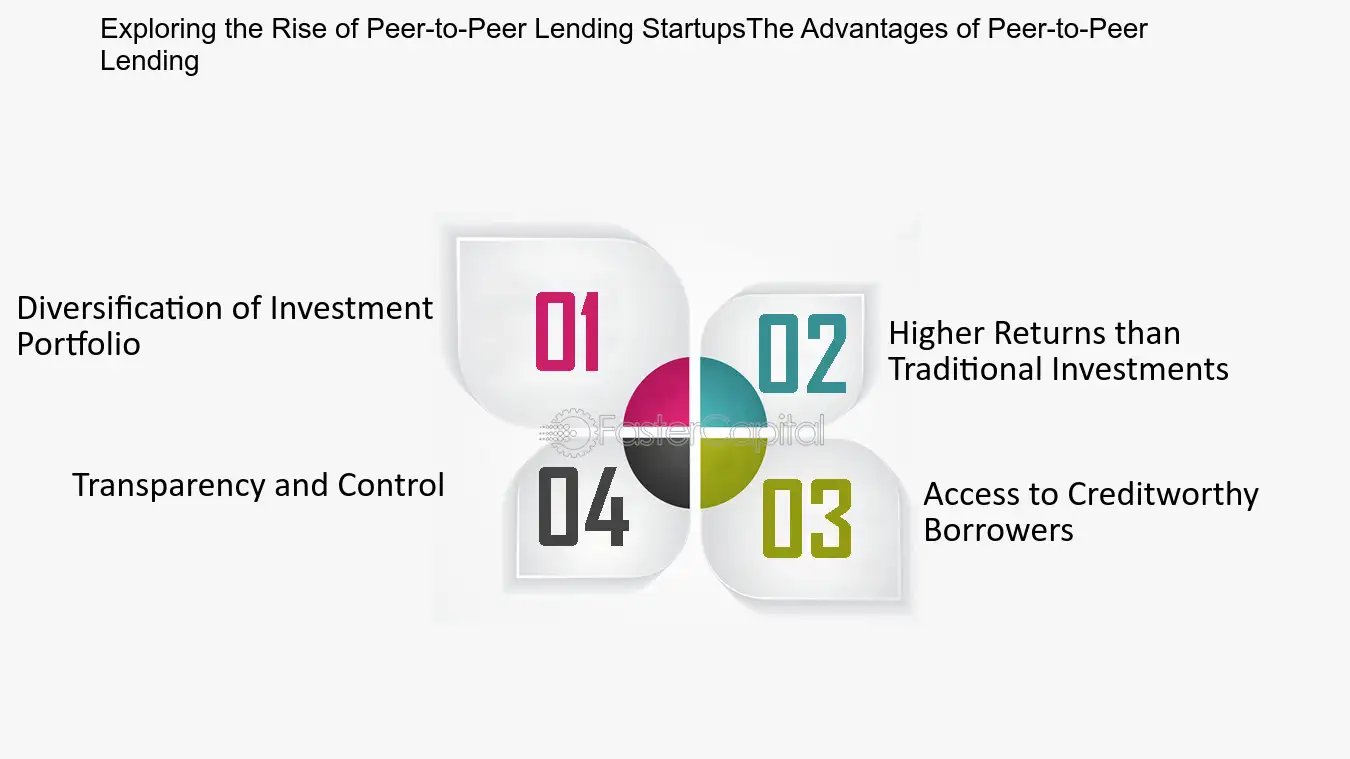
Exploring the Rise of Peer to Peer Lending Startups:The Advantages of Peer to Peer Lending - The Tech Disruption in Finance: Exploring the Rise of Peer to Peer Lending Startups
25. Exploring the Rise of Peer-to-Peer Lending Startups:How Peer-to-Peer Lending Works
1. understanding the Basics of Peer-to-peer Lending
Peer-to-peer lending, also known as P2P lending, is a financial innovation that has gained significant traction in recent years. It allows individuals or small businesses to borrow money directly from other individuals, without the need for traditional financial intermediaries like banks. This form of lending has been made possible by online platforms that connect borrowers and lenders, creating a marketplace for loans.
2. The Role of Online Platforms
Online platforms act as intermediaries, facilitating the entire lending process. They provide a user-friendly interface where borrowers can create loan listings, detailing the amount they need, the purpose of the loan, and the interest rate they are willing to pay. On the other hand, lenders can browse through these listings and choose to invest in the loans that align with their risk appetite and expected returns.
3. Credit Assessment and Risk Management
One of the key challenges in peer-to-peer lending is assessing the creditworthiness of borrowers. Unlike traditional banks, P2P lending platforms do not have access to detailed credit histories or collateral to mitigate the risk of default. To overcome this, these platforms employ various credit assessment techniques, including analyzing the borrower's financial statements, income sources, and credit scores. Some platforms even use advanced algorithms and machine learning to predict the likelihood of repayment.
4. Diversification and Investment Opportunities
One of the major advantages of peer-to-peer lending is the opportunity it provides for diversification. Lenders can spread their investments across multiple loans, reducing the risk of default. For example, if a lender invests $1,000 in 100 different loans with varying interest rates and risk profiles, the potential loss from a single default is minimized. This diversification strategy allows lenders to earn a steady income stream from the interest payments received from borrowers.
5. Transparency and Lower Costs
Peer-to-peer lending platforms offer greater transparency compared to traditional lending institutions. Borrowers and lenders have direct access to the loan terms, interest rates, and other relevant information. This transparency helps in building trust and confidence among the participants in the marketplace.
Additionally, P2P lending platforms operate with lower overhead costs compared to traditional banks. As a result, these platforms can offer competitive interest rates to borrowers while providing attractive returns to lenders. This win-win situation has made peer-to-peer lending an attractive alternative to traditional lending channels.
6. Regulation and Investor Protection
As the popularity of peer-to-peer lending has grown, regulators around the world have started to introduce regulations to protect investors and borrowers. These regulations aim to ensure fair practices, transparency, and adequate disclosure of risks associated with P2P lending. This regulatory oversight helps in building trust and confidence in the industry and encourages more people to participate in peer-to-peer lending.
In conclusion, peer-to-peer lending has revolutionized the traditional lending landscape by providing individuals and businesses with an alternative source of financing. Through online platforms, borrowers can access funds quickly, while lenders can earn attractive returns on their investments. With its transparency, lower costs, and potential for diversification, peer-to-peer lending is poised to continue disrupting the finance industry in the years to come.
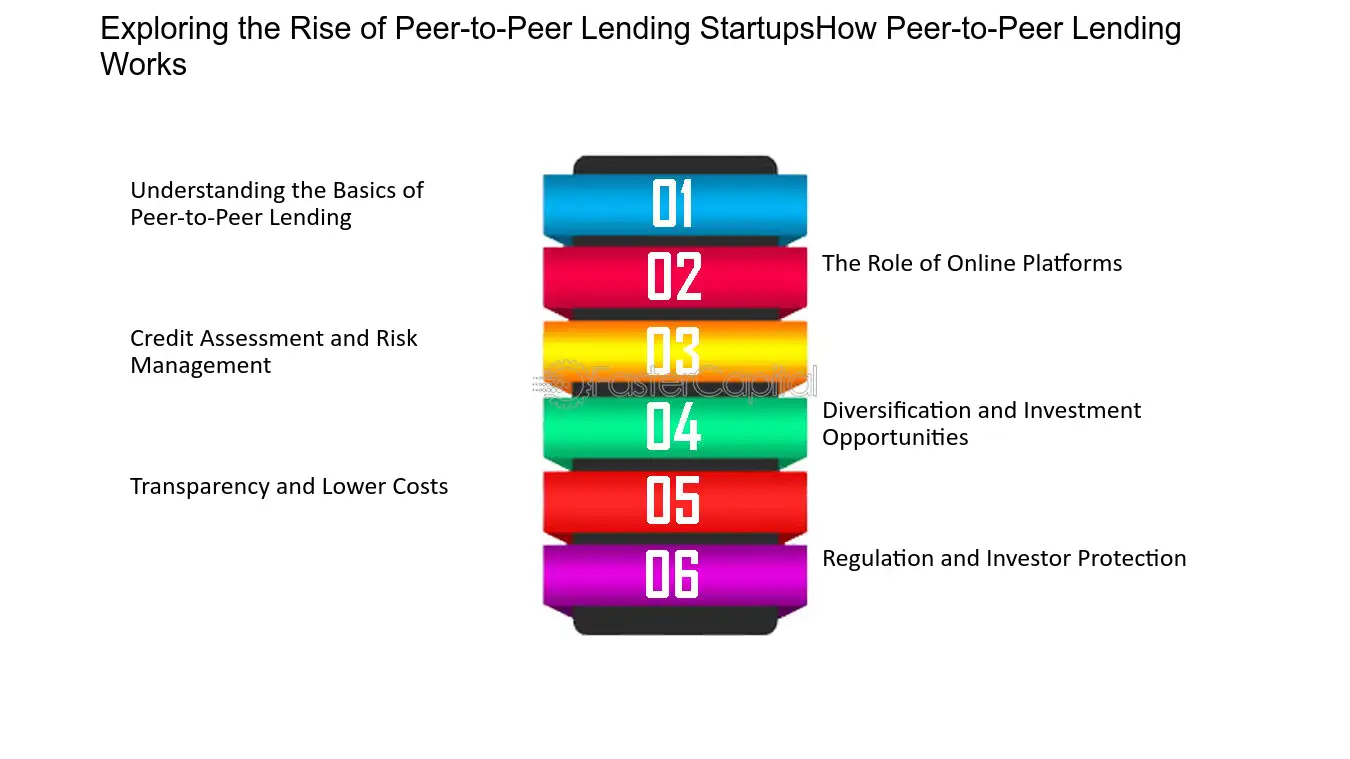
Exploring the Rise of Peer to Peer Lending Startups:How Peer to Peer Lending Works - The Tech Disruption in Finance: Exploring the Rise of Peer to Peer Lending Startups
26. Exploring the Rise of Peer-to-Peer Lending Startups:The Rise of Peer-to-Peer Lending Startups
1. The democratization of finance
Peer-to-peer lending startups have emerged as a disruptive force in the world of finance, revolutionizing the way individuals and businesses access capital. These platforms leverage technology to connect borrowers directly with lenders, bypassing traditional financial institutions such as banks. This democratization of finance has opened up new opportunities for both borrowers and lenders, giving individuals the power to take control of their financial future.
2. Cutting out the middleman
One of the key advantages of peer-to-peer lending is the elimination of the middleman. By connecting borrowers and lenders directly, these platforms remove the need for banks or other financial intermediaries. This not only reduces costs but also simplifies the lending process. Borrowers can avoid the lengthy and often cumbersome loan application process, while lenders can enjoy higher returns on their investment compared to traditional savings accounts or low-interest investments.
For example, platforms like LendingClub and Prosper in the United States have facilitated billions of dollars in loans by connecting borrowers with individual investors. These platforms have disrupted the traditional lending model and have attracted a wide range of borrowers, from individuals looking to consolidate debt to small businesses seeking working capital.
3. Enhanced transparency and risk assessment
Peer-to-peer lending startups are transforming the lending landscape by providing enhanced transparency and risk assessment tools. These platforms utilize sophisticated algorithms and data analysis to evaluate borrower creditworthiness and assign interest rates accordingly. This data-driven approach enables lenders to make more informed decisions and reduces the risk of default.
For instance, Zopa, one of the first peer-to-peer lending platforms in the UK, uses advanced credit scoring models to assess borrower risk and assign interest rates. By providing lenders with detailed information about the borrower's credit history, employment status, and financial stability, Zopa minimizes the risk of default and enables lenders to confidently invest their money.
4. Access to credit for underserved borrowers
Peer-to-peer lending startups have also played a crucial role in extending access to credit to underserved populations. Traditional financial institutions often have strict lending criteria, making it difficult for individuals with limited credit history or unconventional income sources to obtain loans. Peer-to-peer lending platforms, on the other hand, take a more inclusive approach, considering a broader range of factors beyond traditional credit scores.
For example, Kiva, a nonprofit peer-to-peer lending platform, focuses on providing microloans to entrepreneurs in developing countries. By connecting lenders from around the world with borrowers in need, Kiva has empowered countless individuals to start or grow their businesses, ultimately lifting themselves and their communities out of poverty.
5. The future of finance
The rise of peer-to-peer lending startups is just the beginning of a larger shift in the financial landscape. As technology continues to advance and regulations adapt to accommodate this new model, we can expect to see even more innovation in the fintech sector. Peer-to-peer lending has already demonstrated its potential to disrupt traditional finance, and its impact will only continue to grow in the coming years.
In conclusion, the rise of peer-to-peer lending startups has transformed the way individuals and businesses access capital, offering a more efficient, transparent, and inclusive alternative to traditional lending. With increased access to credit, improved risk assessment tools, and the elimination of financial intermediaries, peer-to-peer lending is revolutionizing the financial industry and paving the way for a more democratized and inclusive future of finance.
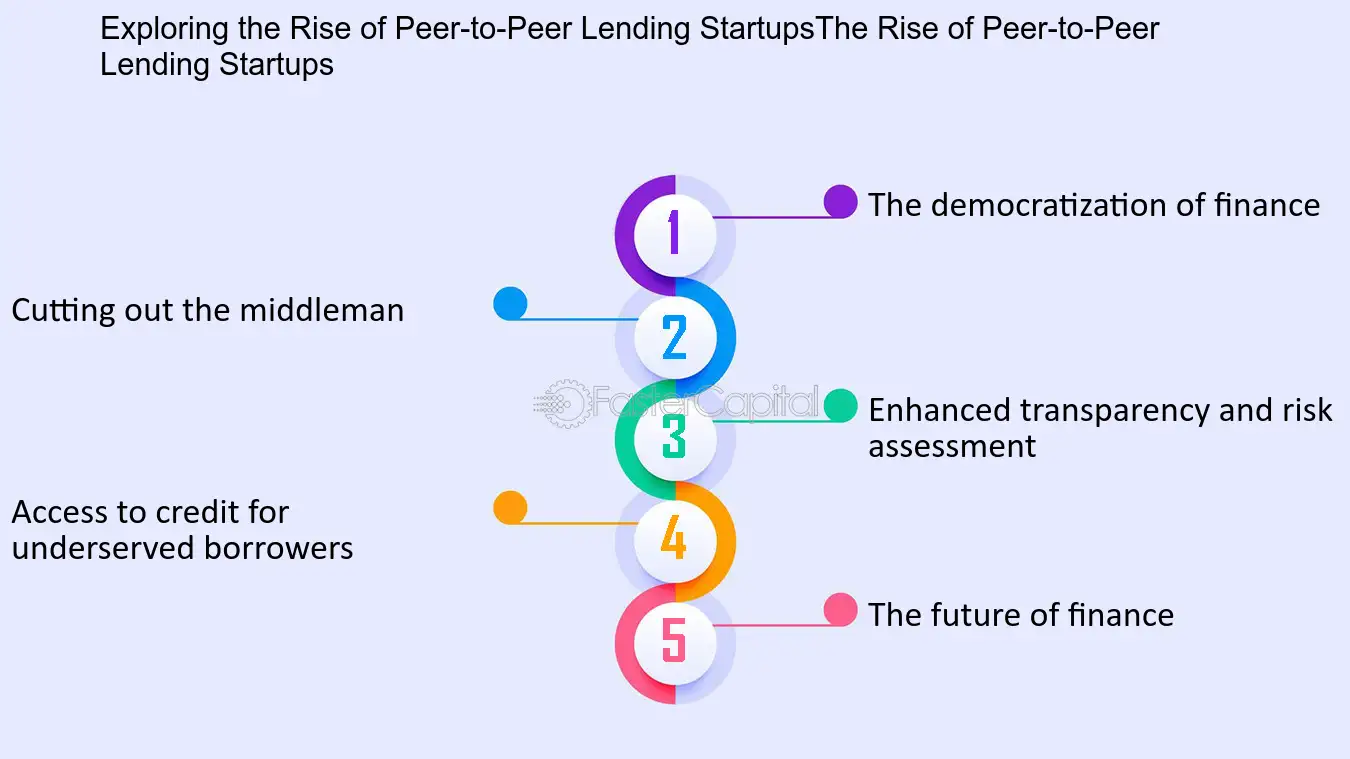
Exploring the Rise of Peer to Peer Lending Startups:The Rise of Peer to Peer Lending Startups - The Tech Disruption in Finance: Exploring the Rise of Peer to Peer Lending Startups
27. Exploring the Rise of Peer-to-Peer Lending Startups:The Rise of Peer-to-Peer Lending Startups
1. The democratization of finance
Peer-to-peer lending startups have emerged as a disruptive force in the world of finance, revolutionizing the way individuals and businesses access capital. These platforms leverage technology to connect borrowers directly with lenders, bypassing traditional financial institutions such as banks. This democratization of finance has opened up new opportunities for both borrowers and lenders, giving individuals the power to take control of their financial future.
2. Cutting out the middleman
One of the key advantages of peer-to-peer lending is the elimination of the middleman. By connecting borrowers and lenders directly, these platforms remove the need for banks or other financial intermediaries. This not only reduces costs but also simplifies the lending process. Borrowers can avoid the lengthy and often cumbersome loan application process, while lenders can enjoy higher returns on their investment compared to traditional savings accounts or low-interest investments.
For example, platforms like LendingClub and Prosper in the United States have facilitated billions of dollars in loans by connecting borrowers with individual investors. These platforms have disrupted the traditional lending model and have attracted a wide range of borrowers, from individuals looking to consolidate debt to small businesses seeking working capital.
3. Enhanced transparency and risk assessment
Peer-to-peer lending startups are transforming the lending landscape by providing enhanced transparency and risk assessment tools. These platforms utilize sophisticated algorithms and data analysis to evaluate borrower creditworthiness and assign interest rates accordingly. This data-driven approach enables lenders to make more informed decisions and reduces the risk of default.
For instance, Zopa, one of the first peer-to-peer lending platforms in the UK, uses advanced credit scoring models to assess borrower risk and assign interest rates. By providing lenders with detailed information about the borrower's credit history, employment status, and financial stability, Zopa minimizes the risk of default and enables lenders to confidently invest their money.
4. Access to credit for underserved borrowers
Peer-to-peer lending startups have also played a crucial role in extending access to credit to underserved populations. Traditional financial institutions often have strict lending criteria, making it difficult for individuals with limited credit history or unconventional income sources to obtain loans. Peer-to-peer lending platforms, on the other hand, take a more inclusive approach, considering a broader range of factors beyond traditional credit scores.
For example, Kiva, a nonprofit peer-to-peer lending platform, focuses on providing microloans to entrepreneurs in developing countries. By connecting lenders from around the world with borrowers in need, Kiva has empowered countless individuals to start or grow their businesses, ultimately lifting themselves and their communities out of poverty.
5. The future of finance
The rise of peer-to-peer lending startups is just the beginning of a larger shift in the financial landscape. As technology continues to advance and regulations adapt to accommodate this new model, we can expect to see even more innovation in the fintech sector. Peer-to-peer lending has already demonstrated its potential to disrupt traditional finance, and its impact will only continue to grow in the coming years.
In conclusion, the rise of peer-to-peer lending startups has transformed the way individuals and businesses access capital, offering a more efficient, transparent, and inclusive alternative to traditional lending. With increased access to credit, improved risk assessment tools, and the elimination of financial intermediaries, peer-to-peer lending is revolutionizing the financial industry and paving the way for a more democratized and inclusive future of finance.

Exploring the Rise of Peer to Peer Lending Startups:The Rise of Peer to Peer Lending Startups - The Tech Disruption in Finance: Exploring the Rise of Peer to Peer Lending Startups
28. Exploring the Rise of Peer-to-Peer Lending Startups:Evaluating the Impact of Peer-to-Peer Lending on Traditional Financial Institutions
1. Decreased reliance on traditional banks:
Peer-to-peer lending platforms have emerged as a viable alternative for borrowers seeking loans, bypassing the need to approach traditional financial institutions. This shift has led to a decrease in the reliance on banks, as borrowers find it more convenient and efficient to connect directly with individual lenders through peer-to-peer lending platforms. For example, platforms like LendingClub and Prosper have facilitated billions of dollars in loans, enabling borrowers to access funds without going through the lengthy and sometimes arduous process of dealing with banks.
2. Disintermediation of traditional lending processes:
Peer-to-peer lending has disrupted the traditional lending model by eliminating the need for intermediaries such as banks. In the traditional lending process, banks act as intermediaries between borrowers and lenders, earning profits by charging interest rates higher than what they offer to lenders. Peer-to-peer lending platforms, on the other hand, connect borrowers and lenders directly, cutting out the middleman and reducing costs for both parties. This disintermediation has challenged the dominance of traditional financial institutions in the lending space.
3. Increased competition and innovation:
The rise of peer-to-peer lending has prompted traditional financial institutions to reassess their lending practices and find ways to compete with these disruptive startups. In response, many banks have begun to explore partnerships with peer-to-peer lending platforms or have even launched their own competing platforms. For example, Goldman Sachs launched Marcus, an online lending platform that directly competes with peer-to-peer lenders. This competition has led to increased innovation in the lending sector, with traditional banks incorporating elements of peer-to-peer lending into their own offerings.
4. Enhanced efficiency and transparency:
Peer-to-peer lending platforms leverage technology to enhance the efficiency and transparency of the lending process. These platforms use algorithms to match borrowers with lenders based on their preferences and risk profiles, streamlining the loan origination process. Additionally, the use of blockchain technology has the potential to further enhance transparency and security in peer-to-peer lending. For instance, blockchain-based lending platforms like SALT Lending and ETHLend are exploring decentralized lending models that eliminate the need for intermediaries and increase trust between borrowers and lenders.
5. risk management challenges:
While peer-to-peer lending offers numerous benefits, it also poses certain risks to borrowers and lenders. For borrowers, the ease of accessing funds through peer-to-peer lending platforms may lead to increased indebtedness if they do not exercise proper financial discipline. Lenders, on the other hand, face the risk of default if borrowers are unable to repay their loans. The lack of regulatory oversight in the peer-to-peer lending space also raises concerns about investor protection and systemic risks. However, regulatory bodies in many countries are now working to establish frameworks to address these risks and provide a safer environment for borrowers and lenders.
In conclusion, peer-to-peer lending has had a significant impact on traditional financial institutions by reducing their role as intermediaries, increasing competition, and driving innovation. While there are risks associated with peer-to-peer lending, the industry continues to evolve, with regulatory frameworks being established to ensure its long-term sustainability. Traditional financial institutions must adapt to these changes or risk losing market share to the growing number of peer-to-peer lending startups.
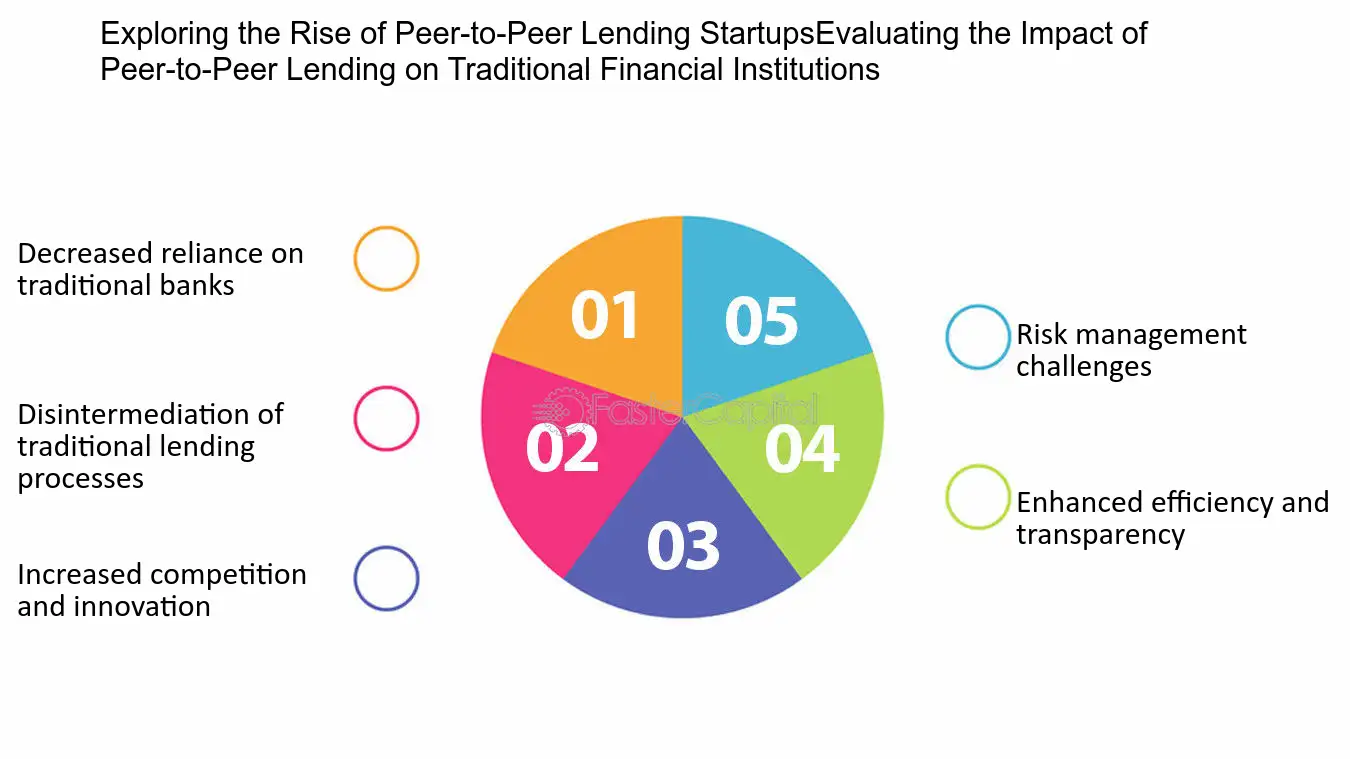
Exploring the Rise of Peer to Peer Lending Startups:Evaluating the Impact of Peer to Peer Lending on Traditional Financial Institutions - The Tech Disruption in Finance: Exploring the Rise of Peer to Peer Lending Startups
29. Exploring the Rise of Peer-to-Peer Lending Startups:Regulatory Challenges and Opportunities for Peer-to-Peer Lending Startups
1. Regulatory Challenges Faced by Peer-to-Peer Lending Startups
One of the key challenges faced by peer-to-peer lending startups is navigating the complex regulatory landscape. Unlike traditional banks and financial institutions, these startups operate in a relatively new and evolving industry, which often lacks clear guidelines and regulations. As a result, they face a number of hurdles in terms of compliance and regulatory oversight.
For example, in the United States, the securities and Exchange commission (SEC) regulates certain types of peer-to-peer lending platforms under the federal securities laws. This means that these startups must comply with registration requirements and disclosure obligations, which can be both time-consuming and costly. Failure to comply with these regulations can result in penalties and legal consequences.
Similarly, in the United Kingdom, peer-to-peer lending platforms are regulated by the Financial Conduct Authority (FCA). The FCA has implemented rules and guidelines to protect consumers and ensure fair and transparent lending practices. However, startups in this space must still dedicate significant resources to meet these regulatory requirements.
2. Compliance Costs and Operational Constraints
Complying with regulatory requirements can be a major financial burden for peer-to-peer lending startups. These companies often have limited resources and operating budgets, making it challenging to allocate funds for legal and compliance expenses. Furthermore, the ever-changing regulatory landscape requires startups to constantly adapt their operations and systems, which adds to the overall costs.
For instance, peer-to-peer lending platforms may need to invest in robust technological infrastructure to ensure data security and privacy. They may also need to hire compliance officers and legal experts to navigate the complex regulatory environment. These additional expenses can put a strain on the financial health of startups, making it difficult for them to compete with larger, established financial institutions.
3. Limited Access to Capital and Investor Protection
Regulatory challenges can also hinder peer-to-peer lending startups' ability to attract investors and raise capital. Potential investors may be hesitant to invest in these platforms due to concerns about regulatory compliance and the lack of investor protection mechanisms.
To address these concerns, regulators have implemented various investor protection measures. For example, in the United States, the SEC requires peer-to-peer lending platforms to provide detailed disclosures to investors, including information about the loan portfolio, default rates, and potential risks. While these measures are aimed at protecting investors, they can also increase the administrative burden for startups and limit their access to capital.
4. Opportunities for Collaboration and Innovation
Despite the regulatory challenges, there are also opportunities for peer-to-peer lending startups to collaborate with regulators and shape the regulatory framework. Regulators recognize the potential benefits of peer-to-peer lending, such as increased access to credit for underserved borrowers and diversification of investment opportunities.
By actively engaging with regulators, startups can contribute to the development of regulations that strike a balance between investor protection and fostering innovation. For example, startups can provide input on regulatory frameworks and propose alternative compliance mechanisms that are more suitable for their business models.
In conclusion, regulatory challenges are a significant hurdle for peer-to-peer lending startups. Compliance costs, operational constraints, and limited access to capital can pose serious obstacles to their growth. However, by actively collaborating with regulators and advocating for industry-friendly regulations, startups can help shape the future of peer-to-peer lending and unlock its full potential.
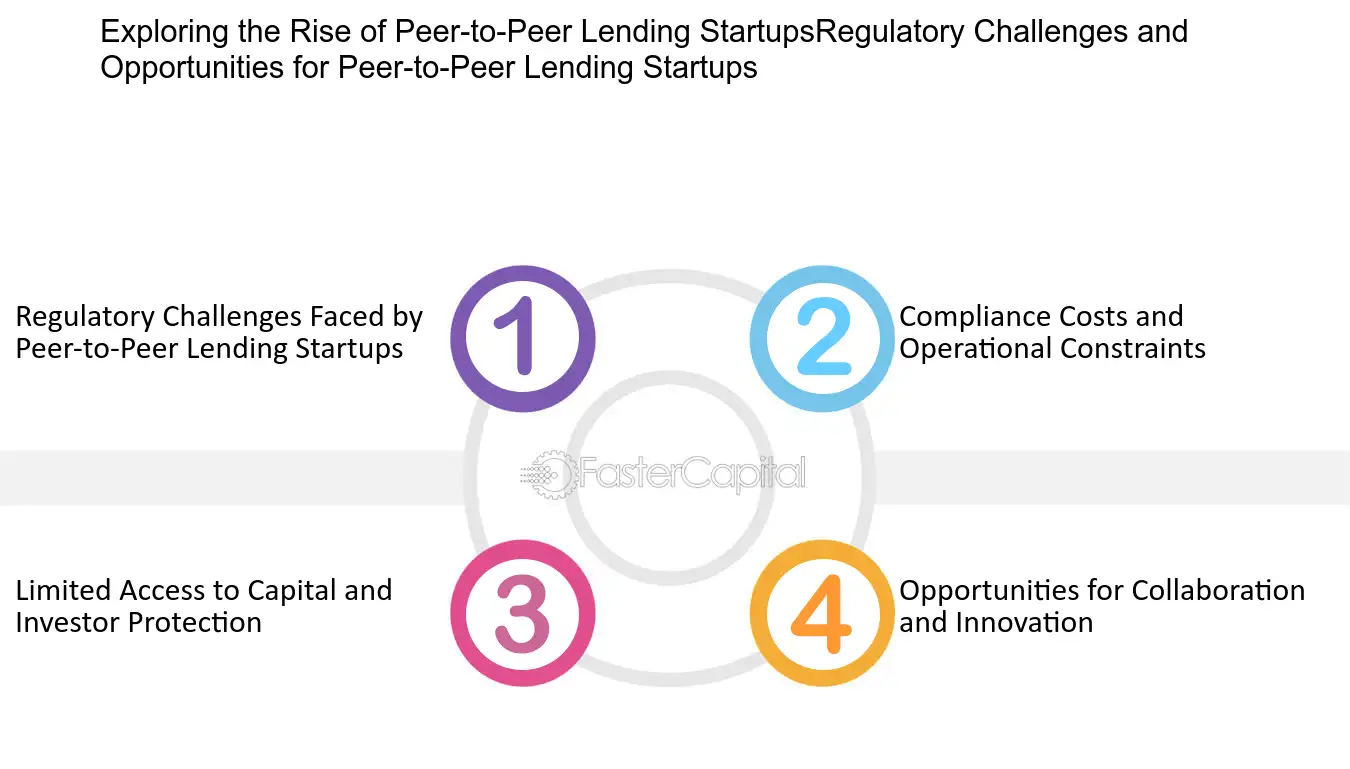
Exploring the Rise of Peer to Peer Lending Startups:Regulatory Challenges and Opportunities for Peer to Peer Lending Startups - The Tech Disruption in Finance: Exploring the Rise of Peer to Peer Lending Startups
30. Exploring the Rise of Peer-to-Peer Lending Startups:The Potential Risks and Mitigation Strategies in Peer-to-Peer Lending
1. Lack of Regulation and Oversight
One of the potential risks associated with peer-to-peer lending is the lack of regulation and oversight in the industry. Unlike traditional financial institutions, peer-to-peer lending platforms are not subject to the same level of scrutiny and regulation. This can leave investors and borrowers vulnerable to fraudulent activities and other misconduct.
To mitigate this risk, some peer-to-peer lending platforms have taken steps to self-regulate and implement stricter guidelines and standards. For example, platforms may require borrowers to provide additional documentation and undergo thorough verification processes. Additionally, some platforms have started to collaborate with regulatory bodies to establish industry-wide standards and best practices.
2. Default Risk
Another risk to consider in peer-to-peer lending is the potential for borrowers to default on their loans. While platforms typically have risk assessment mechanisms in place to evaluate borrowers' creditworthiness, there is still a chance that borrowers may default due to unforeseen circumstances such as job loss or economic downturns.
To mitigate default risk, peer-to-peer lending platforms employ various strategies. For instance, platforms may diversify their loan portfolios by spreading investments across a range of borrowers with different risk profiles. This helps to minimize the impact of individual defaults on overall returns. Additionally, some platforms also provide investors with options to purchase loan insurance, which can cover losses in the event of borrower default.
3. Limited Liquidity
Unlike traditional investments such as stocks and bonds, peer-to-peer loans can have limited liquidity. Once investors have committed their funds to a loan, they may have to wait until the loan matures or find a secondary market to sell their investment.
To address this challenge, some peer-to-peer lending platforms have introduced secondary markets where investors can trade their loan investments. These secondary markets provide a way for investors to exit their positions early if needed. However, it's important to note that the liquidity of these secondary markets can vary depending on the platform and the demand for loan investments.
4. Platform Risk
Investors in peer-to-peer lending are also exposed to platform risk, which refers to the potential failure or bankruptcy of the lending platform itself. If a platform goes out of business, investors may face challenges in recovering their investments.
To mitigate platform risk, investors should carefully evaluate the reputation, track record, and financial stability of the peer-to-peer lending platform before investing. It's also advisable to diversify investments across multiple platforms to minimize the impact of any platform failures.
In conclusion, while peer-to-peer lending offers exciting opportunities for both investors and borrowers, it's important to be aware of the potential risks involved. By understanding and implementing appropriate mitigation strategies, investors can navigate the peer-to-peer lending landscape with confidence and increase their chances of achieving their financial goals.
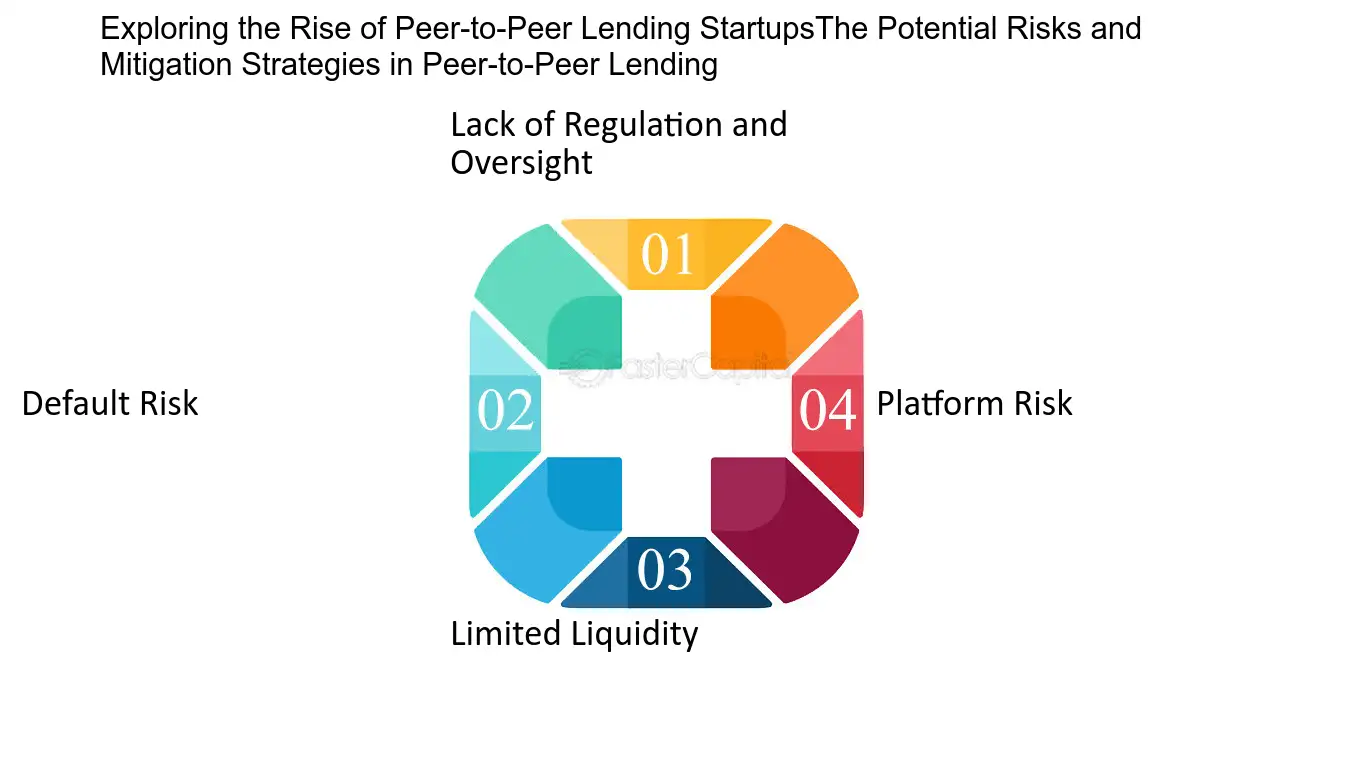
Exploring the Rise of Peer to Peer Lending Startups:The Potential Risks and Mitigation Strategies in Peer to Peer Lending - The Tech Disruption in Finance: Exploring the Rise of Peer to Peer Lending Startups
31. Exploring the Rise of Peer-to-Peer Lending Startups:The Role of Technology in Facilitating Peer-to-Peer Lending
1. Streamlining the Borrowing Process
One of the key roles of technology in facilitating peer-to-peer lending is streamlining the borrowing process. Traditional financial institutions often have lengthy and complex loan application processes, which can be a barrier for small businesses or individuals in need of quick funding. Peer-to-peer lending platforms leverage technology to simplify the application process and make it more accessible.
For example, platforms like LendingClub and Prosper allow borrowers to complete the entire loan application online. They use algorithms and data analytics to assess a borrower's creditworthiness and assign them a risk rating. This automated process significantly reduces the time it takes to get approved for a loan, allowing borrowers to access funds faster and more conveniently.
2. Connecting Borrowers and Lenders
Another crucial role of technology in peer-to-peer lending is facilitating the connection between borrowers and lenders. In a traditional banking system, borrowers and lenders have limited visibility into each other, making it challenging to establish a personal connection or negotiate favorable loan terms.
Peer-to-peer lending platforms bridge this gap by creating an online marketplace where borrowers and lenders can connect directly. These platforms use advanced algorithms to match borrowers with lenders based on their specific borrowing requirements, risk appetite, and desired interest rates. This technology-enabled matchmaking process ensures that borrowers are connected with lenders who are willing to fund their loan requests, increasing the chances of successful loan transactions.
For instance, Zopa, one of the first peer-to-peer lending platforms, uses a sophisticated matching algorithm that considers factors such as credit score, loan purpose, and borrower preferences to connect borrowers with suitable lenders. This technology-driven approach not only helps borrowers access funding but also allows lenders to diversify their investment portfolios and earn competitive returns.
3. Enhancing Transparency and Trust
Technology plays a pivotal role in enhancing transparency and trust in the peer-to-peer lending ecosystem. In traditional lending, borrowers often have limited visibility into the factors that determine their loan eligibility or interest rates. This lack of transparency can lead to frustration and mistrust.
Peer-to-peer lending platforms leverage technology to provide borrowers with transparent information about their loan terms, interest rates, and fees. They also use advanced data analytics to assess borrowers' creditworthiness and assign them risk ratings. By providing borrowers with clear and understandable information, these platforms create a more transparent and trustworthy lending environment.
For example, Funding Circle, a leading peer-to-peer lending platform for small businesses, provides borrowers with a detailed breakdown of their loan terms, including interest rates, monthly payments, and any additional fees. This level of transparency helps borrowers make informed decisions and build trust in the lending process.
In conclusion, technology plays a crucial role in facilitating peer-to-peer lending by streamlining the borrowing process, connecting borrowers with lenders, and enhancing transparency and trust. By leveraging advanced algorithms, data analytics, and online marketplaces, peer-to-peer lending platforms are revolutionizing the way individuals and businesses access financing, making it more efficient, accessible, and transparent than ever before.
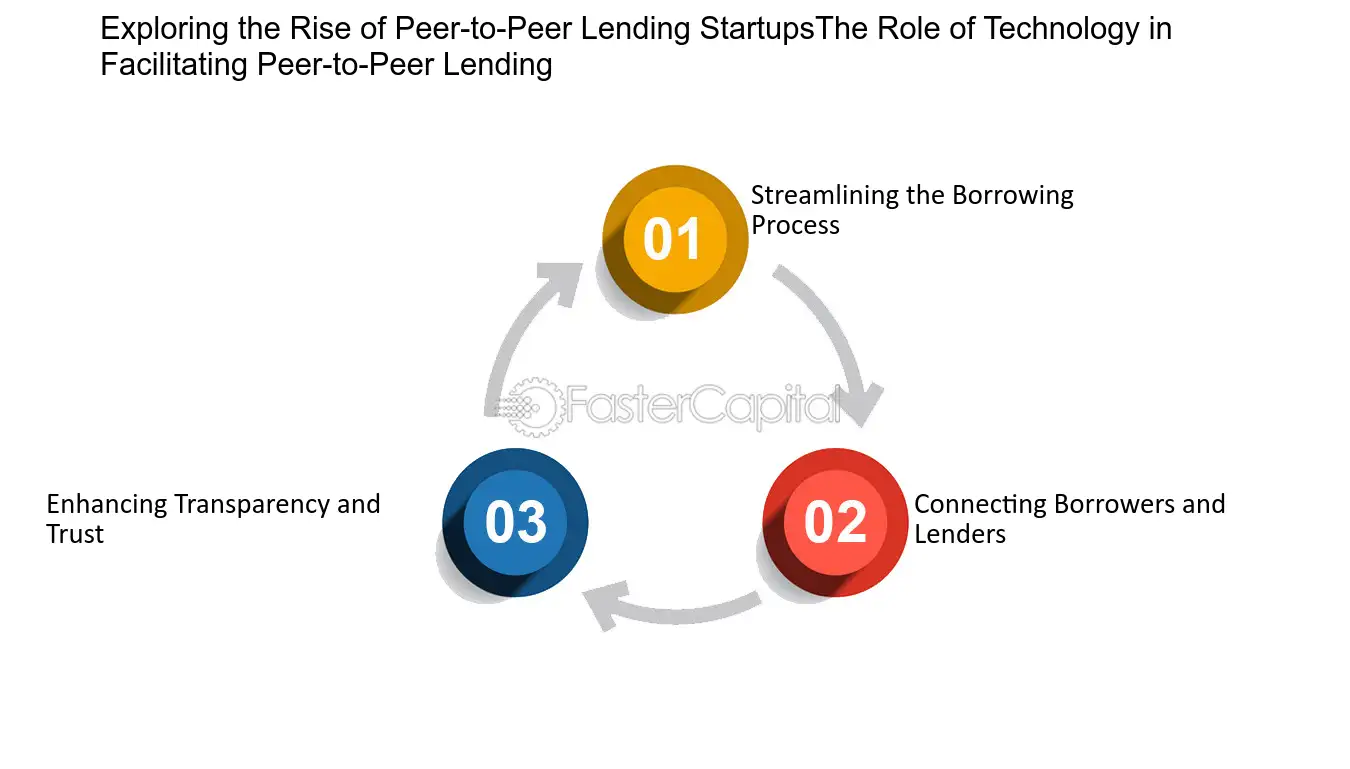
Exploring the Rise of Peer to Peer Lending Startups:The Role of Technology in Facilitating Peer to Peer Lending - The Tech Disruption in Finance: Exploring the Rise of Peer to Peer Lending Startups
32. Exploring the Rise of Peer-to-Peer Lending Startups:Exploring the Global Expansion of Peer-to-Peer Lending Platforms
1. The Global Reach of Peer-to-Peer Lending Platforms
Peer-to-peer lending platforms have rapidly expanded their presence across the globe, disrupting the traditional banking sector and providing alternative financing options for borrowers and investors alike. Let's explore some notable examples of how these platforms have made their mark in different regions:
2. Europe: The Birthplace of P2P Lending
Europe has been at the forefront of the peer-to-peer lending revolution, with some of the earliest and most successful platforms originating from the region. For instance, Zopa, the world's first P2P lending platform, was founded in the United Kingdom in 2005. Since then, it has facilitated over £5 billion in loans, allowing individuals to lend money directly to borrowers and earn attractive returns.
3. United States: P2P Lending Goes Mainstream
In the United States, platforms like LendingClub and Prosper have gained significant traction, attracting both retail and institutional investors. LendingClub, founded in 2006, has facilitated over $60 billion in loans, focusing on personal loans, business loans, and patient financing. These platforms have not only disrupted traditional lending institutions but have also opened up new investment opportunities for individuals looking to diversify their portfolios.
4. Asia: The Rise of P2P Lending Giants
Asia has witnessed an explosion of peer-to-peer lending platforms, driven by a combination of factors like the large unbanked population and the growing middle class. China's P2P lending industry, led by platforms like Lufax and Dianrong, has experienced tremendous growth, with millions of borrowers and investors participating in the marketplace. Similarly, in Southeast Asia, platforms like Funding Societies and MoolahSense have gained popularity, providing much-needed access to capital for small and medium-sized enterprises.
5. Latin America: Empowering the Underserved
Peer-to-peer lending platforms are also making waves in Latin America, where they are empowering underserved communities and individuals with limited access to traditional financial services. Nubank, a Brazilian neobank, offers personal loans through its P2P lending platform, allowing consumers to borrow money at lower interest rates than traditional banks. This model has not only provided financial inclusion but has also contributed to the growth of the region's fintech ecosystem.
6. Africa: P2P Lending for Economic Growth
In Africa, where the lack of access to credit is a major challenge, peer-to-peer lending platforms are playing a crucial role in driving economic growth. Platforms like Branch and Tala leverage mobile technology to assess creditworthiness and provide instant loans to individuals who are otherwise excluded from the formal banking system. These platforms are not only providing much-needed capital for entrepreneurship but also fostering financial inclusion and economic development.
7. The Future of Global P2P Lending
As peer-to-peer lending platforms continue to expand their global footprint, the future looks promising. With advancements in technology, such as blockchain and artificial intelligence, these platforms are likely to become even more efficient, secure, and inclusive. Additionally, regulatory frameworks around the world are evolving to accommodate the growth of P2P lending, ensuring consumer protection and maintaining market integrity.
In conclusion, the global expansion of peer-to-peer lending platforms has revolutionized the financial landscape, offering borrowers a convenient and affordable alternative to traditional banking, while providing investors with new avenues for generating returns. By bridging the gap between lenders and borrowers, these platforms are driving financial inclusion and fostering economic growth across continents.
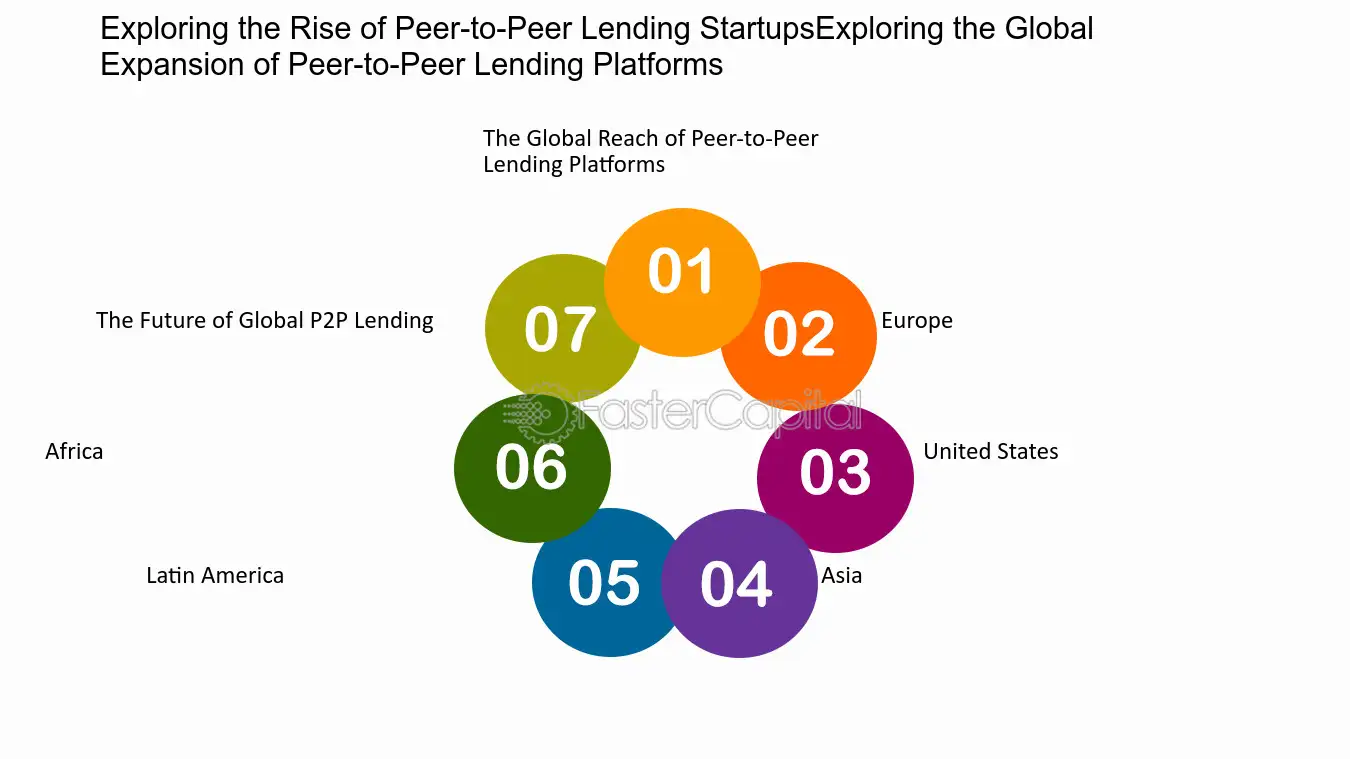
Exploring the Rise of Peer to Peer Lending Startups:Exploring the Global Expansion of Peer to Peer Lending Platforms - The Tech Disruption in Finance: Exploring the Rise of Peer to Peer Lending Startups
33. Exploring the Rise of Peer-to-Peer Lending Startups:The Future Outlook for Peer-to-Peer Lending Startups
1. Increased Regulation and Compliance Measures
As the peer-to-peer lending industry continues to grow and gain traction, it is inevitable that increased regulation and compliance measures will come into play. While this may seem like a hindrance to some startups, it is actually a positive development for the industry as a whole.
For example, in the UK, the Financial Conduct Authority (FCA) introduced new regulations in 2014 that required peer-to-peer lending platforms to meet certain standards and comply with strict rules. This has helped to improve transparency and protect consumers, ultimately boosting investor confidence and encouraging further growth in the sector.
2. Expansion into Niche Markets
One of the most exciting aspects of the future outlook for peer-to-peer lending startups is the potential for expansion into niche markets. As the industry matures, we can expect to see platforms emerge that cater specifically to certain industries or demographics.
For instance, there are already peer-to-peer lending platforms that focus on funding renewable energy projects, supporting small businesses, or facilitating loans for medical professionals. These niche platforms allow borrowers and lenders to connect more effectively, providing tailored solutions that traditional financial institutions may struggle to offer.
3. Integration of Artificial Intelligence and Big Data
The use of artificial intelligence (AI) and big data analytics is revolutionizing almost every sector, and peer-to-peer lending is no exception. By leveraging advanced algorithms and machine learning, startups in this space can better assess creditworthiness, mitigate risk, and match borrowers with lenders.
For example, Zopa, one of the largest peer-to-peer lending platforms in the UK, uses AI algorithms to analyze thousands of data points and make accurate lending decisions in real-time. This not only speeds up the loan application process but also improves the overall borrower experience.
4. global Expansion and Cross-border Lending
While peer-to-peer lending platforms have primarily focused on domestic markets, there is tremendous potential for global expansion and cross-border lending. As technology advances and regulatory barriers are overcome, startups can tap into a global pool of borrowers and lenders, creating a truly borderless lending ecosystem.
For instance, LendingClub, one of the largest peer-to-peer lending platforms in the United states, has already started to explore international opportunities. By partnering with local financial institutions and leveraging their technology platform, they have successfully expanded into countries like Canada and Germany.
5. Collaboration with Traditional Financial Institutions
Rather than being viewed as competitors, peer-to-peer lending startups are increasingly seen as potential partners by traditional financial institutions. This collaboration can bring mutual benefits, with startups gaining access to established customer bases and infrastructure, while banks can tap into the innovation and agility of fintech companies.
For example, Funding Circle, a leading peer-to-peer lending platform, has formed partnerships with several banks around the world. These collaborations allow banks to refer borrowers who may not meet their lending criteria to Funding Circle, providing a win-win situation for both parties.
In conclusion, the future outlook for peer-to-peer lending startups is promising. With increased regulation, expansion into niche markets, integration of AI and big data, global expansion, and collaboration with traditional financial institutions, the industry is set to continue disrupting the traditional finance landscape. By embracing these trends and evolving their business models, startups can position themselves for long-term success in the evolving peer-to-peer lending ecosystem.
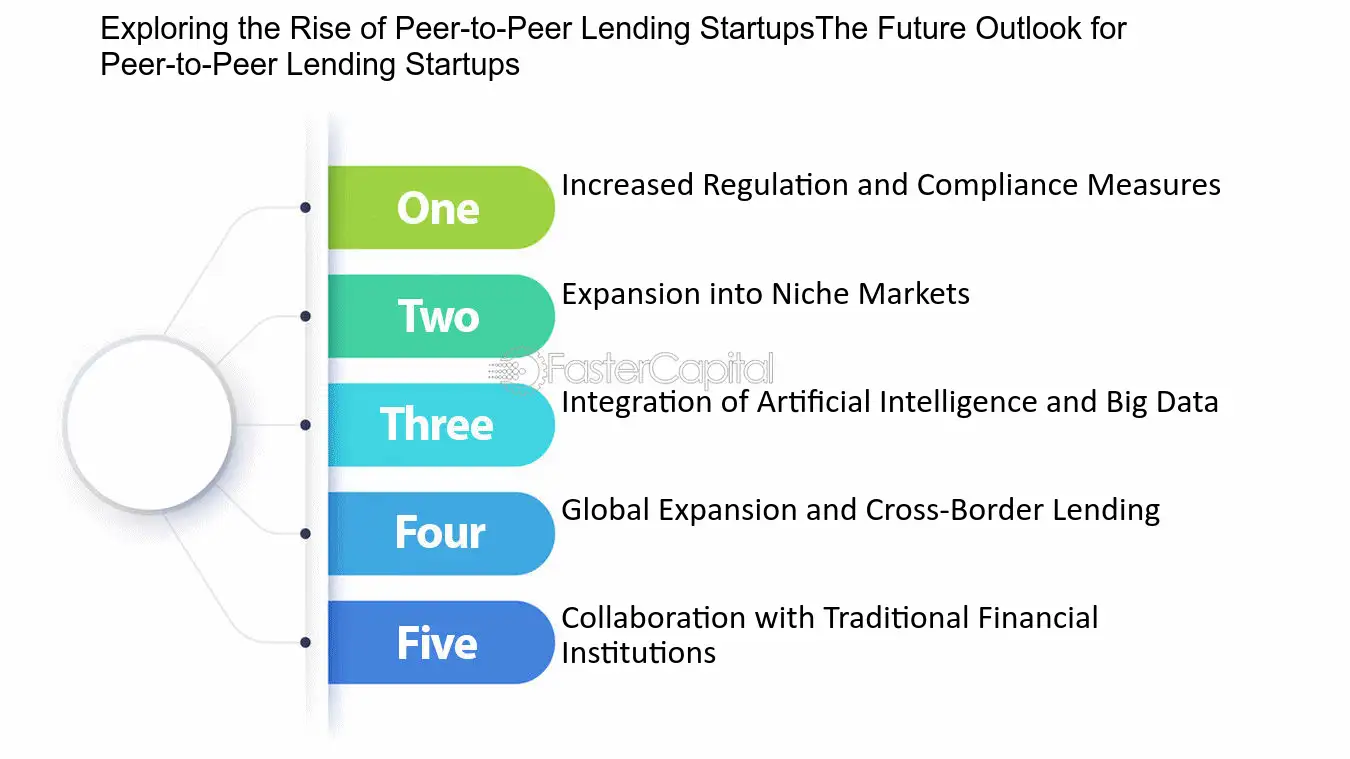
Exploring the Rise of Peer to Peer Lending Startups:The Future Outlook for Peer to Peer Lending Startups - The Tech Disruption in Finance: Exploring the Rise of Peer to Peer Lending Startups
34. The Rise of Peer-to-Peer Payments
The rise of Peer-to-peer Payments has revolutionized the way we transact and exchange money. With the advent of digital technology, individuals no longer need to rely on traditional banking systems or carry physical cash to make payments. Peer-to-peer payment platforms have emerged as a convenient and efficient alternative, allowing users to send and receive money instantly, anytime, anywhere. This blog post will delve into the concept of peer-to-peer payments, exploring its benefits, drawbacks, and the best options available in the market.
1. What are Peer-to-Peer Payments?
Peer-to-peer payments, also known as P2P payments, enable individuals to transfer funds directly to one another using a digital platform, bypassing the need for intermediaries such as banks. These transactions can be conducted through various channels, including mobile apps, online platforms, or even social media platforms. P2P payments have gained popularity due to their simplicity, speed, and convenience, making them an attractive option for individuals looking to split bills, reimburse friends, or make quick payments.
2. The benefits of Peer-to-peer Payments
- Convenience: P2P payments eliminate the need for physical cash or checks, allowing users to make transactions with just a few taps on their smartphones. This convenience is especially valuable in today's fast-paced world.
- Speed: Unlike traditional banking transfers, which may take several business days to process, P2P payments are typically instantaneous. This real-time transfer of funds ensures that recipients can access the money immediately, enhancing financial flexibility.
- Accessibility: Peer-to-peer payment platforms are often user-friendly and accessible to a wide range of individuals, regardless of their financial literacy or banking history. This inclusivity has made P2P payments a popular choice among the unbanked or underbanked populations.
- Security: Reputable P2P payment platforms employ robust security measures to protect users' personal and financial information. Features such as biometric authentication, encryption, and fraud detection algorithms ensure that transactions are secure and users' data remains confidential.
3. Drawbacks and Considerations
- Transaction Limits: Some P2P payment platforms impose limits on the amount of money that can be transferred within a certain period. This can be a hindrance for users who need to make larger transactions.
- Fees: While many P2P payment services offer free transfers, some platforms may charge fees for certain transactions or additional services. It's crucial to consider these costs when choosing a peer-to-peer payment option.
- Network Compatibility: Different P2P payment platforms may have varying levels of compatibility with other services or financial institutions. It's important to ensure that the platform you choose aligns with your existing banking relationships or integrates well with other tools you use.
4. Exploring the Best Options
- Venmo: Venmo is a widely popular P2P payment platform in the United States, known for its social media-like interface and seamless integration with users' existing contacts. It allows individuals to split bills, request payments, and make transactions effortlessly. However, it is limited to users within the U.S.
- PayPal: PayPal is a global leader in online payments, offering both P2P and merchant services. With its extensive network and widespread acceptance, PayPal is a versatile option for individuals and businesses alike. It allows for international transactions, making it a suitable choice for users across borders.
- M-Pesa: M-Pesa is a mobile money transfer service that originated in Kenya and has since expanded to several other African countries. It enables users to send and receive money, pay bills, and access other financial services through their mobile phones. M-Pesa's success lies in its seamless integration with existing mobile networks, making it accessible to a large population.
Peer-to-peer payments have undoubtedly transformed the way we handle financial transactions, offering convenience, speed, and accessibility. While each platform has its unique features and limitations, the best option ultimately depends on individual needs, geographical location, and existing banking relationships. As technology continues to evolve, peer-to-peer payments are expected to become even more prevalent, shaping the future of financial transactions.
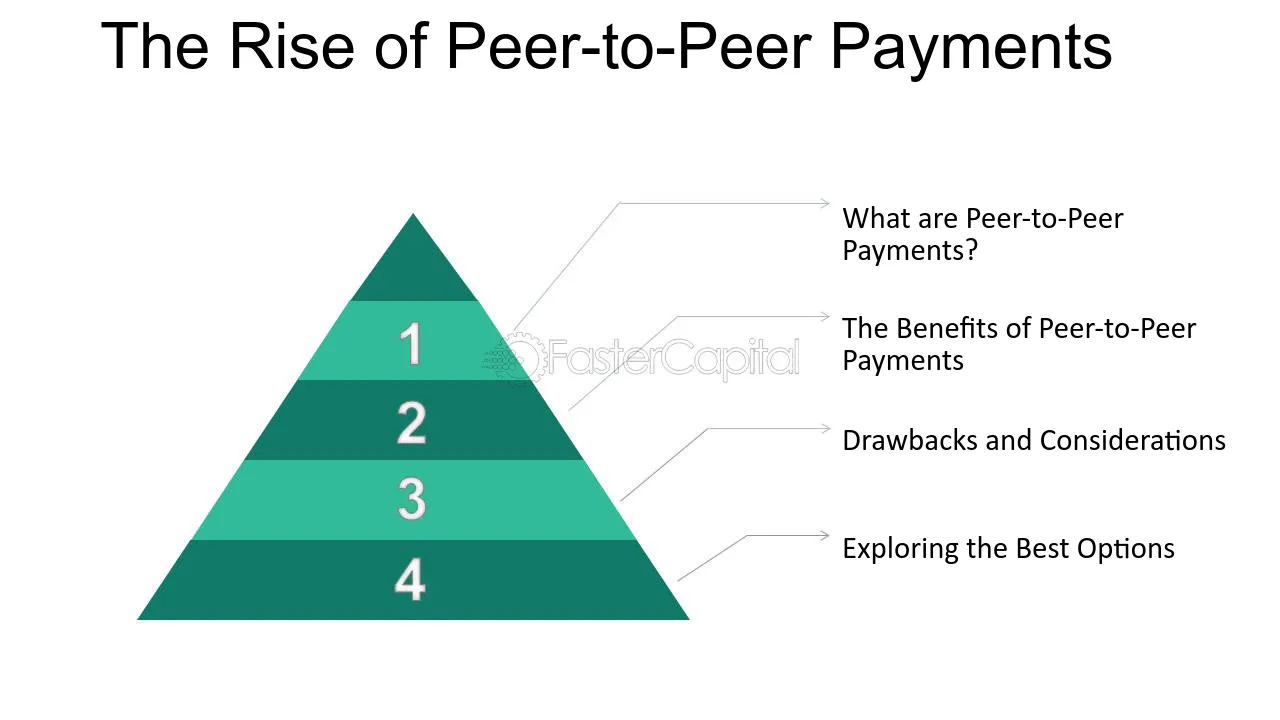
The Rise of Peer to Peer Payments - Transacting with Ease: M Pesa and the World of Peer to Peer Payments
35. Exploring the Rise of Peer-to-Peer Platforms for C2C Marketing
The rise of peer-to-peer platforms has been instrumental in facilitating and accelerating the growth of peer-to-peer selling in C2C marketing. These platforms act as intermediaries, connecting buyers and sellers, and providing the infrastructure for secure transactions.
3.1 Online Marketplaces:
Online marketplaces like eBay, Etsy, and Amazon Marketplace have played a significant role in popularizing peer-to-peer selling. These platforms provide a user-friendly interface for sellers to list their products and for buyers to browse and purchase items. They also offer features such as seller ratings, dispute resolution mechanisms, and integrated payment systems, ensuring a safe and seamless transaction experience.
4. maximizing Profit potential through Peer-to-Peer Selling in C2C Marketing
When it comes to maximizing profit potential through peer-to-peer selling in C2C marketing, several strategies can be employed. These strategies aim to optimize pricing, customer reach, and operational efficiency.
4.1. Pricing Strategies:
Pricing plays a crucial role in peer-to-peer selling, as sellers have the flexibility to set their own prices. To maximize profit, sellers should consider the following pricing strategies:
- Competitive Pricing: conduct thorough market research to understand the going rates for similar products or services. Price your offerings competitively to attract buyers while still ensuring a healthy profit margin.
- Dynamic Pricing: Consider implementing dynamic pricing, where prices fluctuate based on factors such as demand, seasonality, or availability. This strategy can help sellers capture maximum value and adjust prices in real-time to optimize revenue.
- Bundling and Upselling: Offering bundled packages or upselling complementary products or services can increase the average order value and boost profit potential. For example, a seller offering photography services could bundle prints, albums, or additional editing services to increase revenue per customer.
4.2. Expanding Customer Reach:
To maximize profit potential, sellers should aim to reach a larger customer base. Here are some strategies to achieve this:
- Optimize Product Listings: Pay attention to product descriptions, titles, and tags to ensure they are optimized for search engines and platforms' algorithms. Use relevant keywords and provide detailed information to increase visibility and attract potential customers.
- Leverage social media: Use social media platforms to promote your products or services, engage with your target audience, and build a loyal following. Share high-quality images, videos, and customer testimonials to showcase your offerings and encourage conversions.
- Collaborate with Influencers: Partner with influencers or micro-influencers in your niche to expand your reach and tap into their established audience. Influencers can help increase brand awareness and drive traffic to your listings, ultimately boosting sales.
4.3. Operational Efficiency:
Efficient operations are crucial for maximizing profit potential in peer-to-peer selling. Consider the following strategies:
- Streamline Order Processing: Optimize your order processing workflow to minimize manual errors, reduce shipping times, and improve customer satisfaction. Invest in inventory management software or fulfillment services to automate processes and ensure smooth operations.
- Offer Value-Added Services: Differentiate yourself from competitors by offering value-added services such as personalized packaging, handwritten thank-you notes, or freebies. These small touches can enhance the customer experience and generate positive reviews and repeat business.
- Establish Partnerships: Collaborate with other sellers or complementary businesses to cross-promote each other's offerings. This can help reach new audiences, boost sales, and reduce marketing costs.
By implementing these strategies, sellers can maximize their profit potential and create a sustainable and successful peer-to-peer selling business within the C2C marketing landscape.
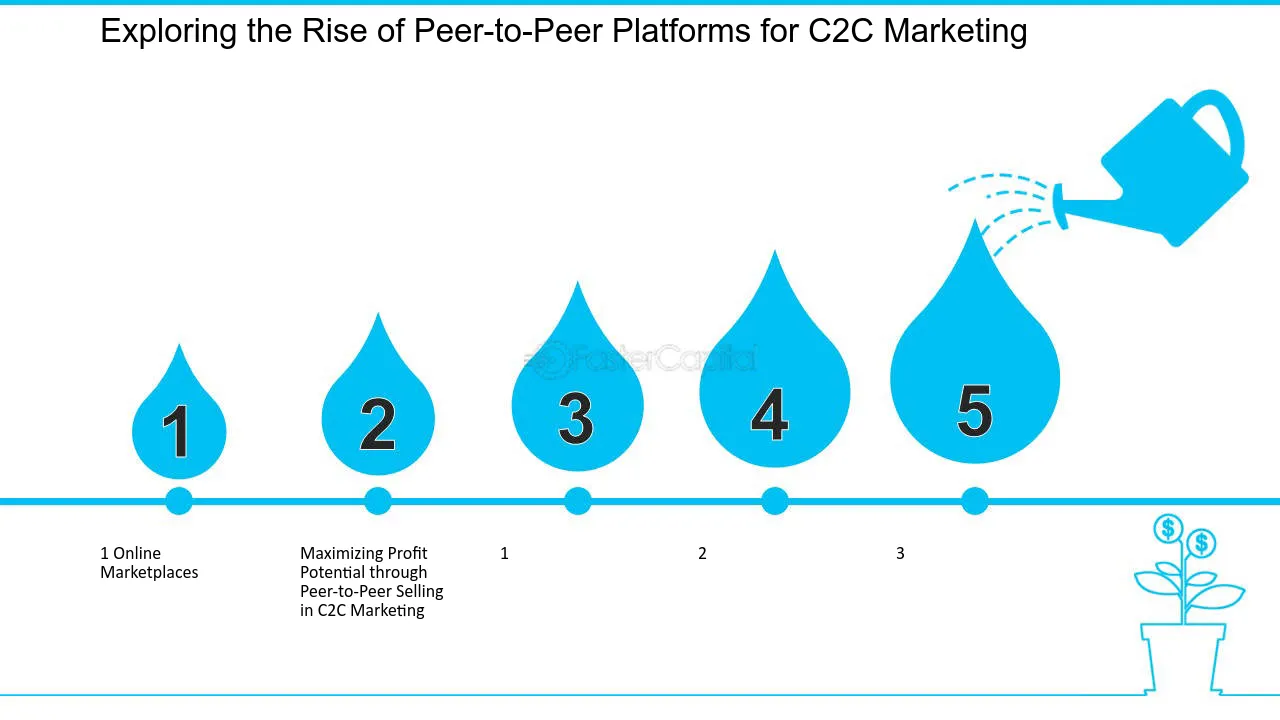
Exploring the Rise of Peer to Peer Platforms for C2C Marketing - Unleashing the Power of Peer to Peer Selling in C2C Marketing
36. Exploring the Rise of Peer-to-Peer Lending Startups:Introduction: The Evolution of Peer-to-Peer Lending
1. The Birth of Peer-to-Peer Lending
Peer-to-peer lending, often referred to as P2P lending, is a lending model that connects individuals or businesses in need of funds with investors willing to lend money. This concept originated in the early 2000s with the emergence of online platforms that facilitated direct lending between individuals, bypassing traditional financial intermediaries like banks.
2. The Catalyst: Financial Crisis of 2008
The financial crisis of 2008 played a significant role in the evolution of peer-to-peer lending. As traditional financial institutions tightened their lending criteria and interest rates skyrocketed, many borrowers found it increasingly difficult to secure loans. At the same time, savers were dissatisfied with the low returns offered by traditional savings accounts. This created a perfect storm for the rise of P2P lending, as it provided an alternative source of funding for borrowers and higher returns for investors.
3. The Advantages of Peer-to-Peer Lending
One of the key advantages of peer-to-peer lending is the ability to offer more competitive interest rates compared to traditional lenders. Since P2P lending platforms operate online and have lower overhead costs, they can pass on these savings to borrowers in the form of lower interest rates. This attracts borrowers who may have been turned away by banks due to their credit history or lack of collateral.
4. The Role of Technology
The rapid advancement of technology has played a pivotal role in the growth of peer-to-peer lending. Online platforms have made it easier for borrowers to apply for loans and for investors to contribute funds. These platforms also use sophisticated algorithms to assess the creditworthiness of borrowers, reducing the risk for lenders. Additionally, the use of blockchain technology has further enhanced transparency and security in P2P lending transactions.
5. The Expansion of Peer-to-Peer Lending
Over the years, peer-to-peer lending has expanded beyond personal loans to include various other types of lending, such as business loans, student loans, and even real estate crowdfunding. This has opened up new opportunities for borrowers and investors alike, allowing them to diversify their portfolios and achieve their financial goals.
6. The Rise of P2P Lending Startups
The success of peer-to-peer lending has led to the emergence of numerous P2P lending startups. These startups often differentiate themselves by focusing on niche markets or offering unique features. For example, some platforms specialize in small business loans, while others cater to borrowers with lower credit scores. This competition has driven innovation and further improved the overall experience for borrowers and investors.
In conclusion, the evolution of peer-to-peer lending can be attributed to a combination of factors, including the financial crisis of 2008, advancements in technology, and the advantages it offers to both borrowers and investors. With the continued growth of P2P lending startups and the increasing demand for alternative financing options, it is clear that peer-to-peer lending has become a significant player in the financial industry.
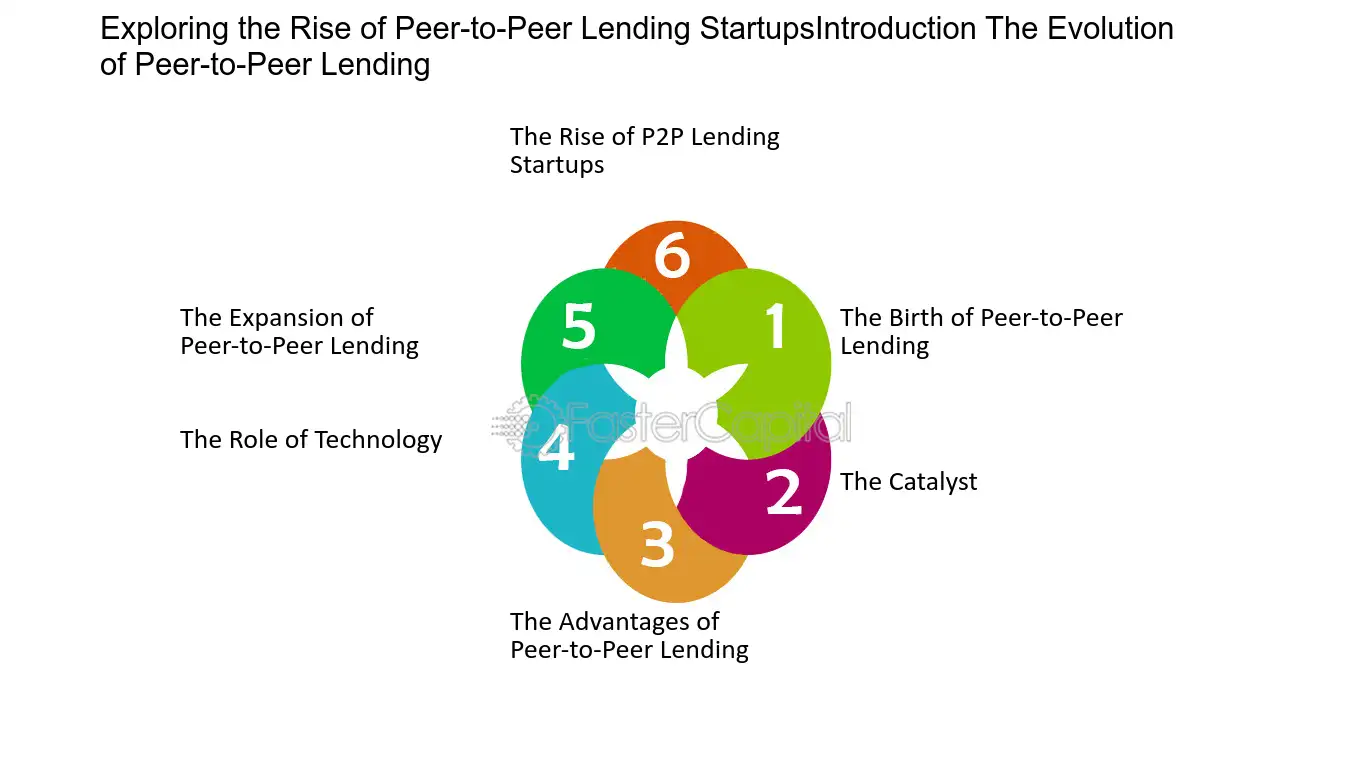
Exploring the Rise of Peer to Peer Lending Startups:Introduction: The Evolution of Peer to Peer Lending - Unlocking the Potential: Exploring the Rise of Peer to Peer Lending Startups
37. Exploring the Rise of Peer-to-Peer Lending Startups:Understanding the Concept: How Peer-to-Peer Lending Works
1. What is Peer-to-Peer Lending?
Peer-to-peer lending, also known as P2P lending, is a method of lending money directly to individuals or businesses through an online platform, without the involvement of traditional financial institutions such as banks or credit unions. It is a form of crowdfunding that connects borrowers and lenders directly.
2. How does it work?
In a peer-to-peer lending model, borrowers create a profile on the lending platform, detailing their borrowing needs and financial history. Lenders, on the other hand, can browse through these profiles and choose to lend money to borrowers based on their risk appetite and desired return on investment.
3. Assessing Borrower Creditworthiness
To ensure the safety of their investments, peer-to-peer lending platforms typically employ a rigorous credit assessment process. This involves analyzing various factors such as the borrower's credit score, income, employment history, and debt-to-income ratio. By evaluating these factors, lenders can make informed decisions about which borrowers to lend to.
For example, let's say John wants to borrow $10,000 to start a small business. He creates a profile on a peer-to-peer lending platform and provides all the necessary information about his business plan, financial history, and creditworthiness. Lenders on the platform review John's profile and decide whether to fund his loan based on their evaluation of his credibility.
4. Setting Interest Rates
Once a lender decides to fund a borrower's loan, they can set the interest rate at which they are willing to lend the money. This rate is usually based on the borrower's creditworthiness, the perceived risk of the loan, and the prevailing interest rates in the market. Peer-to-peer lending platforms often provide guidance on appropriate interest rates to help lenders make informed decisions.
Continuing the example, if a lender decides to lend $10,000 to John, they may offer an interest rate of 10%, considering factors such as John's creditworthiness and the perceived risk associated with his business venture.
5. Loan Repayment and Platform Fees
Borrowers repay their loans over a fixed period, usually through monthly installments. The repayment amount consists of both the principal amount borrowed and the interest accrued. Peer-to-peer lending platforms typically facilitate the repayment process, ensuring that lenders receive their repayments on time. In return for their services, these platforms charge fees to both borrowers and lenders.
For instance, if John's loan has a repayment period of 3 years, he would need to make monthly payments of principal and interest to his lenders through the peer-to-peer lending platform. The platform would then deduct its fees from these payments before distributing them to the lenders.
In conclusion, peer-to-peer lending offers an alternative method of lending and borrowing money, bypassing traditional financial institutions. By directly connecting borrowers and lenders, it provides opportunities for individuals and businesses to access funding and investors to earn attractive returns. Understanding the workings of peer-to-peer lending is crucial for anyone considering participating in this growing sector of the financial industry.

Exploring the Rise of Peer to Peer Lending Startups:Understanding the Concept: How Peer to Peer Lending Works - Unlocking the Potential: Exploring the Rise of Peer to Peer Lending Startups
38. Exploring the Rise of Peer-to-Peer Lending Startups:The Benefits of Peer-to-Peer Lending for Borrowers
1. Access to Funding Opportunities: One of the key benefits of peer-to-peer lending for borrowers is the access to funding opportunities that may not be available through traditional banking channels. Peer-to-peer lending platforms connect borrowers directly with individual lenders, allowing them to tap into a pool of potential investors who are willing to lend money at competitive interest rates. This can be particularly advantageous for borrowers who may not meet the strict eligibility criteria of traditional lenders.
For example, let's say you're a small business owner looking to expand your operations, but you have been turned down by banks due to lack of collateral or a short business history. With peer-to-peer lending, you can create a compelling loan listing detailing your business plan and financial projections, and potentially attract multiple investors who believe in your vision and are willing to provide the necessary funding.
2. Quick and Convenient Application Process: Peer-to-peer lending platforms offer a streamlined and user-friendly application process, making it easier and more convenient for borrowers to secure financing. Unlike traditional banking institutions, which often involve lengthy paperwork and complex approval processes, peer-to-peer lending platforms allow borrowers to apply online and receive funding decisions within a matter of days or even hours.
For instance, imagine you need funds urgently to cover unexpected medical expenses. Instead of going through the hassle of visiting multiple banks and filling out numerous forms, you can simply create a loan listing on a peer-to-peer lending platform, outline your situation, and wait for potential lenders to review and fund your loan. This streamlined process can save valuable time and provide borrowers with the necessary funds when they need them most.
3. Competitive Interest Rates: Peer-to-peer lending can offer borrowers competitive interest rates compared to traditional lending options. Since peer-to-peer lending platforms eliminate the need for intermediaries like banks, borrowers can often benefit from lower interest rates and fees. This is because lenders on peer-to-peer platforms are often individuals or institutional investors seeking higher returns than what they would typically earn from traditional investments.
For example, let's say you're looking to consolidate your high-interest credit card debt. By securing a peer-to-peer loan, you may be able to pay off your credit card balances at a lower interest rate, potentially saving thousands of dollars in interest payments over time. This can help borrowers reduce their overall debt burden and achieve financial freedom more quickly.
4. Flexible Terms and Repayment Options: Peer-to-peer lending allows borrowers to negotiate loan terms and repayment options that best suit their individual needs. Unlike traditional lenders who often impose rigid repayment schedules, borrowers and lenders on peer-to-peer platforms can work together to set loan durations, interest rates, and repayment plans that are mutually beneficial.
For instance, let's say you're a freelance professional with irregular income streams. With peer-to-peer lending, you can discuss your unique financial situation with potential lenders and come up with a repayment plan that aligns with your cash flow. This flexibility can provide borrowers with peace of mind and help them manage their finances more effectively.
In conclusion, peer-to-peer lending offers several benefits for borrowers, including access to funding opportunities, a quick and convenient application process, competitive interest rates, and flexible loan terms. By leveraging the power of technology and connecting borrowers directly with lenders, peer-to-peer lending platforms are revolutionizing the lending landscape and providing borrowers with alternative financing options.
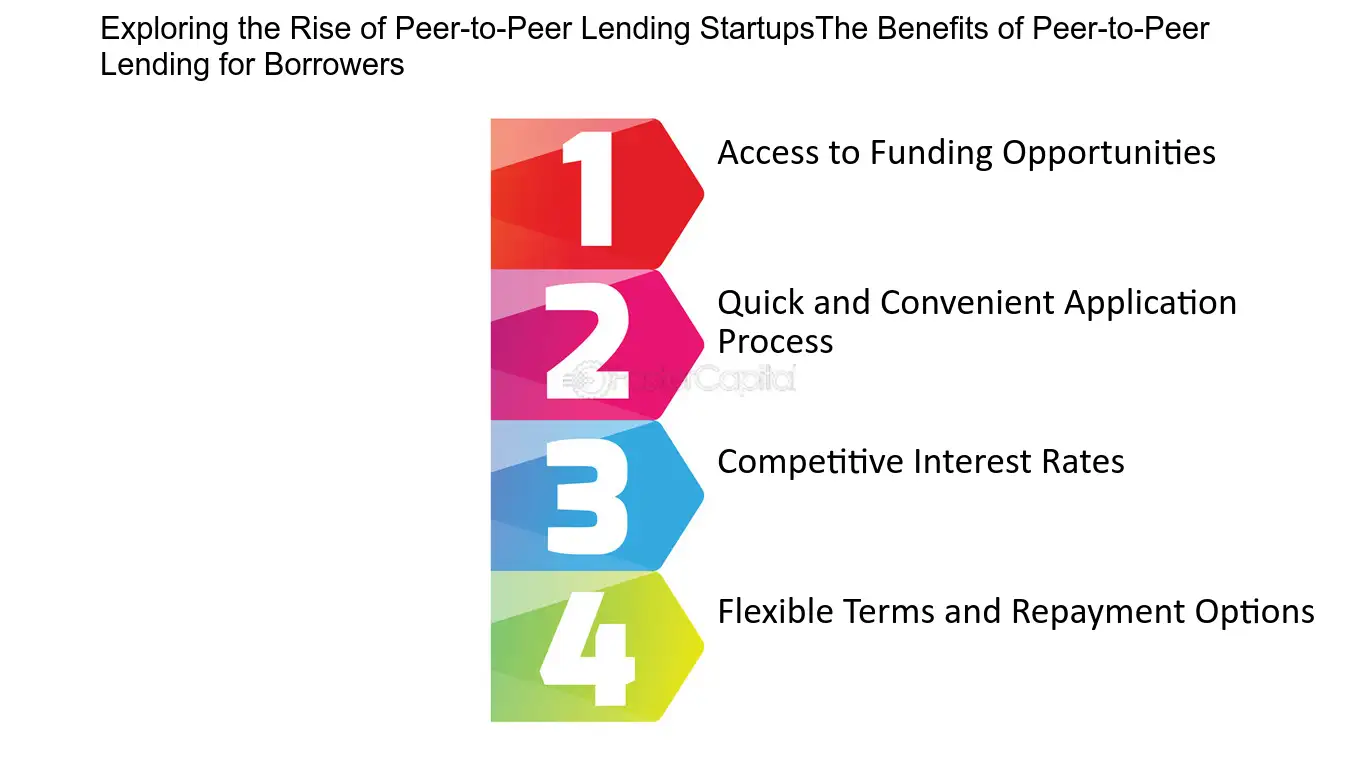
Exploring the Rise of Peer to Peer Lending Startups:The Benefits of Peer to Peer Lending for Borrowers - Unlocking the Potential: Exploring the Rise of Peer to Peer Lending Startups
39. Exploring the Rise of Peer-to-Peer Lending Startups:The Benefits of Peer-to-Peer Lending for Investors
1. Diversification of Investment Portfolio
Peer-to-peer lending allows investors to diversify their investment portfolios by allocating their funds across a wide range of loans. This diversification helps reduce the risk associated with investing in a single asset class or industry. For example, an investor can choose to lend a portion of their funds to borrowers in the real estate sector, while another portion can be allocated to borrowers in the small business sector. By spreading their investments across different borrowers and sectors, investors can minimize the impact of any potential defaults and enjoy a more stable return on investment.
2. Higher Returns Compared to Traditional Investments
One of the key benefits of peer-to-peer lending for investors is the potential for higher returns compared to traditional investments such as stocks, bonds, or savings accounts. In a low-interest-rate environment, investors often struggle to find investments that offer attractive returns. Peer-to-peer lending platforms, on the other hand, provide an opportunity to earn higher interest rates by directly lending to borrowers. For instance, an investor may earn an annual interest rate of 8% on a peer-to-peer lending platform, while the average savings account offers only a fraction of that return. This higher return potential can significantly boost an investor's overall portfolio performance.
3. Access to a New Asset Class
Peer-to-peer lending offers investors access to a new asset class that was traditionally reserved for banks and financial institutions. This democratization of lending allows individual investors to participate in the lending market and benefit from the interest income generated by their loans. Through peer-to-peer lending platforms, investors can choose the loans they want to fund based on their risk appetite and investment goals. This level of control and transparency is empowering for investors who want to diversify their portfolios beyond traditional investments.
4. Passive Income Generation
Peer-to-peer lending can also provide investors with a passive income stream. Once an investor has allocated their funds to loans on a peer-to-peer lending platform, they can sit back and earn interest on their investments without active involvement. Unlike other investment options that require constant monitoring and decision-making, peer-to-peer lending allows investors to earn passive income while focusing on other aspects of their lives. This passive income stream can be particularly attractive for individuals looking to supplement their regular income or build a steady stream of cash flow for retirement.
5. Mitigation of Market Volatility
Investing in the stock market can be volatile, with prices fluctuating based on various factors such as economic conditions, company performance, and geopolitical events. Peer-to-peer lending, on the other hand, offers a relatively stable investment option with predictable returns. Since the interest rates on loans are fixed, investors can rely on a steady stream of income regardless of market conditions. This stability can help investors weather market downturns and reduce the overall volatility of their investment portfolio.
In conclusion, peer-to-peer lending provides investors with several benefits, including diversification, higher returns, access to a new asset class, passive income generation, and mitigation of market volatility. By understanding the potential advantages of peer-to-peer lending, investors can make informed decisions and unlock the potential of this rising investment opportunity.
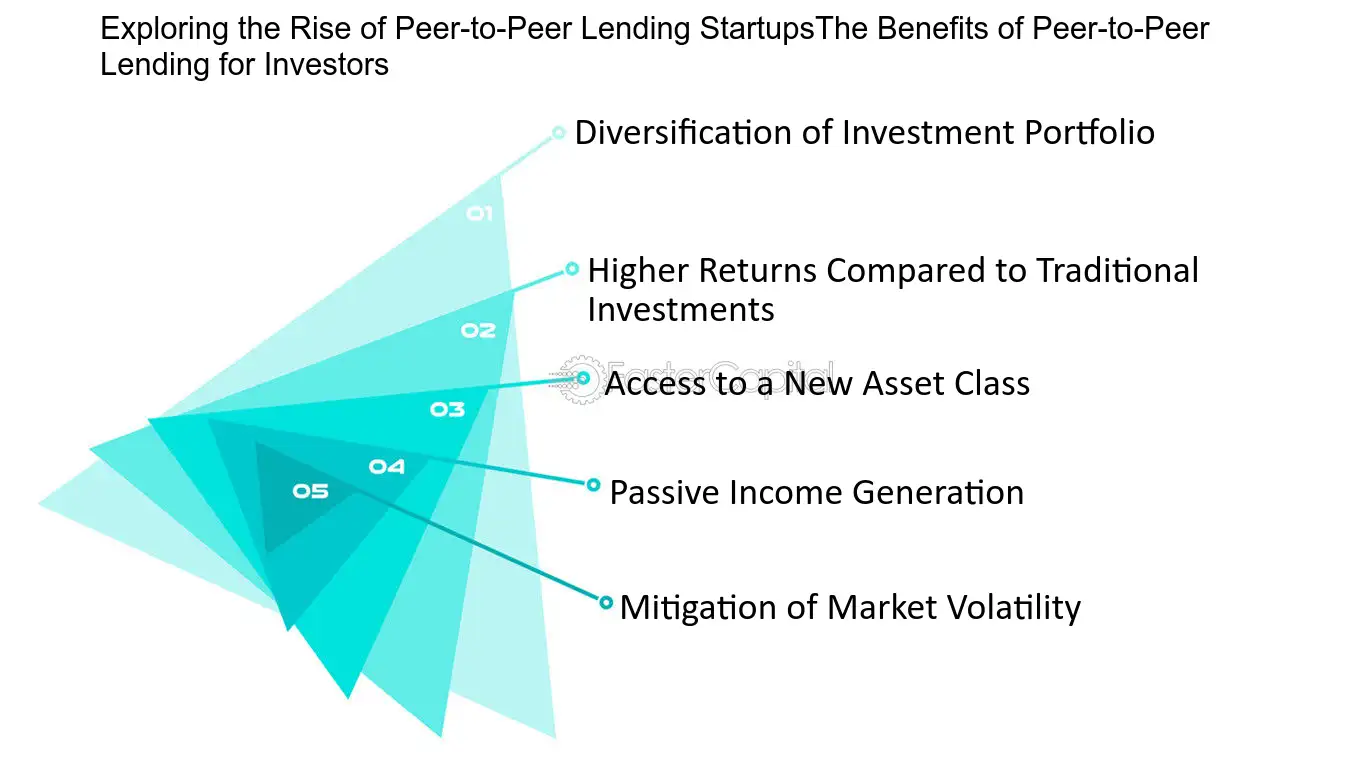
Exploring the Rise of Peer to Peer Lending Startups:The Benefits of Peer to Peer Lending for Investors - Unlocking the Potential: Exploring the Rise of Peer to Peer Lending Startups
40. Exploring the Rise of Peer-to-Peer Lending Startups:Exploring the Growth of Peer-to-Peer Lending Startups
1. Embracing Technology: The Foundation of Peer-to-Peer Lending Startups
Peer-to-peer lending startups have revolutionized the financial industry by leveraging technology to create a decentralized lending marketplace. With the advent of online platforms, borrowers and lenders can connect directly, eliminating the need for traditional banking intermediaries. This technological innovation has opened up a world of possibilities, allowing individuals and businesses to access loans quickly and easily.
2. Cutting Out the Middleman: Lowering Costs and Increasing Efficiency
One of the significant advantages of peer-to-peer lending startups is the reduction in costs compared to traditional lending institutions. By cutting out the middleman, these platforms can offer lower interest rates to borrowers while providing attractive returns to lenders. This efficient model eliminates the overhead costs associated with brick-and-mortar banks, making it an attractive alternative for both borrowers and lenders.
For example, platforms like LendingClub and Prosper have disrupted the personal loan market by connecting borrowers directly with individual investors. By streamlining the lending process, they can offer competitive interest rates and flexible terms, making it easier for individuals to access funds for various purposes, such as debt consolidation, home improvements, or starting a small business.
3. Democratizing Access to Credit: Opening Doors for Underserved Borrowers
Peer-to-peer lending startups have also played a crucial role in democratizing access to credit. Traditional banks often have strict lending criteria, making it challenging for individuals with limited credit history or lower credit scores to secure loans. However, peer-to-peer lending platforms have adopted more inclusive underwriting models, allowing a broader range of borrowers to access much-needed funds.
For instance, platforms like Zopa and Funding Circle have focused on providing loans to small businesses that may have struggled to secure financing from traditional sources. By leveraging alternative data sources and innovative credit scoring techniques, these platforms can assess creditworthiness beyond traditional metrics, providing opportunities to entrepreneurs who may have been overlooked by traditional banks.
4. Diversification Opportunities for Investors: spreading Risk and maximizing Returns
Peer-to-peer lending startups have also attracted investors looking to diversify their portfolios and generate attractive returns. By investing in a diverse range of loans, investors can spread their risk across multiple borrowers and industries, reducing their exposure to any individual loan default. This diversification strategy has the potential to deliver consistent returns and mitigate the impact of any potential defaults.
For example, platforms like Mintos and Bondora offer investors the opportunity to invest in loans originated from various countries and sectors. Investors can choose their risk appetite and allocate their funds accordingly, creating a diversified portfolio of loans with different interest rates and risk profiles.
In conclusion, the growth of peer-to-peer lending startups has been fueled by their ability to leverage technology, cut out traditional intermediaries, democratize access to credit, and offer attractive opportunities for investors. As these platforms continue to innovate and refine their models, they are likely to play an increasingly significant role in the financial industry, reshaping the way individuals and businesses access and invest capital.
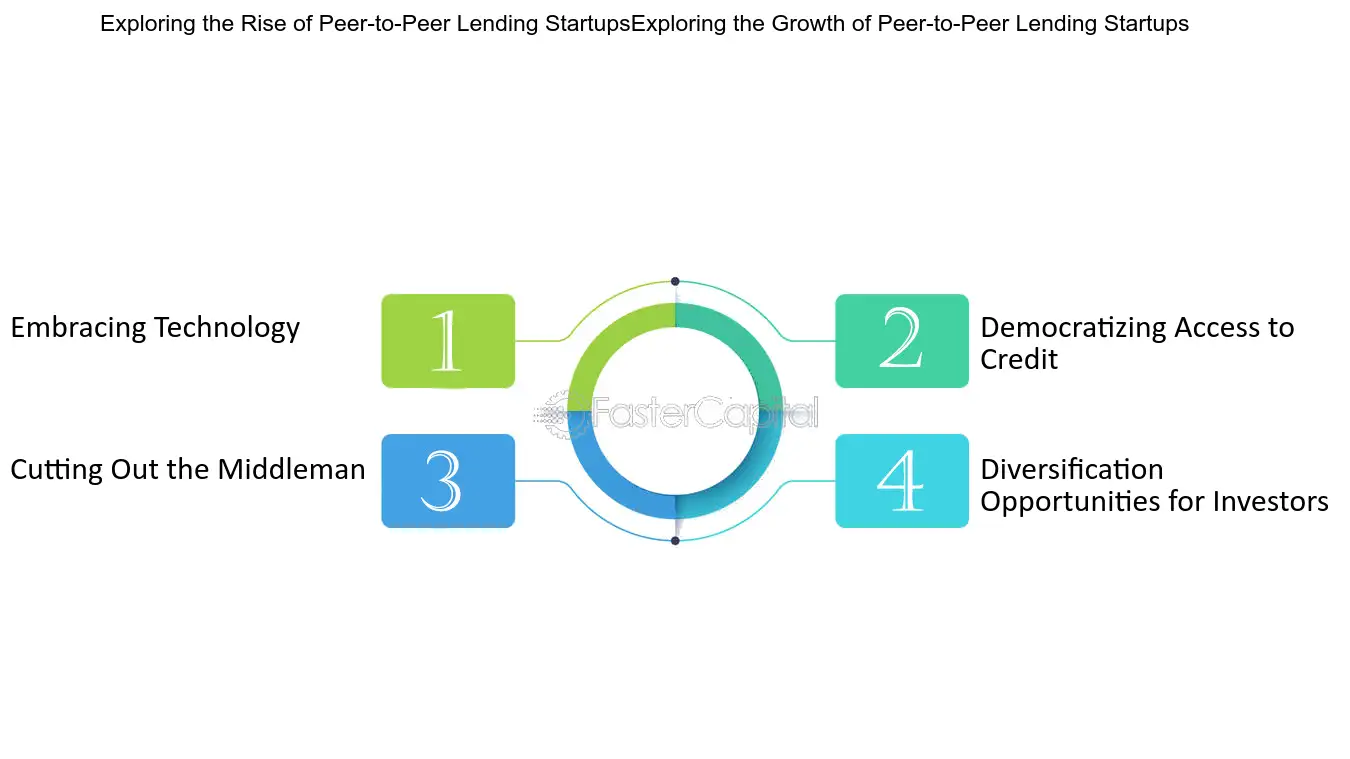
Exploring the Rise of Peer to Peer Lending Startups:Exploring the Growth of Peer to Peer Lending Startups - Unlocking the Potential: Exploring the Rise of Peer to Peer Lending Startups
41. Exploring the Rise of Peer-to-Peer Lending Startups:Key Players in the Peer-to-Peer Lending Industry
1. LendingClub:
LendingClub is one of the most well-known and established players in the peer-to-peer lending industry. Founded in 2006, LendingClub has facilitated over $50 billion in loans to borrowers across the United States. The platform connects borrowers with individual investors, allowing them to bypass traditional banks and obtain loans at potentially lower interest rates. LendingClub uses advanced technology and data analytics to assess borrower creditworthiness and assign appropriate interest rates. It offers personal loans, business loans, and auto refinancing options, making it a versatile choice for borrowers.
2. Prosper:
Prosper is another prominent player in the peer-to-peer lending space. Founded in 2005, Prosper has facilitated over $17 billion in loans to borrowers across the United States. Similar to LendingClub, Prosper connects borrowers with individual investors, providing a platform for lending and borrowing outside of the traditional banking system. Prosper offers personal loans for various purposes, including debt consolidation, home improvement, and medical expenses. The platform utilizes a proprietary credit rating system to assess borrower creditworthiness, enabling it to offer competitive interest rates to borrowers.
3. Funding Circle:
Funding Circle is a leading peer-to-peer lending platform focused on small business loans. Founded in 2010, Funding Circle has facilitated over $11 billion in loans globally, with operations in the United States, United Kingdom, Germany, and the Netherlands. The platform connects small business owners with investors who are looking to lend to businesses. Funding Circle's technology-driven approach allows for quick loan approval and funding, making it an attractive option for small businesses in need of financing. With its wide range of loan products and fast application process, Funding Circle has become a go-to platform for small business owners seeking alternative funding options.
4. Upstart:
Upstart is a unique player in the peer-to-peer lending industry, as it focuses on using artificial intelligence and machine learning algorithms to assess borrower creditworthiness. Founded in 2012, Upstart has facilitated over $8 billion in loans. The platform considers factors beyond traditional credit scores, such as education, work experience, and even academic performance, to evaluate a borrower's potential for future financial success. Upstart offers personal loans for various purposes, including credit card refinancing, debt consolidation, and home improvement. Its innovative approach to underwriting sets it apart from other players in the industry.
5. SoFi:
SoFi, short for Social Finance, is a peer-to-peer lending platform that primarily focuses on student loan refinancing and personal loans. Founded in 2011, SoFi has facilitated over $50 billion in loans. The platform offers competitive interest rates and flexible repayment options for borrowers looking to refinance their student loans or obtain personal loans for various purposes. SoFi's unique selling proposition lies in its community-centric approach, offering borrowers access to networking events, career services, and financial education resources. With its emphasis on building a strong community of borrowers, SoFi has gained a loyal customer base and continues to be a key player in the peer-to-peer lending industry.
These are just a few examples of the key players in the peer-to-peer lending industry. As the industry continues to grow and evolve, more players are entering the market, offering innovative loan products and services. Peer-to-peer lending has disrupted the traditional banking sector by providing borrowers with alternative lending options and investors with attractive investment opportunities. With its potential to lower borrowing costs and increase access to credit, peer-to-peer lending is undoubtedly a trend to watch in the financial services industry.
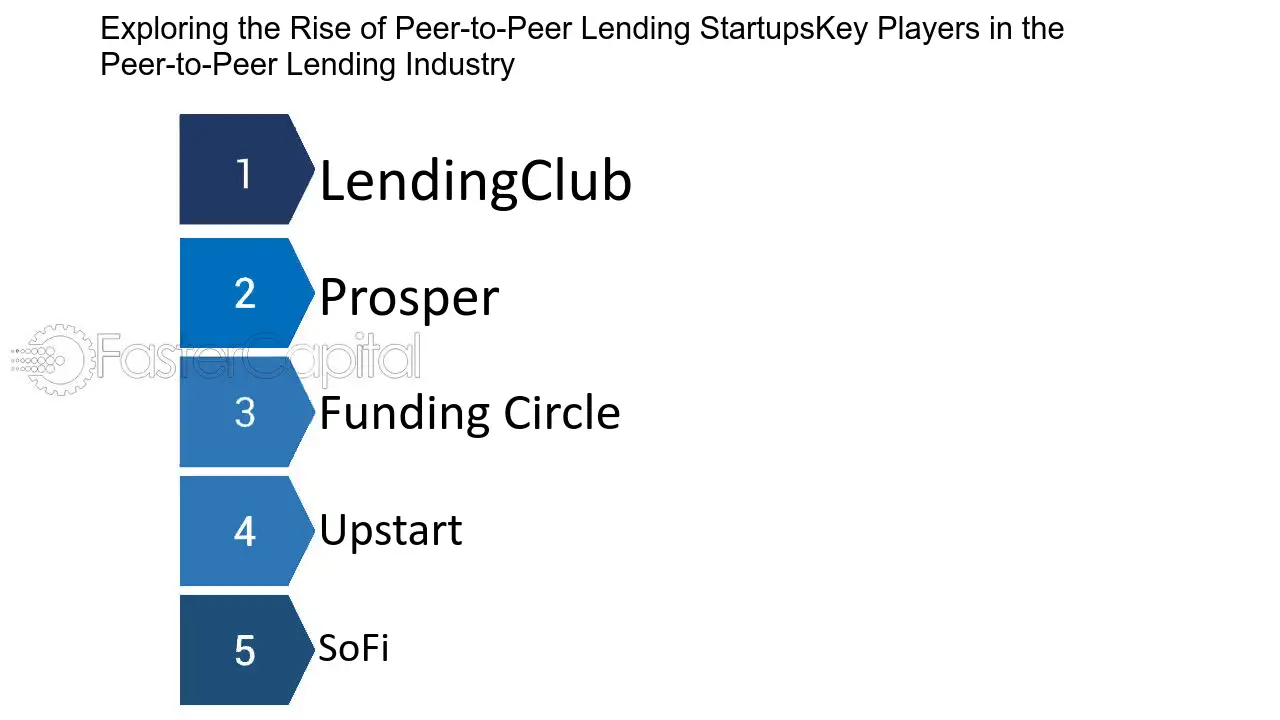
Exploring the Rise of Peer to Peer Lending Startups:Key Players in the Peer to Peer Lending Industry - Unlocking the Potential: Exploring the Rise of Peer to Peer Lending Startups
42. Exploring the Rise of Peer-to-Peer Lending Startups:Challenges and Risks in Peer-to-Peer Lending
1. Credit Risk:
One of the significant challenges in peer-to-peer lending is the credit risk involved. Since peer-to-peer lending platforms connect individual borrowers with individual lenders, there is no involvement of traditional financial institutions to assess the creditworthiness of borrowers. This lack of professional credit assessment increases the risk of default for lenders. For example, if a borrower fails to repay the loan, the lender may suffer financial losses.
2. Lack of Regulation:
Another challenge in peer-to-peer lending is the relatively new and evolving regulatory environment. Unlike traditional banking institutions that are subject to strict regulations, peer-to-peer lending platforms often operate in a less regulated space. This lack of regulation can lead to potential risks for both lenders and borrowers. For instance, there may be less protection for borrowers in case of unfair lending practices or deceptive advertising.
3. Platform Reliability:
The success of peer-to-peer lending heavily relies on the reliability and efficiency of the online platforms that facilitate the transactions. Technical glitches, server downtime, or cyber-attacks can significantly impact the functioning of these platforms. For instance, if a lending platform experiences a prolonged outage, lenders may not be able to access their funds or make new investments, causing potential financial losses.
4. Inadequate Diversification:
Diversification is a crucial risk management strategy in any investment portfolio, including peer-to-peer lending. However, achieving adequate diversification can be challenging, especially for individual lenders with limited capital. If lenders do not diversify their investments across a wide range of borrowers, they may face higher default risks. For example, if a lender invests a significant amount in a single borrower who defaults on the loan, the entire investment may be at risk.
5. Economic Downturns:
Peer-to-peer lending can be particularly vulnerable to economic downturns. During periods of economic instability, borrowers may face difficulties in repaying their loans, leading to increased default rates. This, in turn, can adversely affect the returns for lenders. For instance, if an economic recession causes a spike in unemployment rates, borrowers may struggle to meet their financial obligations, resulting in higher default rates for lenders.
6. Lack of Secondary Market:
Unlike traditional investments like stocks or bonds, peer-to-peer loans often lack a well-established secondary market. This means that lenders may face challenges in selling their loan investments before the loan term expires. Without a liquid secondary market, lenders may find it difficult to exit their investments early in case of financial emergencies or changing investment strategies.
In conclusion, while peer-to-peer lending offers exciting opportunities for both borrowers and lenders, it also comes with its fair share of challenges and risks. It is essential for individuals considering participating in peer-to-peer lending to carefully assess and understand these risks to make informed investment decisions.
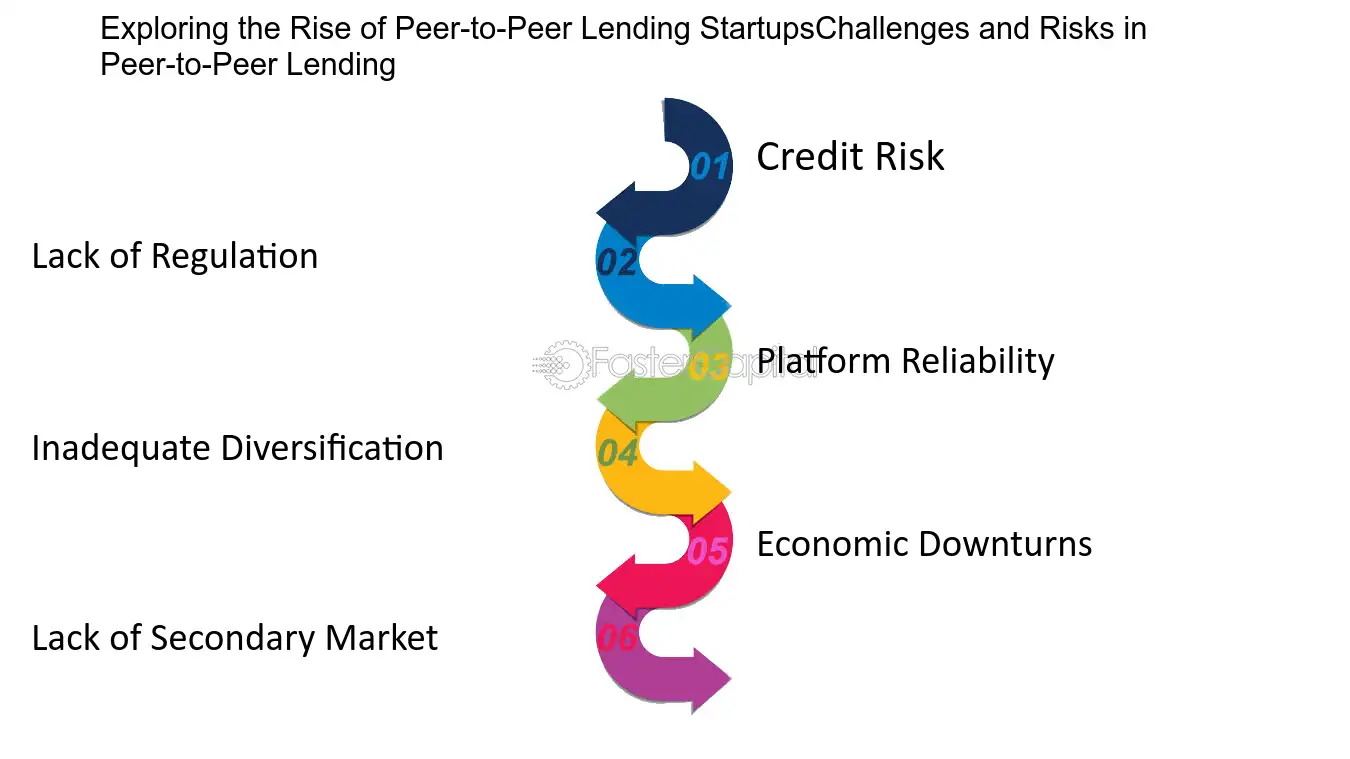
Exploring the Rise of Peer to Peer Lending Startups:Challenges and Risks in Peer to Peer Lending - Unlocking the Potential: Exploring the Rise of Peer to Peer Lending Startups
43. Exploring the Rise of Peer-to-Peer Lending Startups:Regulation and Legal Considerations for Peer-to-Peer Lending Startups
1. Understanding the Regulatory Landscape
When it comes to starting a peer-to-peer lending startup, it is crucial to have a solid understanding of the regulatory landscape. Peer-to-peer lending platforms operate in a highly regulated environment, and failure to comply with the relevant laws and regulations can lead to severe consequences.
2. Securities Regulations
One of the key areas of regulation for peer-to-peer lending startups is securities regulations. In many jurisdictions, loans offered through P2P lending platforms are considered securities and are subject to securities laws. This means that P2P lending startups must comply with registration requirements, disclosure obligations, and investor suitability rules.
For example, in the United States, the securities and Exchange commission (SEC) regulates P2P lending platforms under the securities act of 1933 and the Securities Exchange Act of 1934. Platforms must register with the SEC as a funding portal or a broker-dealer, and they must adhere to strict disclosure requirements.
3. Consumer Protection Laws
Consumer protection laws are another crucial aspect for P2P lending startups to consider. These laws are designed to protect borrowers from unfair lending practices and to ensure that lenders provide clear and transparent information about the terms of the loan.
For instance, in the United Kingdom, the Financial Conduct Authority (FCA) regulates P2P lending platforms under the Consumer Credit Act 1974. Platforms must obtain an authorization from the FCA and comply with various rules, including conducting affordability assessments, providing clear and fair information to borrowers, and resolving customer complaints in a timely manner.
4. anti-Money laundering (AML) and Know Your Customer (KYC) Requirements
Peer-to-peer lending startups are also subject to anti-money laundering (AML) and know your customer (KYC) requirements, which are aimed at preventing money laundering and terrorist financing. These requirements typically involve verifying the identity of borrowers and lenders and conducting due diligence on their transactions.
For example, in Australia, P2P lending platforms must comply with the Anti-Money Laundering and Counter-Terrorism Financing Act 2006. This includes implementing risk-based AML programs, conducting customer due diligence, and reporting suspicious transactions to the financial intelligence unit.
5. Data Privacy and Security
Data privacy and security are of utmost importance in the peer-to-peer lending industry. P2P lending startups handle sensitive personal and financial information, and they must have robust data protection measures in place to safeguard this information from unauthorized access or disclosure.
For instance, the General Data Protection Regulation (GDPR) in the European Union sets strict rules for the collection, processing, and storage of personal data. P2P lending platforms operating in the EU must comply with these regulations and take necessary steps to protect the privacy of their users.
In conclusion, peer-to-peer lending startups must navigate a complex web of regulations and legal considerations. Understanding and complying with securities regulations, consumer protection laws, AML and KYC requirements, and data privacy and security regulations are essential for the success and sustainability of these startups. By doing so, P2P lending platforms can build trust with both borrowers and lenders and create a safe and transparent lending environment.
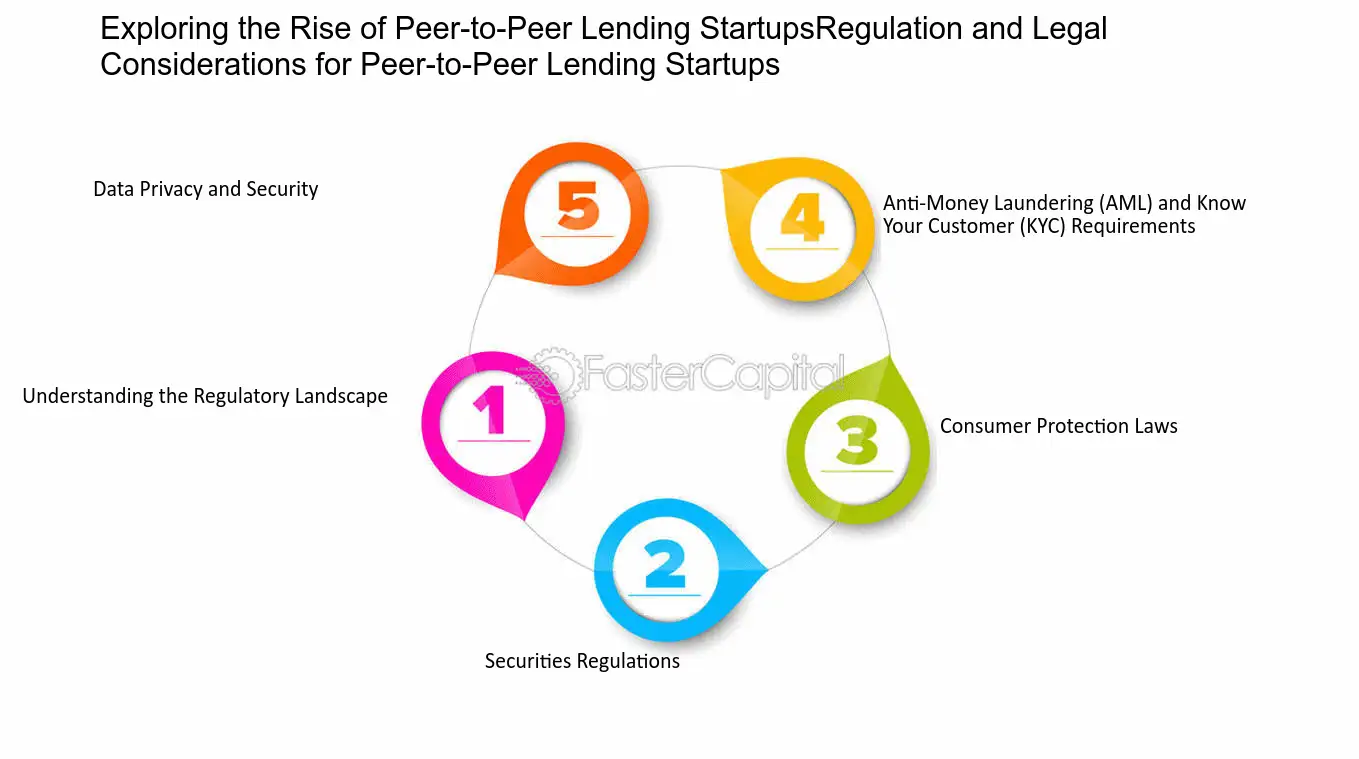
Exploring the Rise of Peer to Peer Lending Startups:Regulation and Legal Considerations for Peer to Peer Lending Startups - Unlocking the Potential: Exploring the Rise of Peer to Peer Lending Startups
44. Exploring the Rise of Peer-to-Peer Lending Startups:Innovations and Technological Advancements in Peer-to-Peer Lending
1. AI-Powered Credit Scoring Systems
One of the most significant innovations in peer-to-peer lending is the use of artificial intelligence (AI) in credit scoring systems. Traditional lenders rely heavily on credit scores and financial history to assess a borrower's creditworthiness. However, peer-to-peer lending platforms are leveraging AI algorithms to analyze a wider range of data points, including social media activity, online purchase history, and even smartphone usage patterns.
For example, companies like Upstart and LendingClub are using machine learning algorithms to identify patterns and trends that can help predict a borrower's likelihood of default. This allows them to make more accurate lending decisions and offer loans to borrowers who may have been overlooked by traditional lenders.
2. Blockchain Technology for Secure and Transparent Transactions
Blockchain technology has emerged as a game-changer in the financial industry, and peer-to-peer lending is no exception. By leveraging blockchain, lending platforms can create a secure and transparent environment for borrowers and lenders.
For instance, platforms like Lendingblock are using blockchain to facilitate peer-to-peer lending in the cryptocurrency space. Blockchain ensures that all transactions are recorded on a decentralized ledger, making it virtually impossible to alter or manipulate the data. This level of transparency builds trust among borrowers and lenders, reducing the risk of fraud and enhancing the overall security of the lending process.
3. Automated Loan Origination and Underwriting
Traditionally, loan origination and underwriting processes have been time-consuming and cumbersome, involving extensive paperwork and manual verification. However, advancements in technology have streamlined these processes, making them more efficient and cost-effective.
Fintech startups like Prosper and SoFi are using automated loan origination and underwriting systems to expedite the lending process. These systems use algorithms to analyze borrower data, verify information, and generate loan offers in real-time. This not only reduces the time it takes to get a loan approved but also ensures consistency and fairness in the decision-making process.
4. Peer-to-Peer Lending Apps for Mobile Accessibility
The rise of smartphones has revolutionized the way we access information and conduct transactions. Peer-to-peer lending platforms have capitalized on this trend by developing mobile apps that make borrowing and lending more accessible than ever before.
For example, platforms like Zopa and Funding Circle have launched mobile apps that allow users to apply for loans, view investment opportunities, and track their portfolio on the go. These apps provide a seamless user experience and enable borrowers and lenders to stay connected and updated at all times.
5. integration of Big data Analytics
Peer-to-peer lending platforms generate vast amounts of data on borrower behavior, loan performance, and market trends. By harnessing the power of big data analytics, these platforms can gain valuable insights that can inform their lending strategies and improve risk assessment.
Companies like LenddoEFL and LendUp are using big data analytics to identify patterns and correlations that can help them make more informed lending decisions. By analyzing data from various sources, including social media, utility bills, and credit card transactions, these platforms can assess a borrower's creditworthiness more accurately.
In conclusion, innovations and technological advancements in peer-to-peer lending are transforming the landscape of the financial industry. From AI-powered credit scoring systems to blockchain technology and mobile apps, these innovations are making borrowing and lending more accessible, secure, and efficient than ever before. As the industry continues to evolve, we can expect to see even more groundbreaking innovations that will unlock the full potential of peer-to-peer lending.
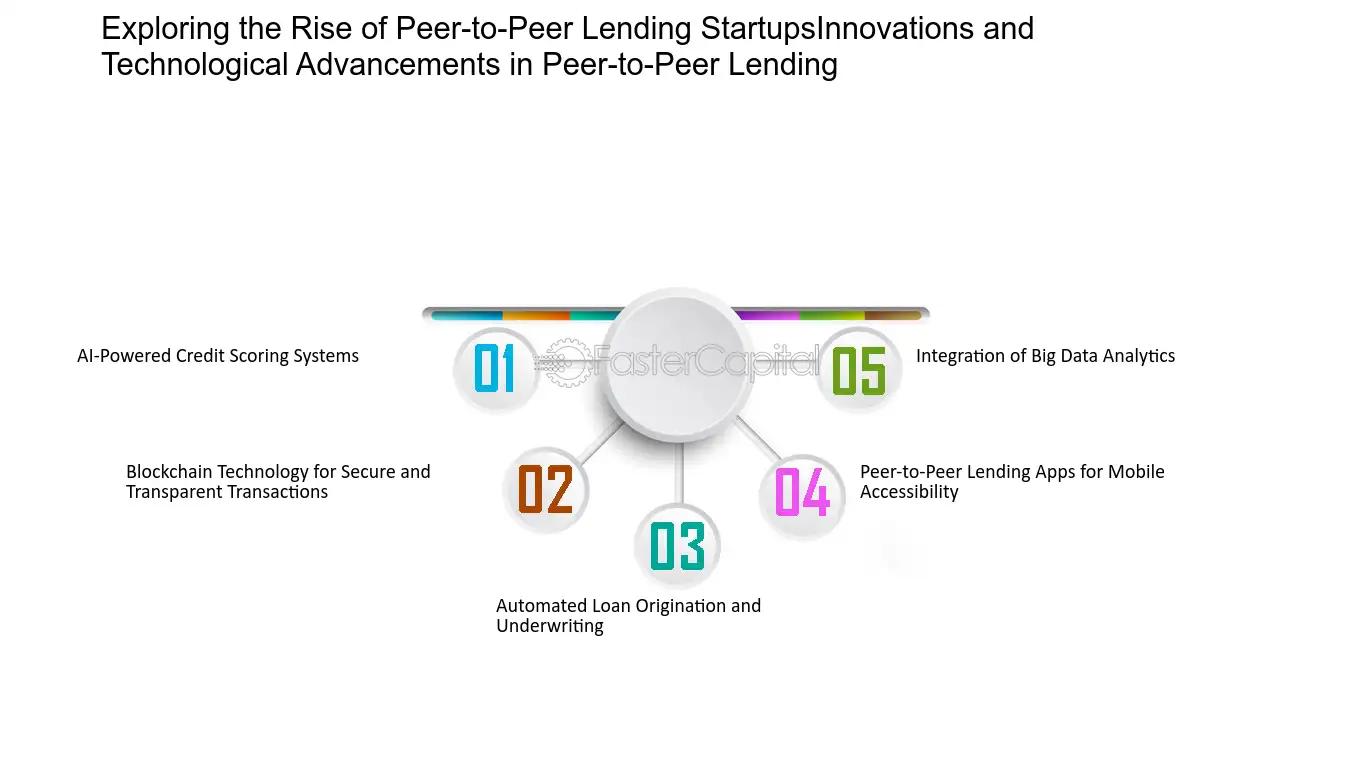
Exploring the Rise of Peer to Peer Lending Startups:Innovations and Technological Advancements in Peer to Peer Lending - Unlocking the Potential: Exploring the Rise of Peer to Peer Lending Startups
45. Exploring the Rise of Peer-to-Peer Lending Startups:Case Studies: Success Stories of Peer-to-Peer Lending Startups
1. LendingClub: Pioneering Peer-to-Peer Lending
LendingClub is often hailed as the pioneer of peer-to-peer lending, and its success story is a testament to the potential of this innovative industry. Founded in 2006, LendingClub quickly gained traction by connecting borrowers with individual investors through an online platform.
One of the key factors behind LendingClub's success is its ability to offer borrowers lower interest rates compared to traditional financial institutions. By cutting out the middleman, LendingClub is able to reduce costs and provide borrowers with more affordable loans. This, in turn, attracts more borrowers to the platform and fuels its growth.
LendingClub's success can also be attributed to its robust risk assessment model. The platform carefully evaluates the creditworthiness of borrowers, taking into account various factors such as credit history, income, and debt-to-income ratio. This thorough assessment helps mitigate the risk of default and ensures that investors have a higher chance of earning attractive returns on their investments.
2. Prosper: Empowering Borrowers and Investors Alike
Another notable success story in the peer-to-peer lending space is Prosper, which was founded in 2005. Similar to LendingClub, Prosper connects borrowers with individual investors and offers competitive interest rates.
One of the key aspects that sets Prosper apart is its focus on empowering borrowers. The platform provides borrowers with the opportunity to take control of their financial situations by offering them access to affordable loans. This has resonated with many borrowers who may have been overlooked or rejected by traditional lenders.
Prosper's success can also be attributed to its commitment to transparency and customer satisfaction. The platform provides borrowers with clear and detailed loan terms, ensuring that they have a complete understanding of the loan agreement. Additionally, Prosper offers excellent customer support, promptly addressing any concerns or issues that borrowers may have.
3. Funding Circle: revolutionizing Small business Lending
While peer-to-peer lending is primarily associated with personal loans, Funding Circle has successfully carved out a niche in the small business lending space. Founded in 2010, Funding Circle connects small businesses in need of financing with individual and institutional investors.
One of the reasons behind Funding Circle's success is its ability to provide fast and flexible financing solutions to small businesses. The platform streamlines the loan application process, allowing small businesses to access funds quickly. This has been a game-changer for many entrepreneurs who often struggle to secure financing from traditional banks due to stringent requirements.
Funding Circle's success can also be attributed to its strong focus on risk management. The platform employs rigorous underwriting processes to assess the creditworthiness of small businesses, which helps mitigate the risk of default for investors. This approach has attracted a wide range of investors, including institutional players looking for alternative investment opportunities.
Conclusion:
These case studies highlight the success stories of peer-to-peer lending startups such as LendingClub, Prosper, and Funding Circle. These companies have not only disrupted the traditional lending landscape but have also provided borrowers with more affordable and accessible financing options. Through their innovative platforms and robust risk management strategies, these startups have demonstrated the immense potential of peer-to-peer lending in empowering both borrowers and investors alike. As the industry continues to grow, it will be exciting to witness the emergence of more success stories in the peer-to-peer lending space.
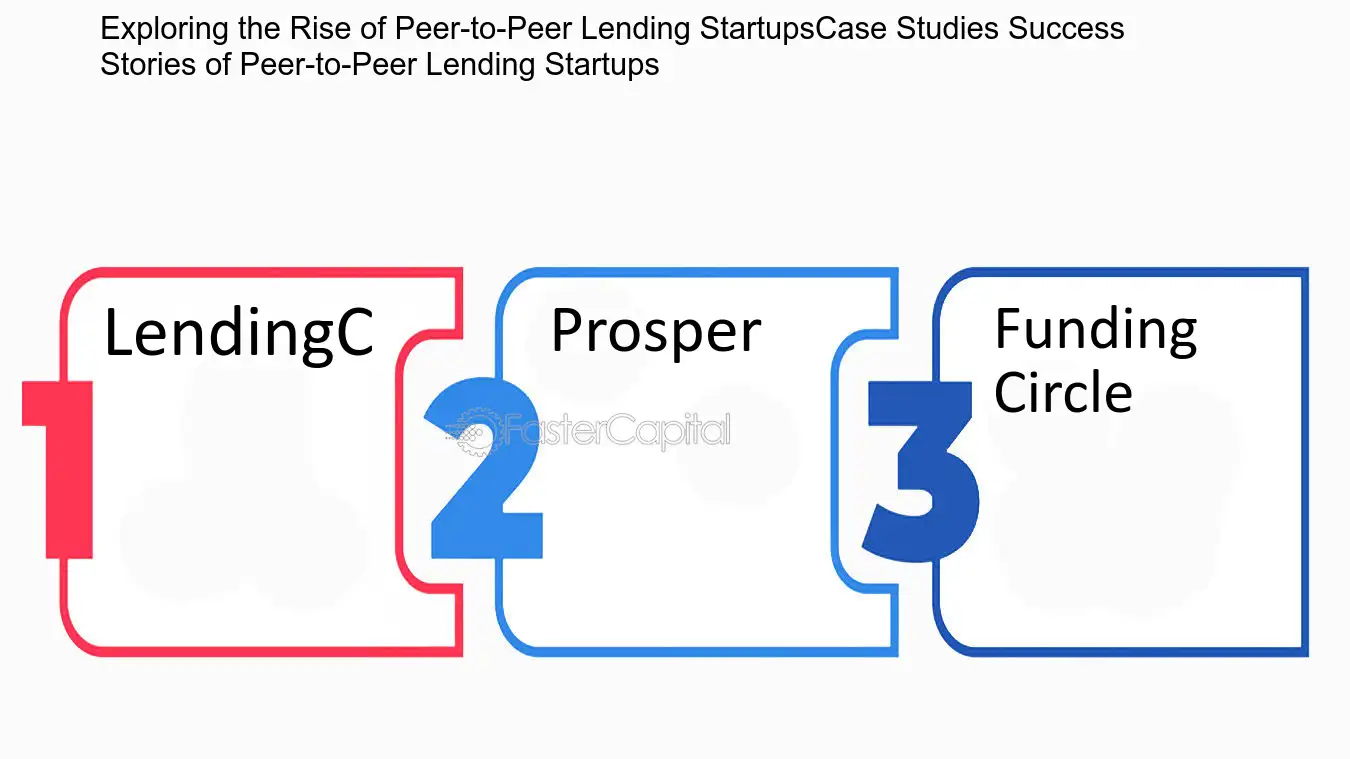
Exploring the Rise of Peer to Peer Lending Startups:Case Studies: Success Stories of Peer to Peer Lending Startups - Unlocking the Potential: Exploring the Rise of Peer to Peer Lending Startups
46. Exploring the Rise of Peer-to-Peer Lending Startups:Future Outlook: Opportunities and Trends in Peer-to-Peer Lending
1. Increasing Acceptance and Adoption of P2P Lending Platforms
In recent years, peer-to-peer (P2P) lending has gained significant traction as an alternative form of financing. As traditional lending institutions became more stringent in their lending criteria, P2P lending platforms emerged as a viable solution for borrowers seeking quick and hassle-free access to funds. This trend is expected to continue in the future, with an increasing number of borrowers and investors turning to P2P lending platforms.
For example, platforms like LendingClub and Prosper have already facilitated billions of dollars in loans, showcasing the growing acceptance and trust in P2P lending. Additionally, the rise of P2P lending in developing countries, such as China and India, presents immense opportunities for further growth and expansion in the industry.
2. Enhanced Regulatory Frameworks for P2P Lending
As the P2P lending industry continues to flourish, regulators worldwide are taking note and implementing frameworks to ensure consumer protection and mitigate risks. These regulations aim to create a level playing field for both borrowers and investors, fostering trust and stability in the P2P lending ecosystem.
For instance, in the United States, the Securities and Exchange Commission (SEC) has introduced regulations to govern P2P lending platforms, requiring them to register as securities offerings. Similarly, in the United Kingdom, the Financial Conduct Authority (FCA) has established stringent guidelines for P2P lending platforms to safeguard investor interests and prevent fraudulent activities.
3. Integration of Artificial Intelligence and Big Data Analytics
As technology continues to evolve, P2P lending platforms are increasingly harnessing the power of artificial intelligence (AI) and big data analytics to enhance their services. These technologies enable platforms to assess creditworthiness, automate loan underwriting processes, and improve risk management, ultimately benefiting both borrowers and lenders.
For example, platforms like Zopa and Upstart leverage AI algorithms to analyze vast amounts of data, including credit scores, employment history, and social media profiles, to determine a borrower's creditworthiness. This not only speeds up the loan approval process but also enables more accurate risk assessment, reducing default rates and increasing investor confidence.
4. Expansion into Niche Markets and Specialized Lending
While P2P lending initially gained popularity in the consumer lending space, there is a growing trend towards niche markets and specialized lending. P2P lending platforms are increasingly catering to the unique needs of borrowers in specific sectors, such as small business loans, real estate financing, and student loans.
For instance, platforms like Funding Circle and OnDeck specialize in providing loans to small businesses, enabling them to access capital quickly and efficiently. Similarly, platforms like Roofstock and PeerStreet focus on real estate lending, allowing investors to diversify their portfolios by investing in real estate-backed loans.
5. global Expansion and Cross-border Lending Opportunities
As P2P lending continues to gain momentum, platforms are exploring opportunities for global expansion and cross-border lending. This trend opens up new avenues for investors to diversify their portfolios and borrowers to access funding from international sources.
For example, platforms like Mintos and Bondora operate across multiple countries, allowing investors to fund loans in various currencies and jurisdictions. This not only increases investment options but also enables borrowers to tap into a broader pool of lenders, potentially securing more favorable loan terms.
In conclusion, the future outlook for P2P lending is promising, with opportunities for growth, enhanced regulations, integration of advanced technologies, niche market expansion, and global expansion. As the industry continues to evolve, P2P lending will undoubtedly play a significant role in revolutionizing the way individuals and businesses access financing.
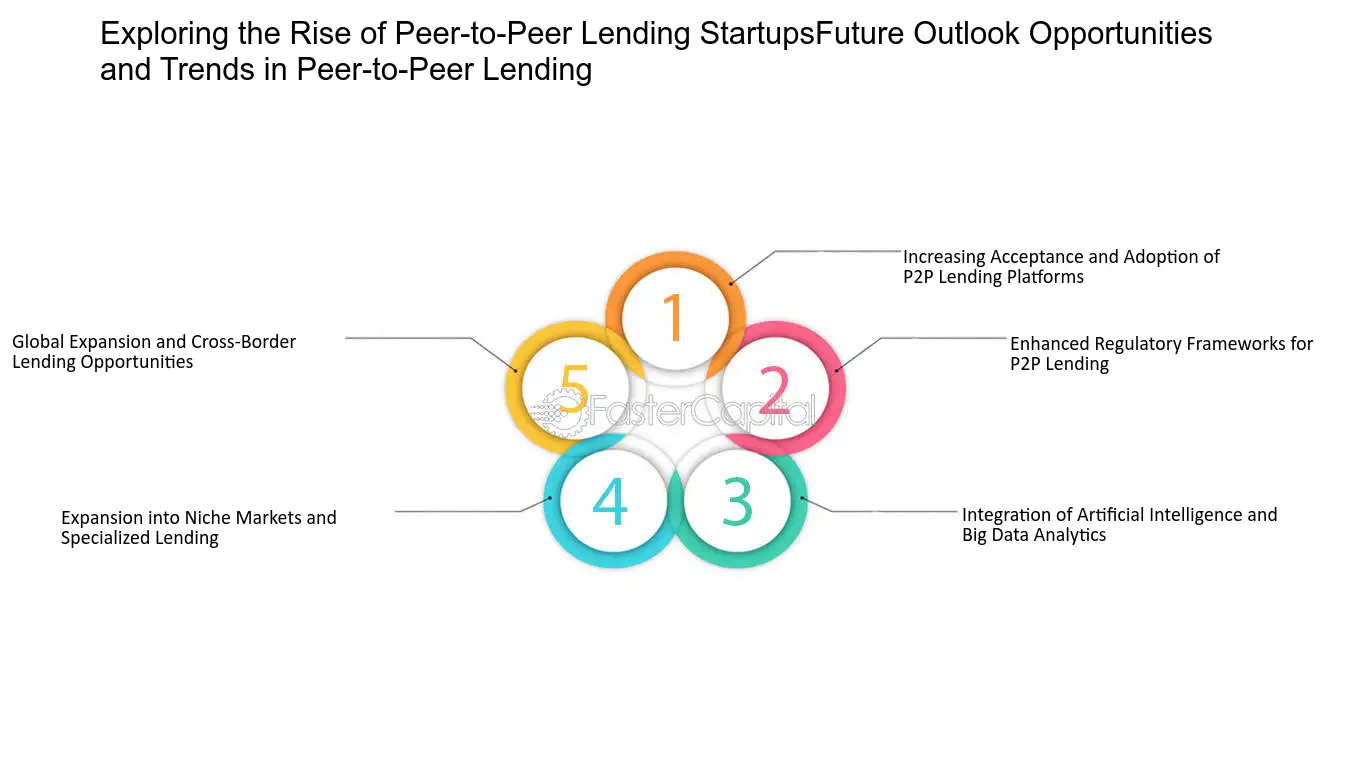
Exploring the Rise of Peer to Peer Lending Startups:Future Outlook: Opportunities and Trends in Peer to Peer Lending - Unlocking the Potential: Exploring the Rise of Peer to Peer Lending Startups